Early Los Angeles Street Lights
| Historical Street Lights of Los Angeles |
.jpg) |
|
| (2005)^* - View showing a dual-lamp teardrop electrolier on 1st Street near Spring Street, in front of the LA Times Building. Photo by Jim Winstead |
Historical Notes The street light seen above is dubbed the "CD 913"; the shaft and arms dating from 1948. Not seen here is the base, reused from the Keystone "Broadway Rose" of late 1919. The "Roses" were dedicated in January, 1920. The luminaires are an early 21st Century modification, bringing back the look of the GE Form 81 teardrops that were part of the 1948 installation. This is the Los Angeles Times's fourth building since it started publishing in 1881. Click HERE to see views of the earlier LA Times buildings. |
Dual-Lamp Teardrop CD-913 Electroliers (Contemporary Views)
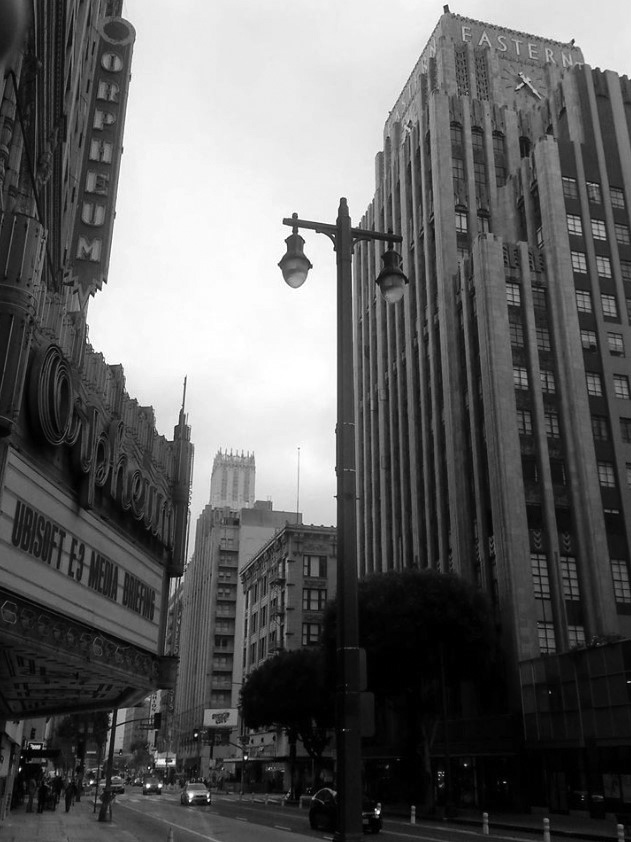 |
|
| (2019)^.^ - View looking south on Broadway showing three iconic buildings: The Orpheum, The Eastern, and The Ace, with a beautiful dual-lamp teardrop streetlight (CD-913) seen in the foreground. Photo courtesy of Michael Rotman |
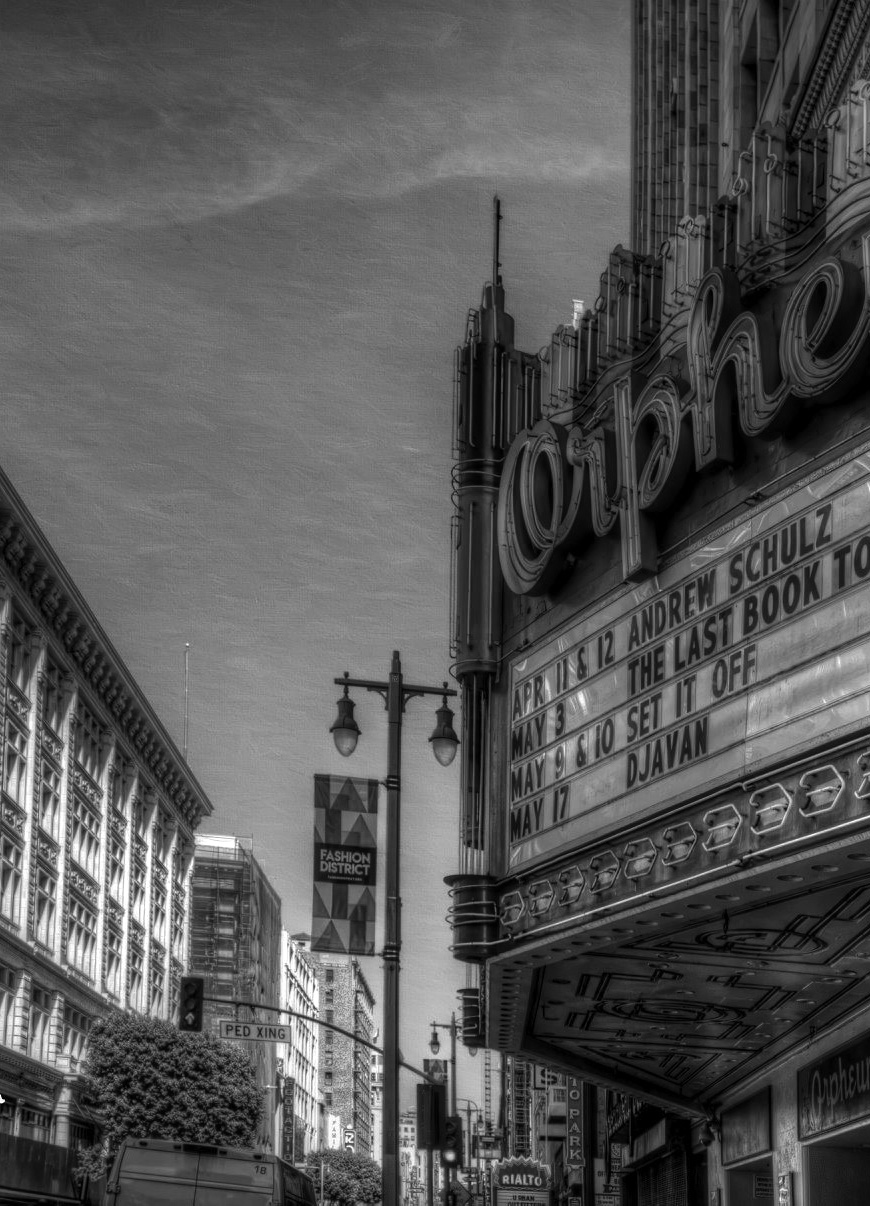 |
|
| (2020)^.^ - View looking north on Broadway toward 8th Street showing a two lamp teardrop streetlight standing near the Orpheum Theatre. Photo by Jill Feldman McMahon |
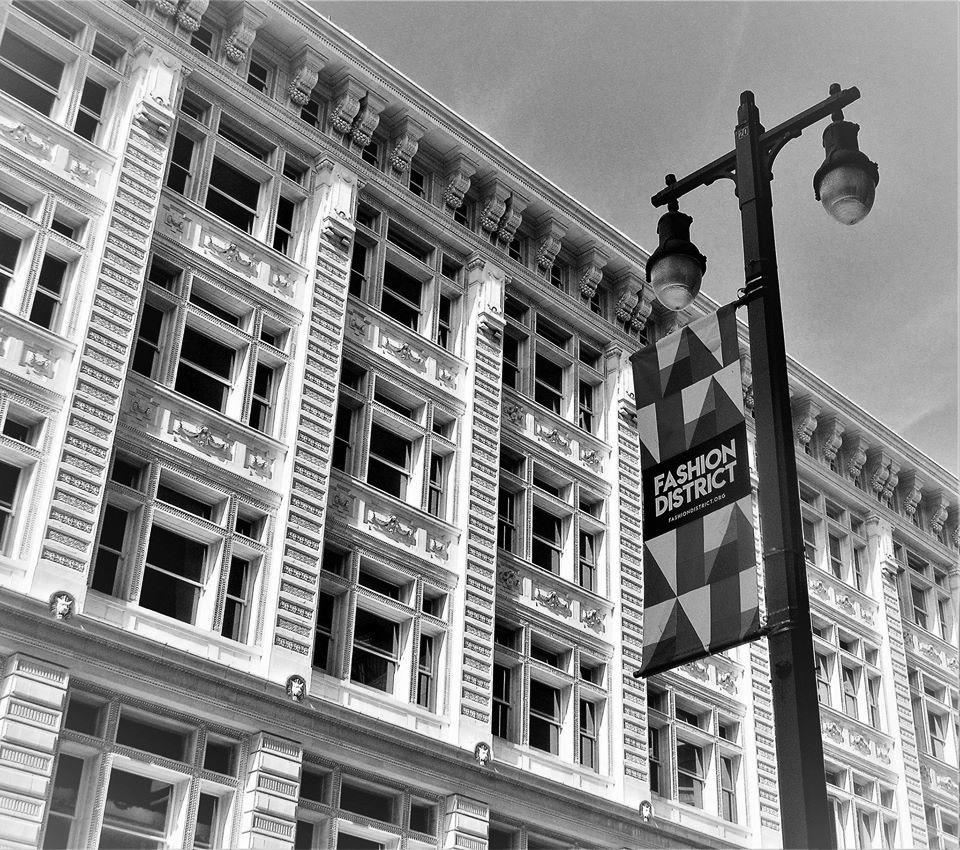 |
|
| (2020)^.^ – View looking up at the newly renovated California Broadway Trade Center (801 S. Broadway) with an ornate dual-pendant teardrop-shaped streetlight (CD-913) seen in the foreground. Photo by Howard Gray |
Historical Notes The 1908-built Beaux Arts building seen above was built in 1908. It was originally home to Hamburger’s Department Store which evolved into May Company and later Macy's. Click HERE to see more. |
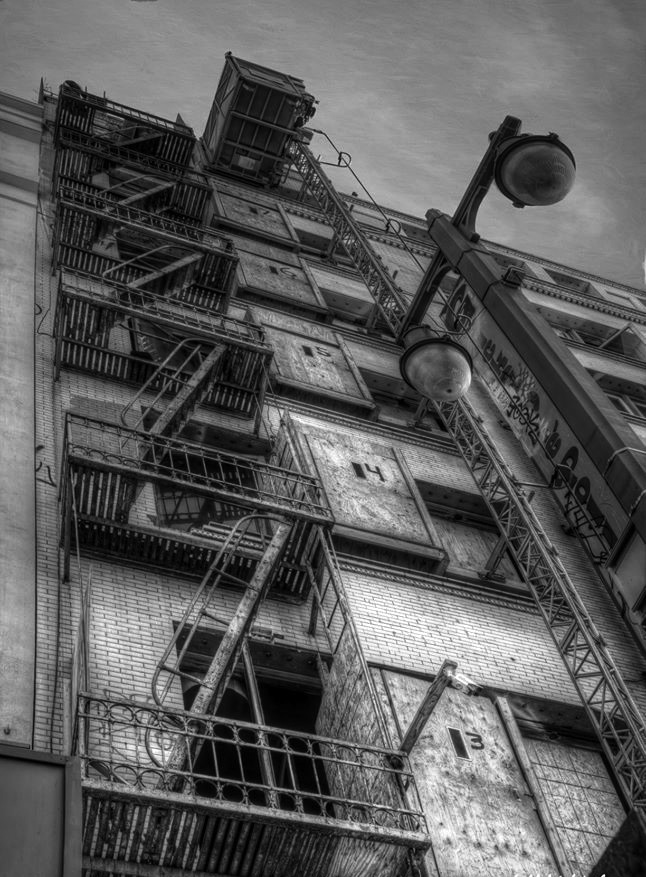 |
|
| (2020)^.^ – Looking up toward a dual lamp teardrop electrolier standing in front of a building under renovation. Note the fire escape and outdoor elevator in background. Photo by Jill Feldman McMahon |
.jpg) |
|
| (2021)* - Close-up view showing a CD-913 dual-lamp electrolier located in front of Grand Central Market (repainted Golden Brown except for the photo cells). Photo by Glen Norman |
* * * * * |
Olympic Special
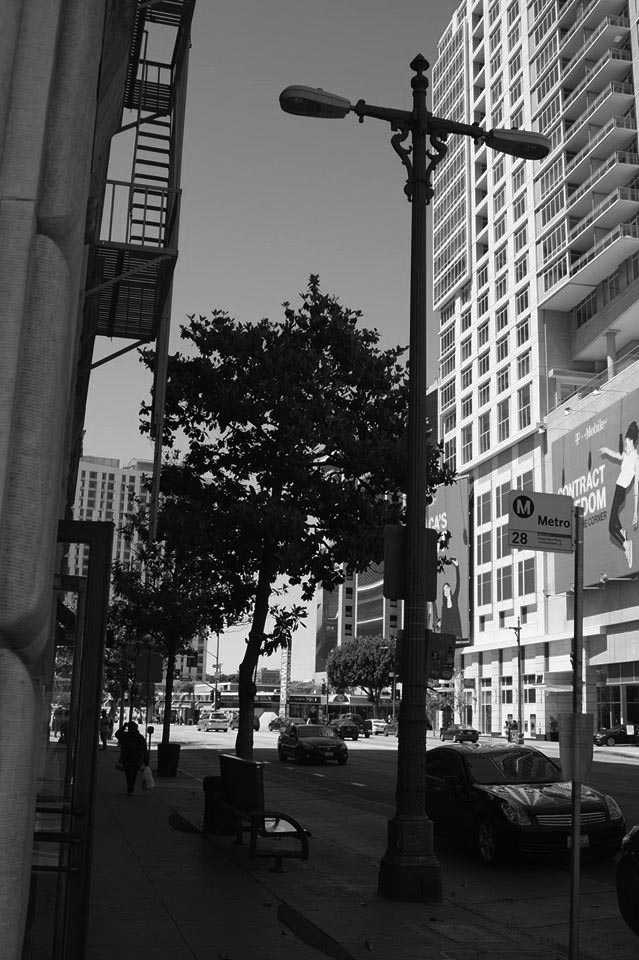 |
|
| (2016)### - View showing a twin Cobra electrolier, sometimes referred to as Olympic Special, located on Olympic Boulevard in downtown Los Angeles. Photo courtesy of Glen Norman |
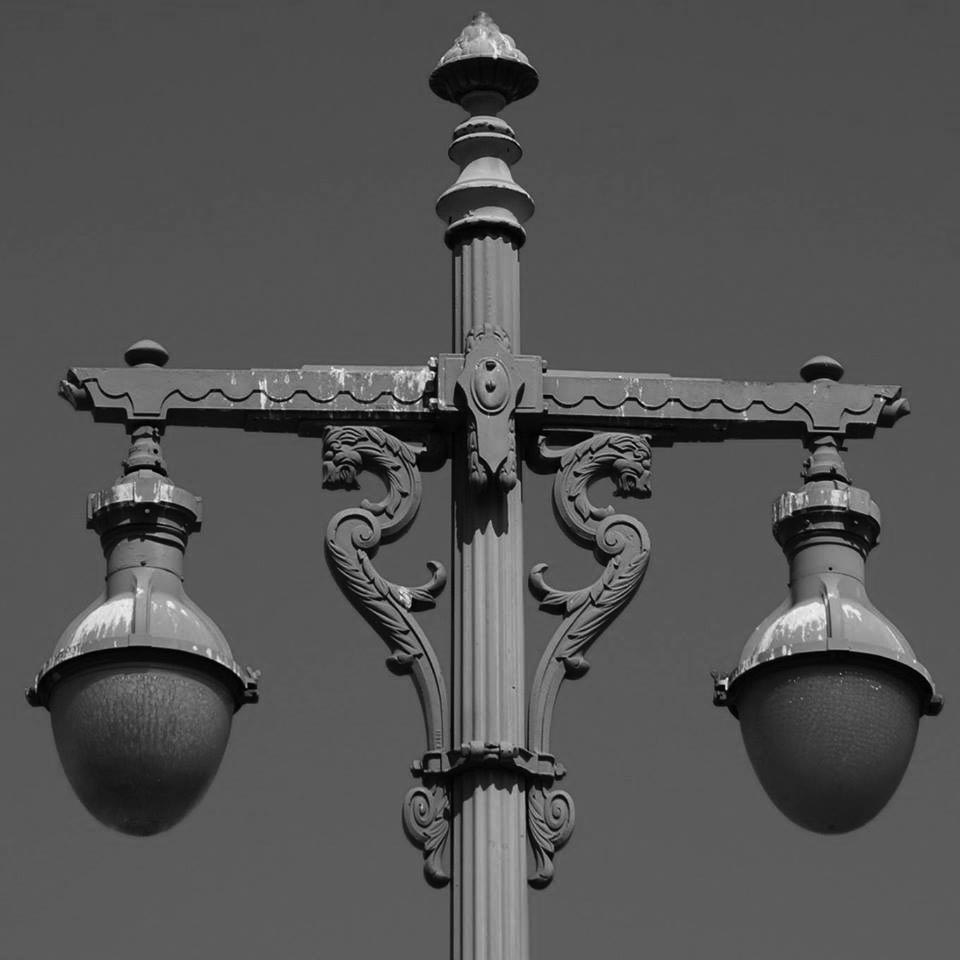 |
|
| (2015)### - View showing the only extant twin Olympic Special with the original GE Form 81-D (Ornate) teardrops. Located at the Vermonica Exhibit, Vermont Avenue and Santa Monica Boulevard in Eastern Hollywood. Photo by Glen Norman |
Historical Notes The Vermonica Exhibit is a display of 25 vintage streetlights of Los Angeles that was erected in 1992 as an artwork sponsored by the Department of Cultural Affairs and voluntary labor contributed significantly by staff of the Field Operations Division of the Bureau of Street Lighting. The artist was Sheila Kline and the artwork was named 'Vermonica' for its location adjacent to the intersection of Vermont Avenue and Santa Monica Boulevard. In 2020 the exhibit was moved further West on Santa Monica Boulevard. |
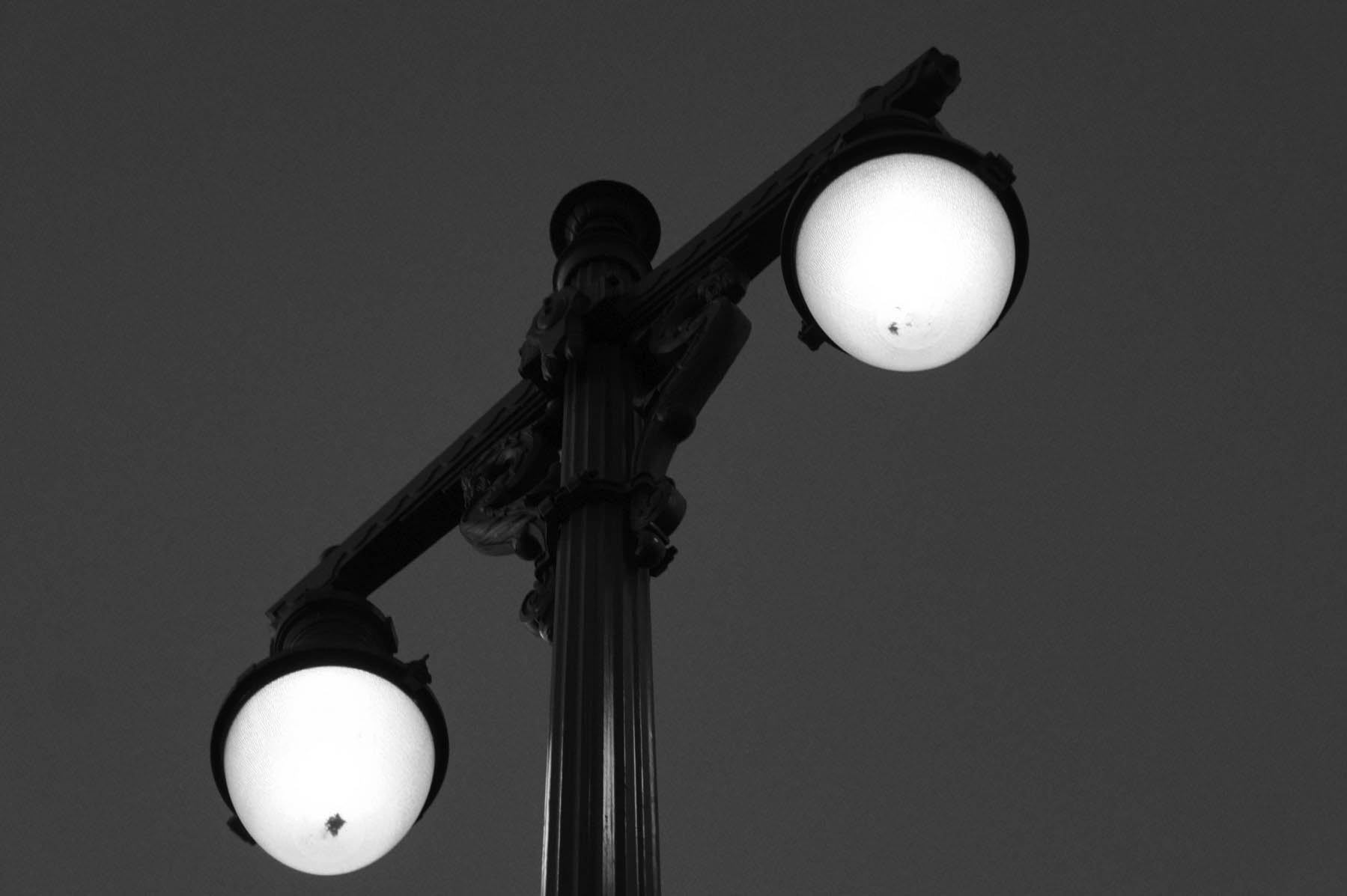 |
|
| (2020)* – Night view of the Olympic Special Twin located at the Vermonica Streetlight Exhibit on Santa Monica Boulevard in East Hollywood. Photo by Glen Norman |
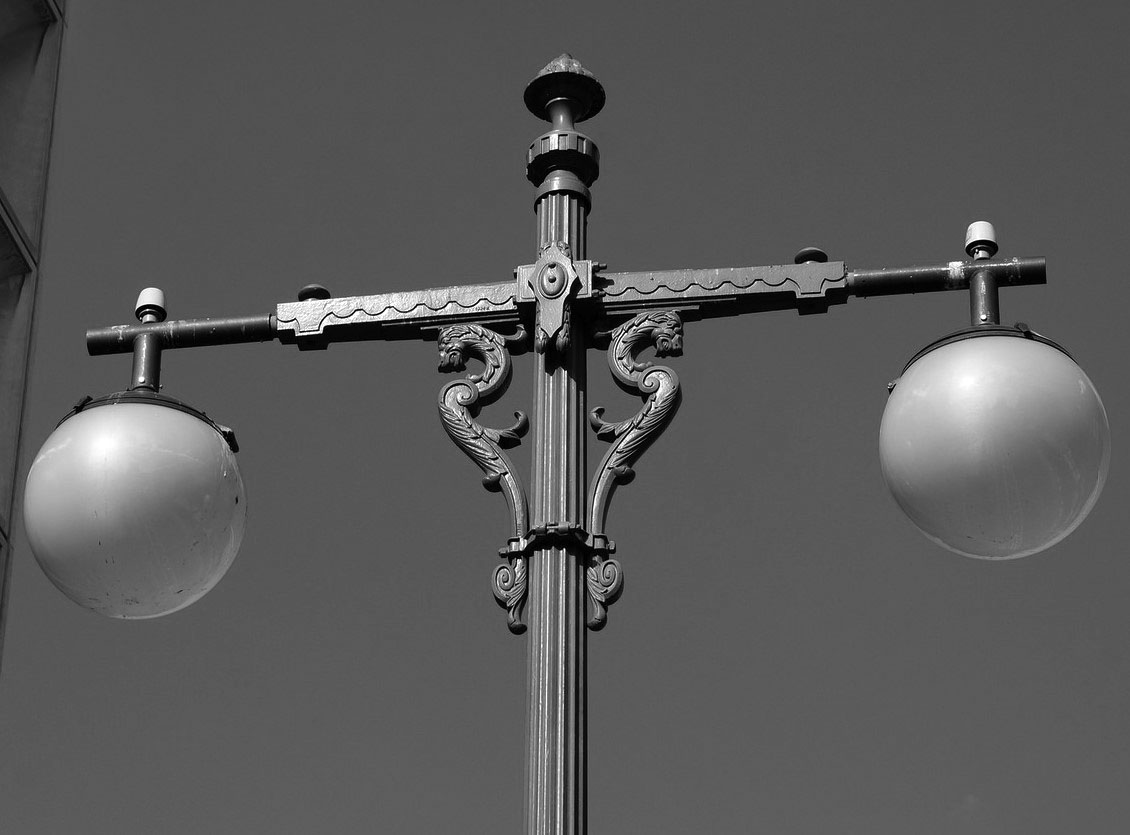 |
|
| (2017)^^* – Close-up view of a dragon-armed, dual-lamp Olympic Special located on the west side of Los Angeles Street, adjacent to City Hall East. The formerly clear globes have recently been replaced with opaque balls, lamped with LED. |
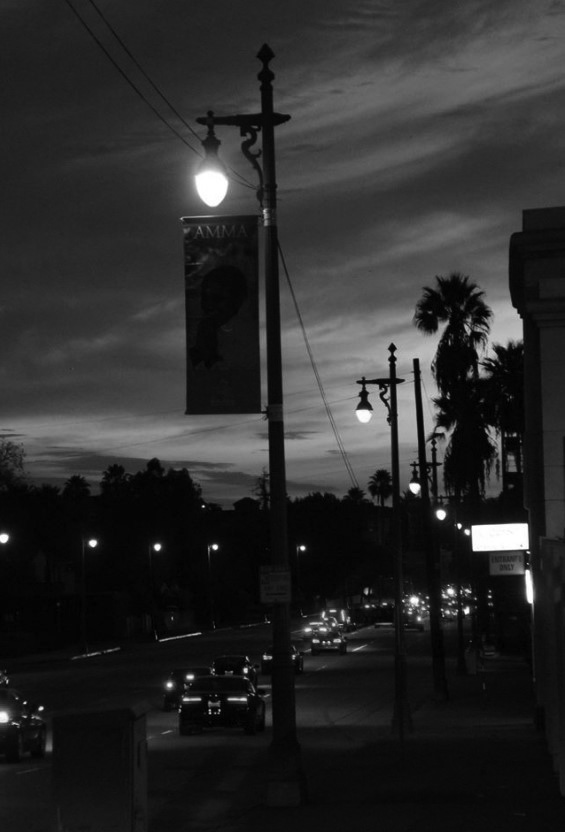 |
|
| (2019)^.^ - The dragon-armed Olympic Specials (UM 40314) watch as rush hour traffic passes in review. Looking West on Olympic Boulevard, just West of Century City. — at Rancho Park, Los Angeles. Photo by Glen Norman |
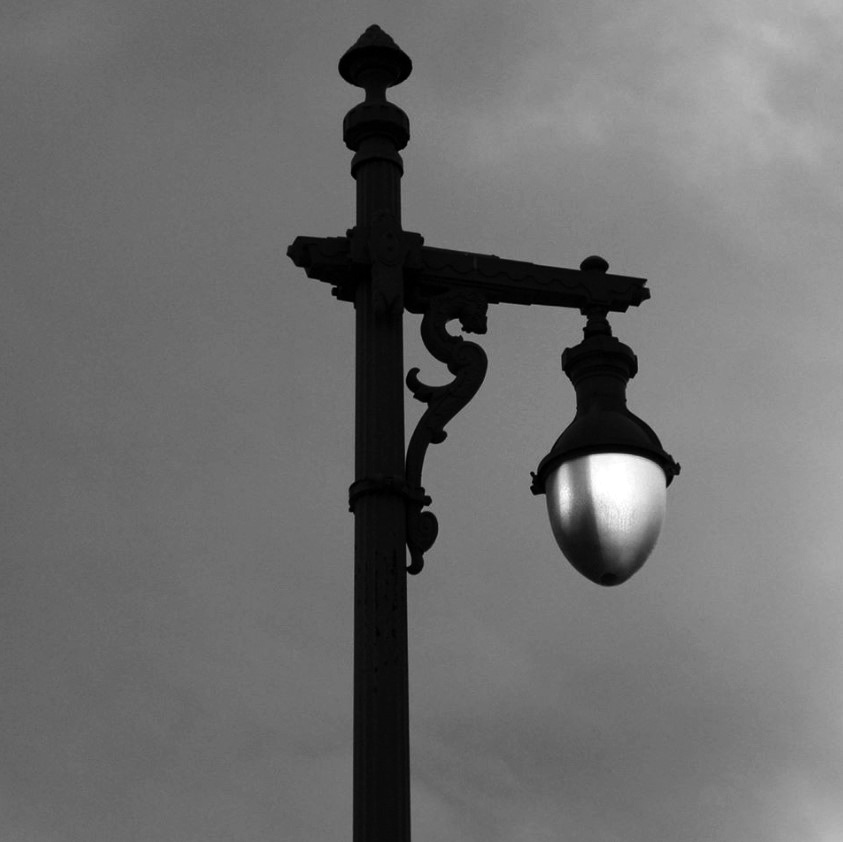 |
|
| (2019)^.^ - Close-up view of a Mercury-lamped single arm Olympic Special just coming on for the evening. South side of Olympic Blvd. West of Century City in Rancho Park, Los Angeles. Photo courtesy of Glen Norman |
* * * * * |
CD 923's
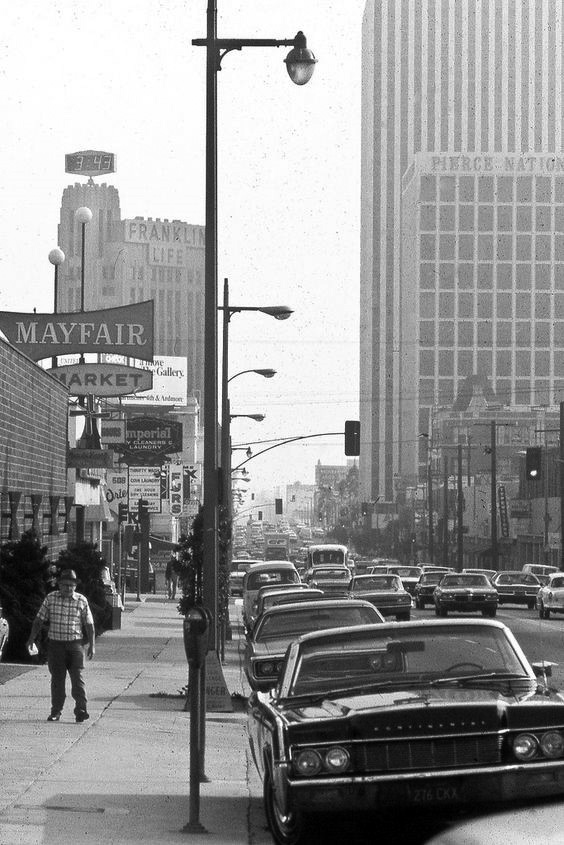 |
|
| (1970s)^.^ – View looking south on Western Avenue toward Wilshire Boulevard where the Pellissier Building (Franklin Life sign) stands on the SE corner. Mostly CD 943 streetlights are seen on the east side of Western. At least three different styles of streetlights can be seen here. Photo courtesy of Jessica Litman |
Historical Notes The CD 923 street light closest to the camera displays the original luminaire--an Incandescent teardrop. The CD 923 behind it has received a Mercury cobra upgrade. The intersection behind it received an upgraded traffic light with a mast-arm suspended over Western Avenue. It was standard operating practice to update a few of the existing street lights closest to the intersection at the same time the new traffic signals went in. The CD 923 street lights were sometimes referred to as the "Llewellyn Slayers." They are responsible for annihilating the entire run of the eponymous Llewellyn "Pico" cluster lights between Main Street and Vermont Avenue. Other Llewellyn clusters along Figueroa Street (downtown) and Main Street (between Downtown and Jefferson Boulevard) also fell to the advancing CD 923 posts. The Llewellyn "Western" twins on Western Avenue were replaced by the CD 923 posts North of Wilshire Boulevard. I'm not sure how far North the CD 923s extended on Western (definitely not as far as Melrose as documented in the 1969 film "Model Shop"), but those CD 923s were removed in the early 1970s along with the surviving Llewellyn "Western" twins. The CD 923 posts did not limit their wrath exclusively to Llewellyn product. The entire run of Marbelite twins on Wilshire Boulevard between Fairfax Avenue and the Beverly Hills city limits was also replaced by the CD 923 in the late 1940s. None of the surviving CD 923s sport the original side-mounted Incandescent teardrops. But, the run on Main Street between Downtown and Jefferson Boulevard received faux-historic Lumec RN 20 teardrops in the early 2000s. - Glen Norman |
* * * * * |
'Pacific' Dual Lamp Streetlight (UM-1747)
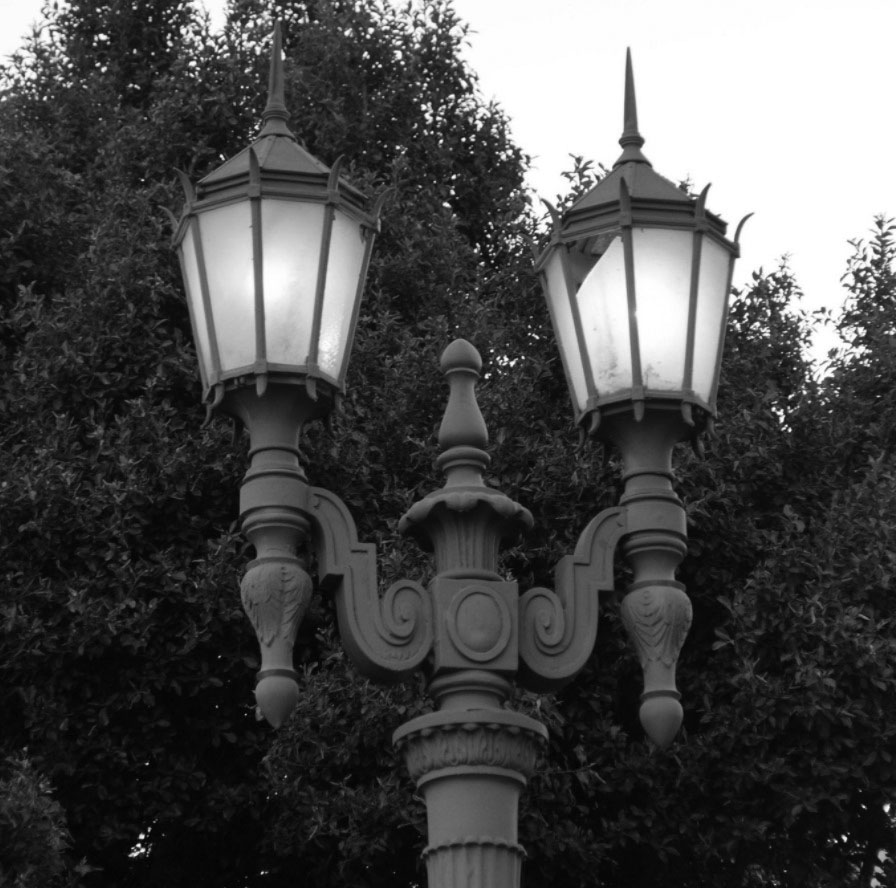 |
|
| (2020)^ - A Union Metal (UM 1747) 'Pacific' streetlight with twin GE Form 18-B Novalux lanterns with broken glass pane, located on the south side of West 7th Street between South New Hampshire and South Vermont avenues. Photo by Glen Norman |
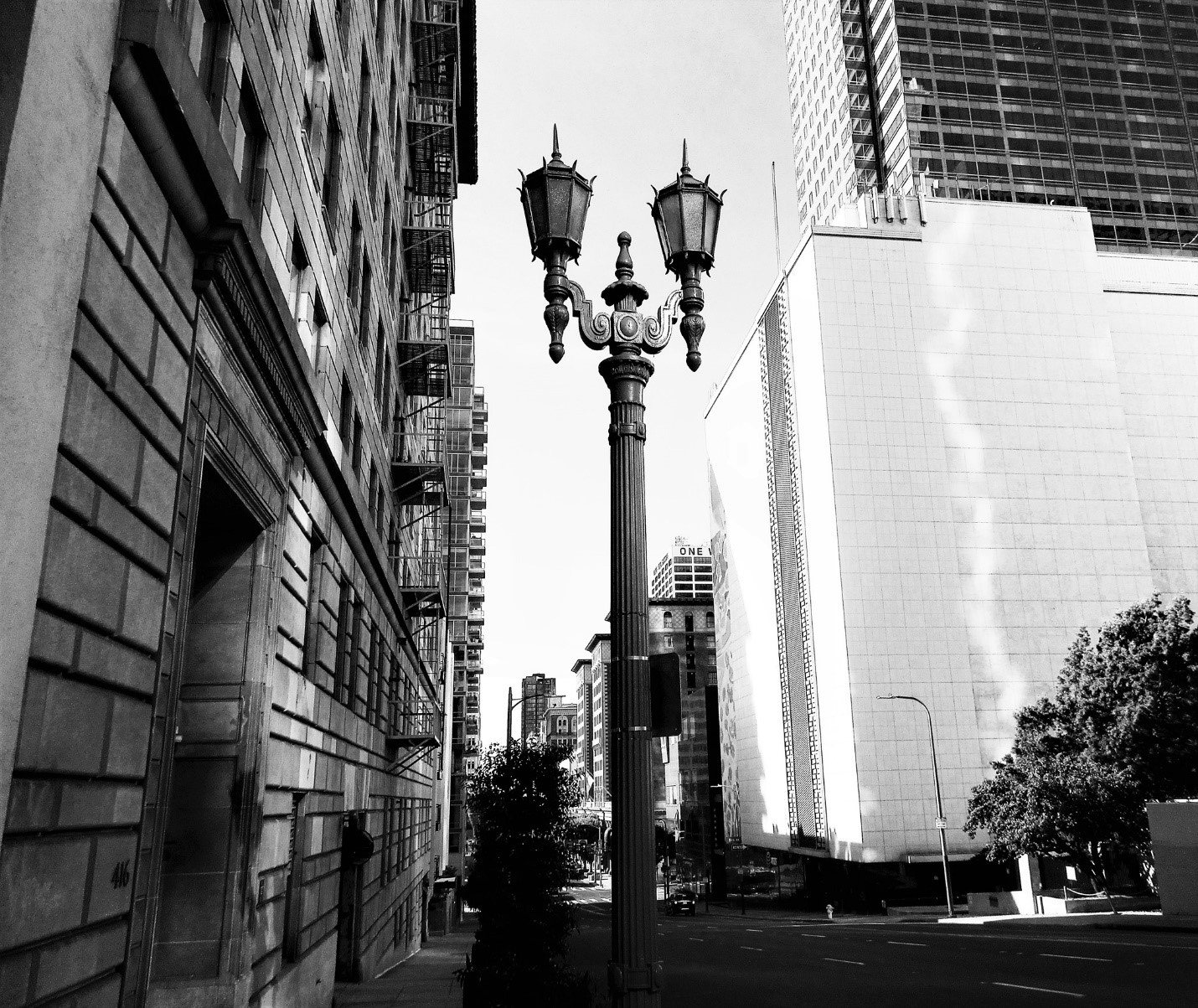 |
|
| (2021)* – One of the last remaining Pacific (UM-1747) Streetlights located on Olive just south of 4th Street with the AT&T Building seen on the right. Photo by Howard Gray |
Historical Notes Click HERE to see more Early Views of Pacific Dual-Lamp UM-1747 Streetlights. |
* * * * * |
California Special (aka Magnolia Double)
.jpg) |
|
| (2019)* - A dual-lamp California Special streetlight stands in front of the El Portal Theatre marquee, 5269 Lankershim Boulevard, North Hollywood. Photo courtesy of Shellie Winkler |
Historical Notes There are eight of these California Special streetlights located around the El Portal Theatre in North Hollywood, four on Lankershim and the other four around the corner on Weddington. These are 21st Century transplants. The California Special was never found on either of those two thoroughfares. |
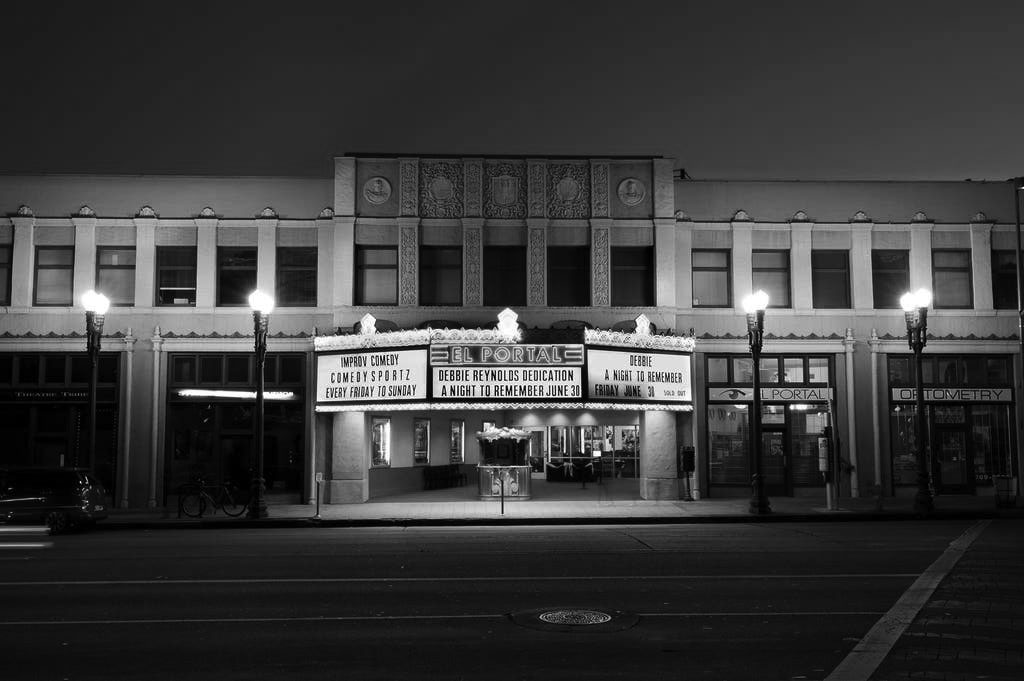 |
|
| (2021)* - Four 'California Special" streetlights stand tall in front of the El Portal Theatre in North Hollywood. Photo courtesy of El Portal Theatre |
Historical Notes The “California Special” was designed by Westinghouse, but produced locally by Llewellyn Iron Works. Chris Burden dubbed these "The Magnolia Double" for his Urban Light sculpture down on Wilshire Blvd. Today, there are still plenty of these to be found on the Magnolia Boulevard between Lankershim and Cahuenga. They were previously found in Leimert Park. Single lamp versions use to line Burbank and Magnolia Blvds. in Burbank, but those are all gone, too. |
* * * * * |
Carroll Ave
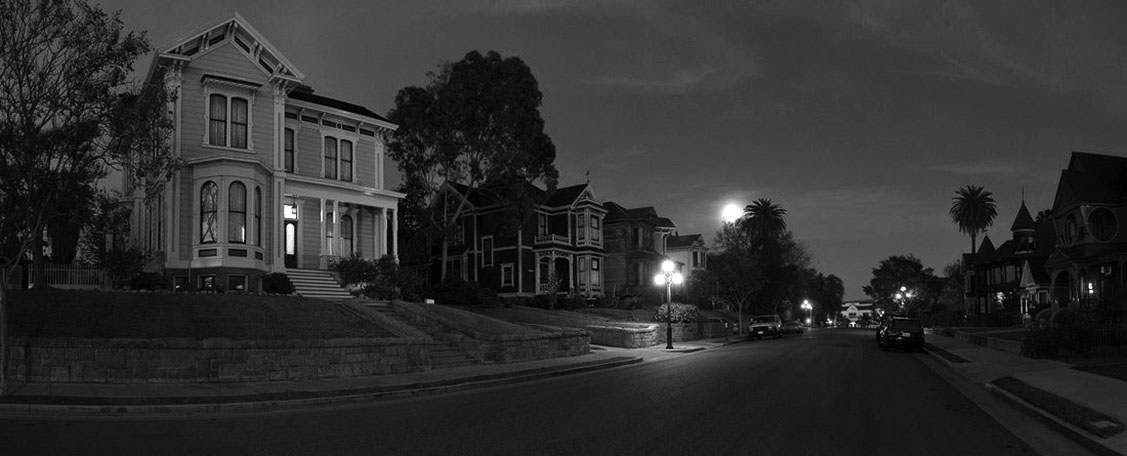 |
|
| (2010s)* – Nighttime view showing the two block section of Carroll Avenue. It has the highest concentration of Victorian Era residences in the City of Los Angeles. Photo courtesy of skyminor |
Historical Notes Carroll Avenue is a two block long street with an international reputation for restored Victorian homes (1880 – 1910). Three, four and five globe authentic fixtures taken from various locations in the City and which date from that era now grace both sides of Carroll Avenue. |
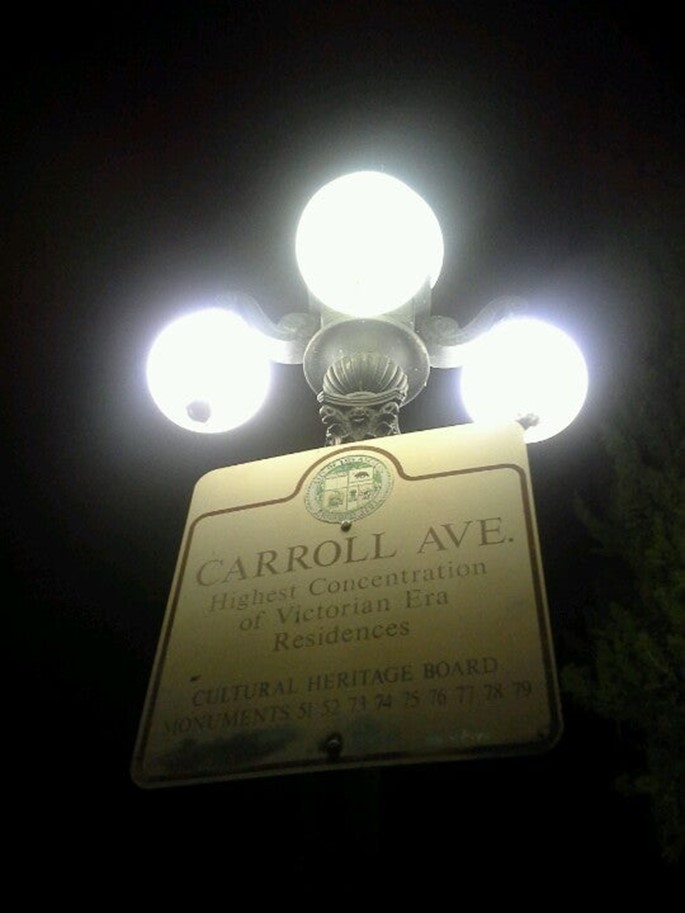 |
|
| (2019)* – Nighttime view showing a five globe streetlight located on the northwest corner of Carroll Avenue and E. Edgeware Rd. Sign reads: Carroll Ave – Highest Concentration of Victorian Era Residences. Photo courtesy of Krystle at Caroll Avenue |
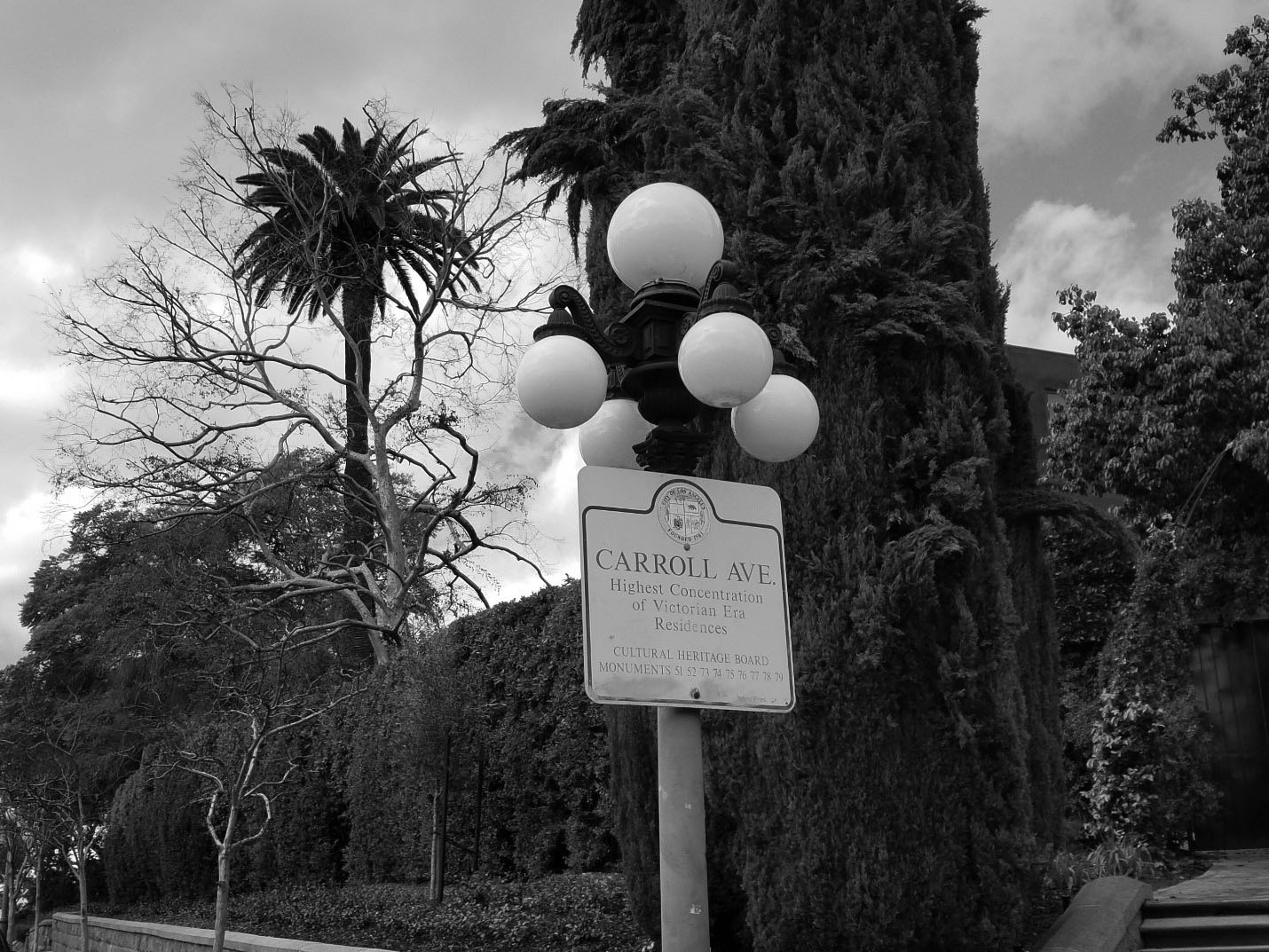 |
|
| (2019)* – Daytime view of the same five globe streetlight located on the northwest corner of Carroll Avenue and E. Edgeware Rd. Sign reads: Carroll Ave – Highest Concentration of Victorian Era Residences. Photo by Jack Feldman |
 |
|
| (2019)* – An ornate 3-globe streetlight stands tall on the north side of Carroll Avenue near Edgeware Road. Photo by Jack Feldman |
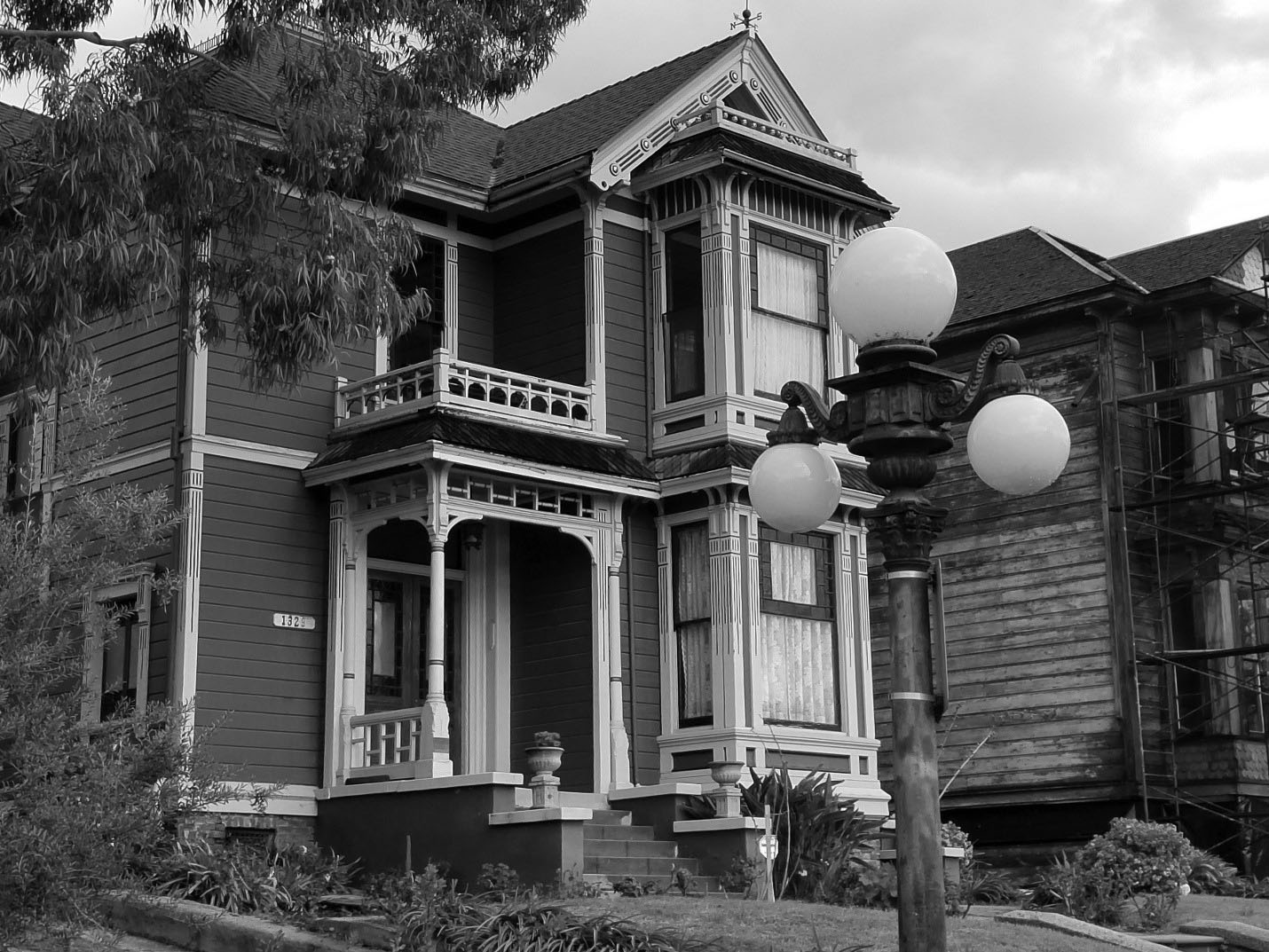 |
|
| (2019)* – Close-up view of the 3-globe ornate streetlight in front of a Victorian home on Carroll Ave. Photo by Jack Feldman |
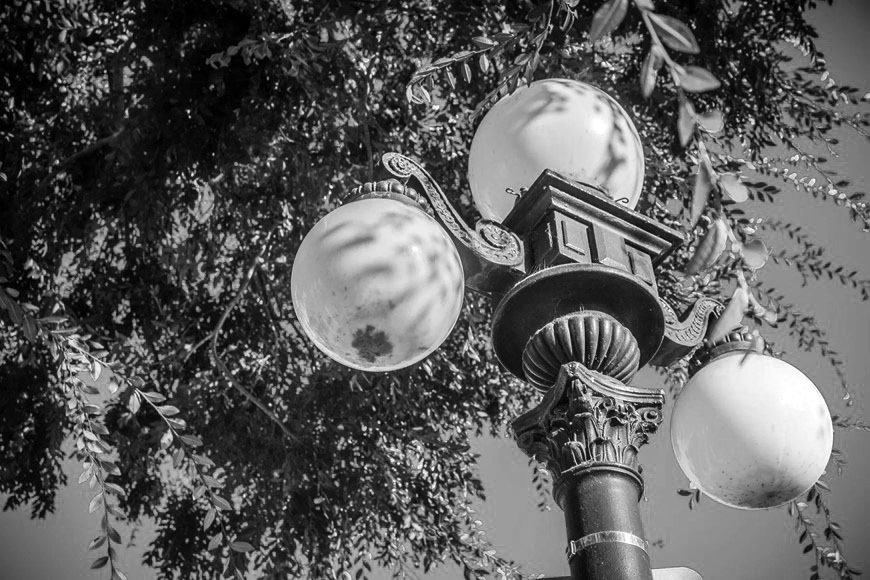 |
|
| (2017)* - Three-lamp ornate streetlight in front of the 1887-built Irey House at 1325 Carroll Avenue. Photo courtesy of Star Foreman / LA Weekly |
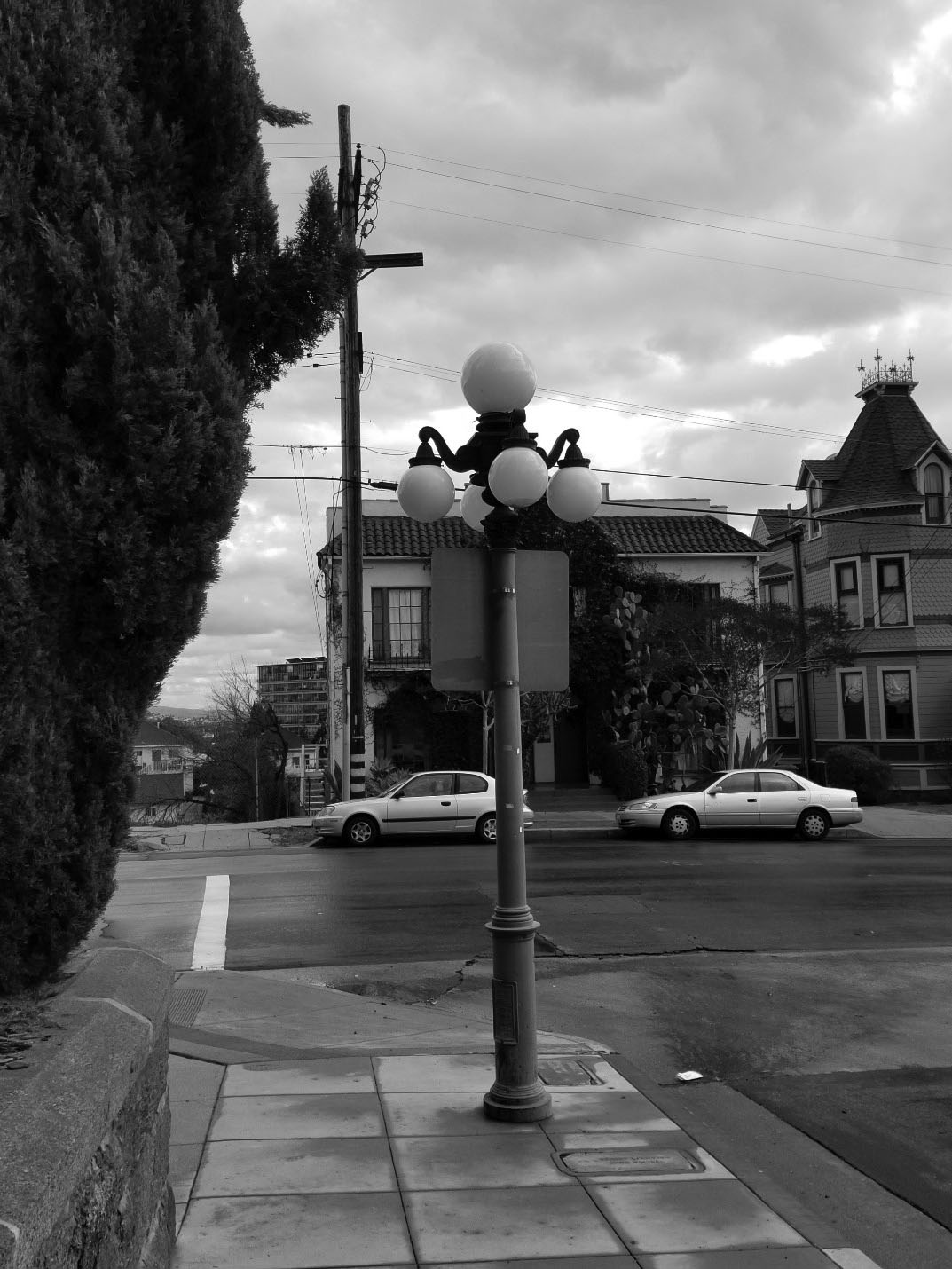 |
|
| (2019)* – View looking east on Carroll Avenue toward E. Edgeware Road showing a renovated 5-globe streetlight on the corner. Photo by Jack Feldman |
Historical Notes The entire 1300 block of Carroll Avenue was listed under the National Register of Historic Places in 1976. |
Pacific Palisades
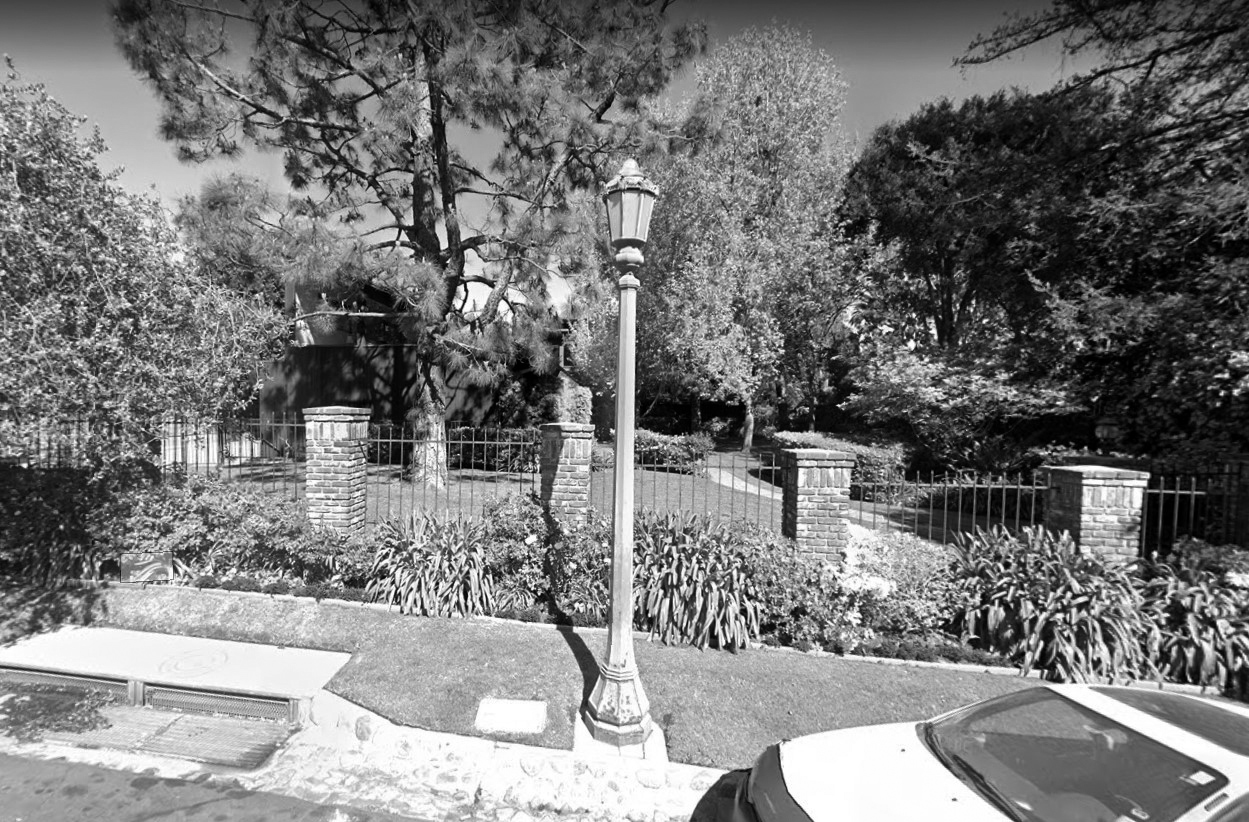 |
|
| (2019)^^ – Google street view showing ornate single-lamp electrolier located on 1500 block of N. San Remo Drive in Pacific Palisades. Similar to the Metropolitan Streetlight Standard. |
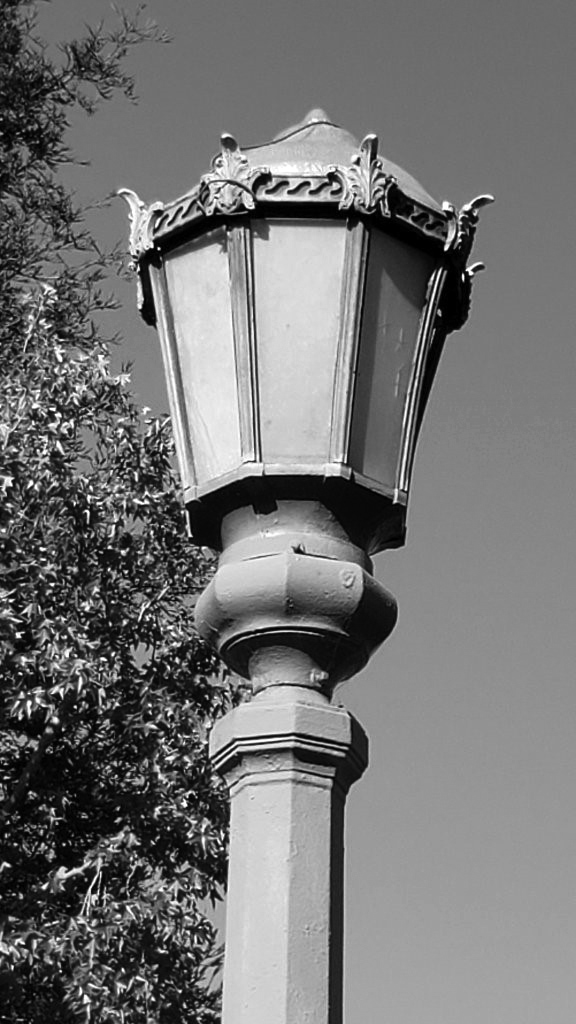 |
|
| (2019) - Close-up detail view showing the single-lamp electrolier seen in the previous photo, San Remo Road, Pacific Palisades. Looks somewhat like a Metropolitan Streetlight Standard but without the spear tip on top. Photo courtesy of Lia Oganesyan |
Melrose Hill Special
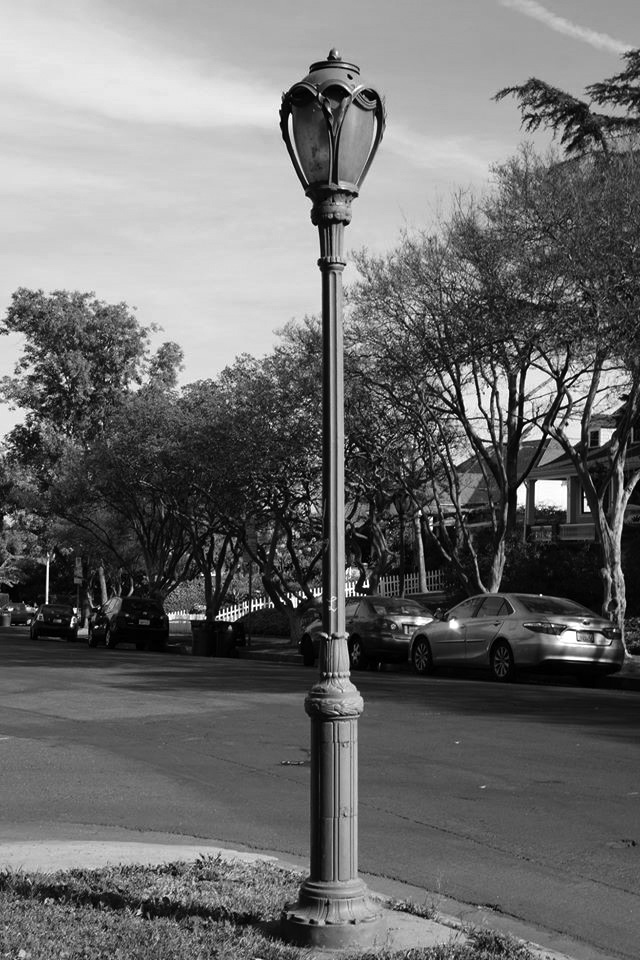 |
|
| (2020)^.^ - View showing a “Melrose Hill Special’ electrolier located in East Hollywood. Photo by Glen Norman |
Historical Notes The "Melrose Hill Specials" can be found along three streets: Marathon Street, Melrose Hill, and an intersecting street also called Melrose Hill. This one is on the corner of Marathon and Melrose Hill. |
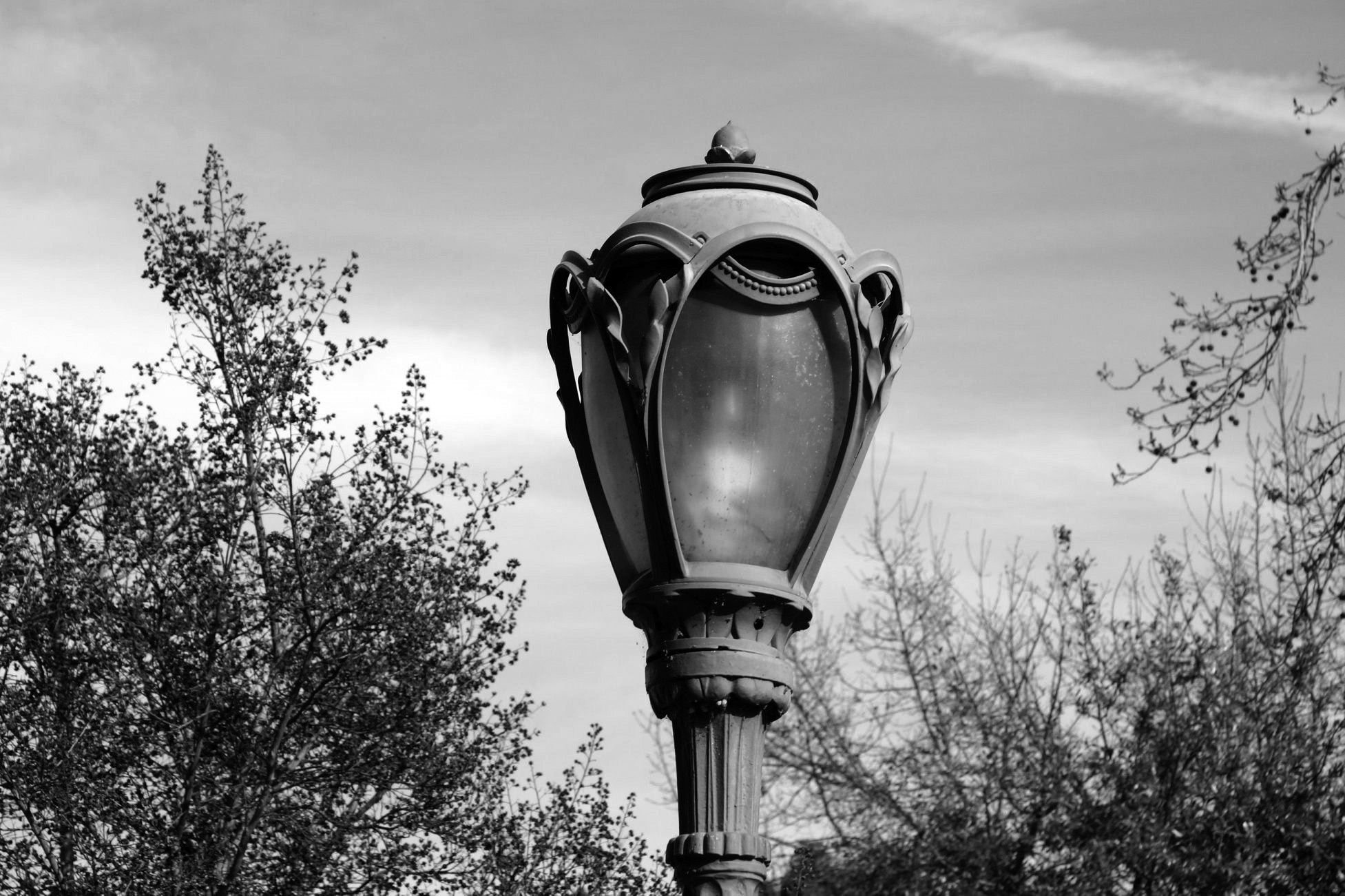 |
|
| (2020)^.^ - Close-up view of a 'Melrose Hill Special'. Note the acorn at the apex of the luminare. Photo by Glen Norman |
Historical Notes Melrose Hill is a small neighborhood located in the Hollywood Studio District of East Hollywood consisting of only a few dozen homes. It is located north of Melrose Ave., South of Santa Monica Blvd., East of Western Ave., and West of the 101. (aka Hollywood Freeway). |
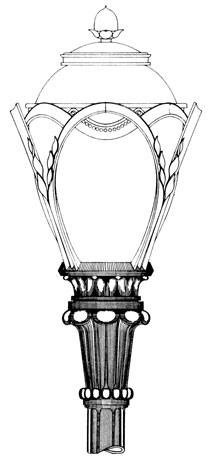 |
|
| (n.d.)* - "Melrose Hill Special" and/or 'Central Park Special' sketch showing design details. |
Historical Notes Designed by architects Gerald Allen and Kent Bloomer in 1983, the above light fixture is found throughout New York's Central Park. It is almost identical to the ‘Melrose Hill Special’ found in East Hollywood. ^ |
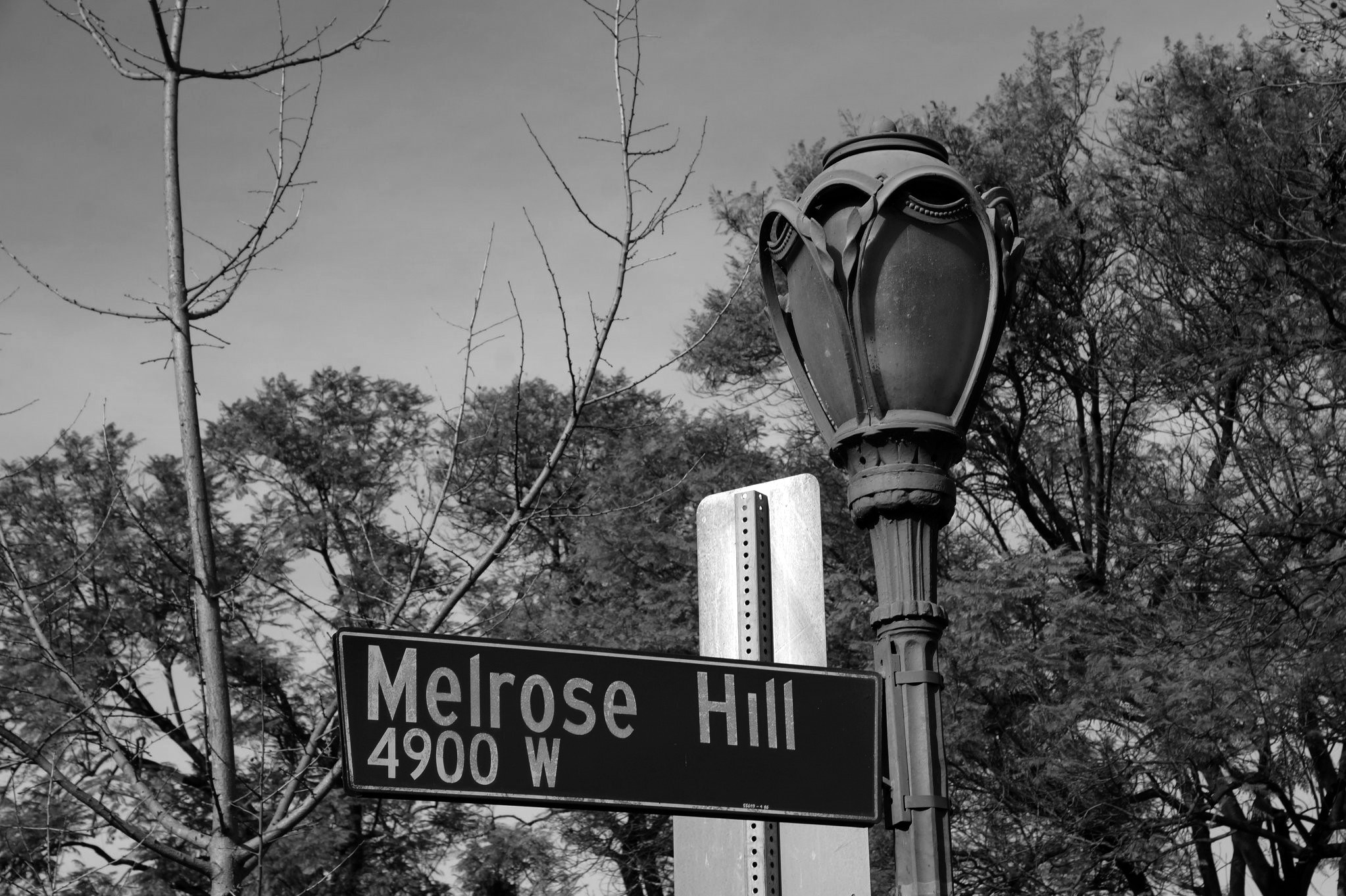 |
|
| (2020)^.^ – An ornate ‘Melrose Hill Special’ electrolier stands on the 4900 block of West Melrose Hill Street in East Hollywood. Photo by Glen Norman |
Historical Notes The cast-aluminum shell of the luminaire is constructed of elliptical curves adorned with abstracted leaves that follow and twist along the curves. The lantern is crowned with an acorn cap. |
More Early Los Angeles Streetlights
.jpg) |
(n.d.)* - View of a 7-bulb electrolier lamp in an early Los Angeles City park.
|
(n.d.)^^ - This pole was installed exclusively in the Holmby Hills area of Los Angeles which is now the location of the homes of many Hollywood movie stars and the Playboy Mansion. |
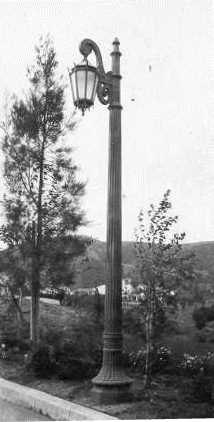 |
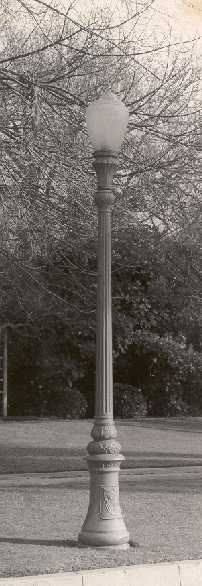 |
(n.d.)^^ - This "Windsor Square Special" originally installed as part of land development in 1914 in the Windsor Square area of Hancock Park was recently refurbished, including the use of incandescent lamps under a special policy adopted by the City Council. |
(n.d.)^^ - No longer in service, this Victoria Park special was affectionately called a 'plumber's nightmare' by maintenance forces. It graced an area of upscale Victorian-style homes from shortly after the turn-of-the-century until nearly 1960. |
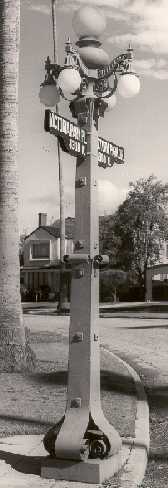 |
Early Ornamental Streetlight Standards
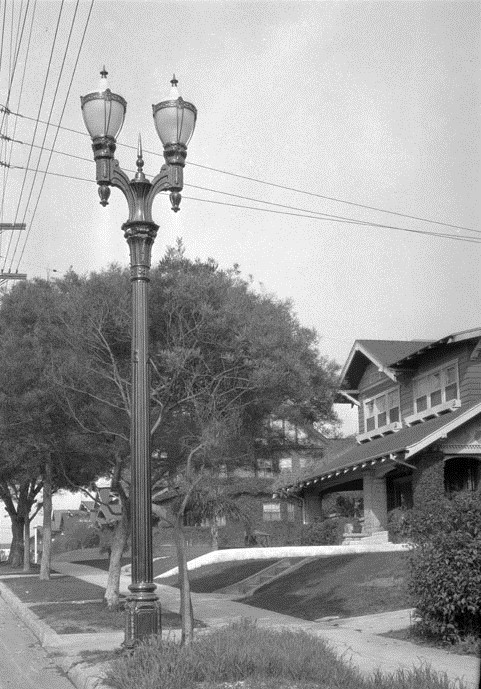 |
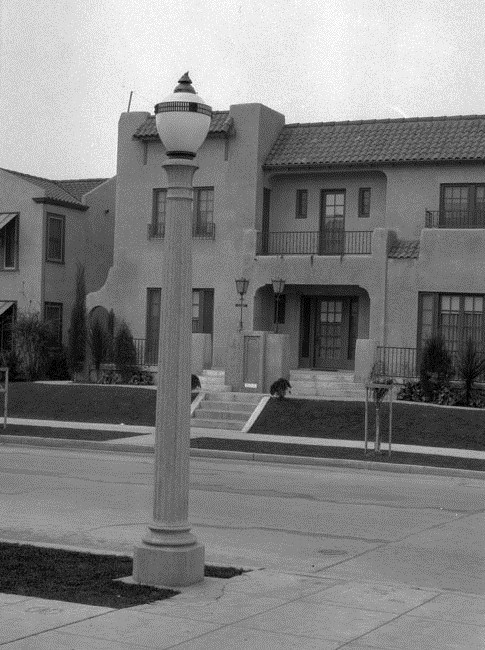 |
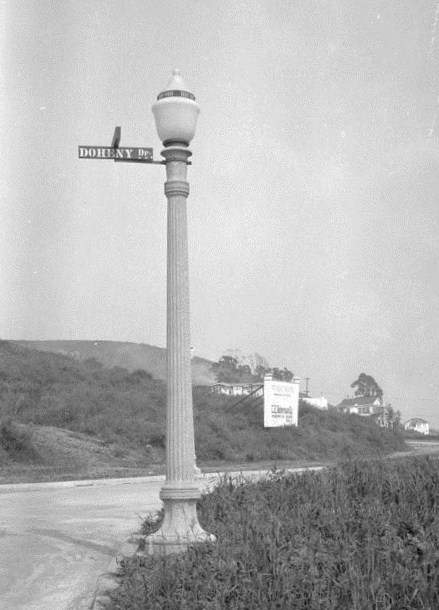 |
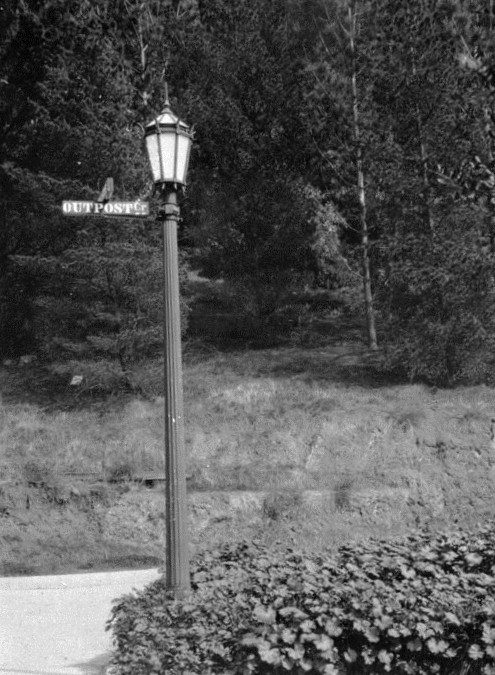 |
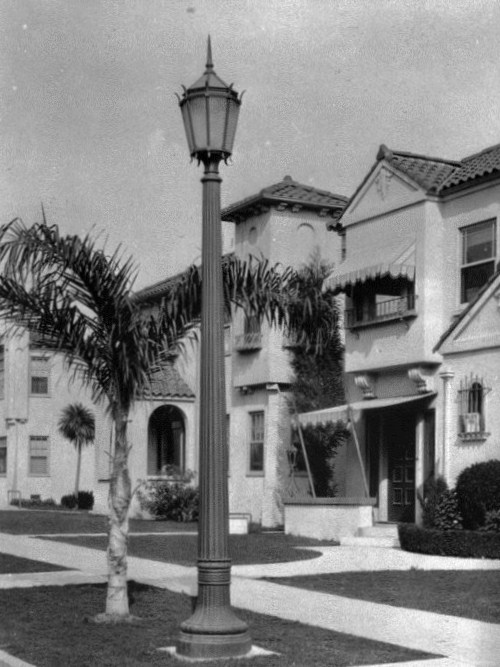 |
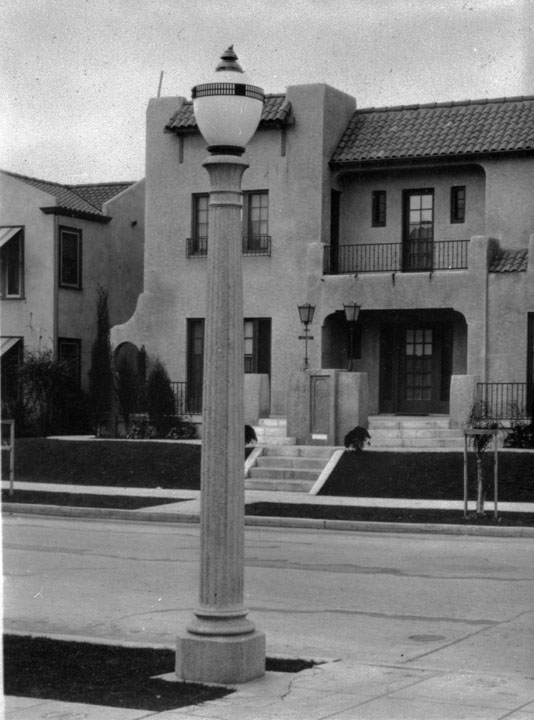 |
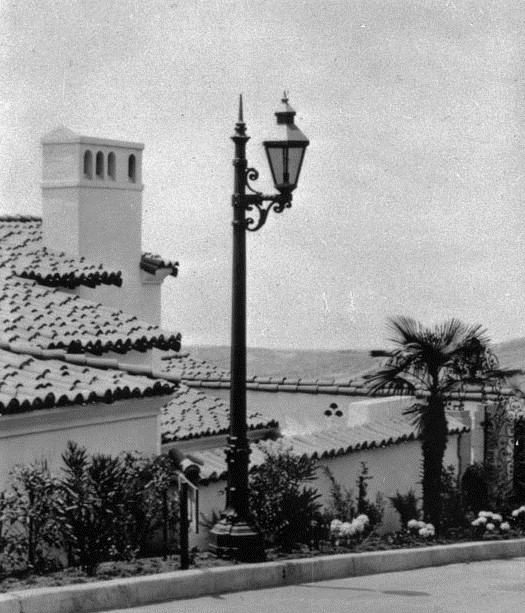 |
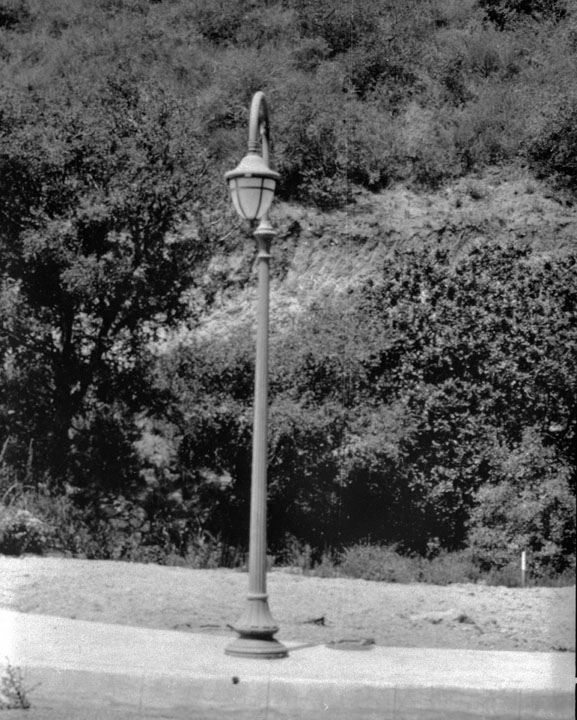 |
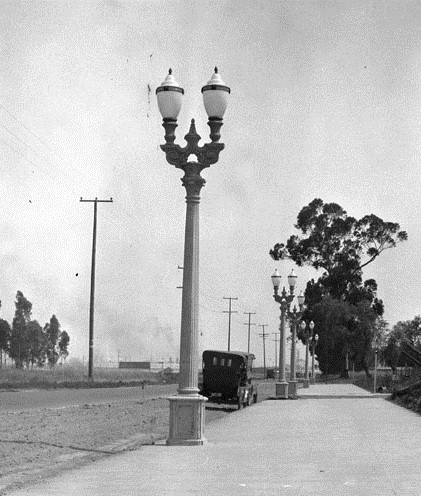 |
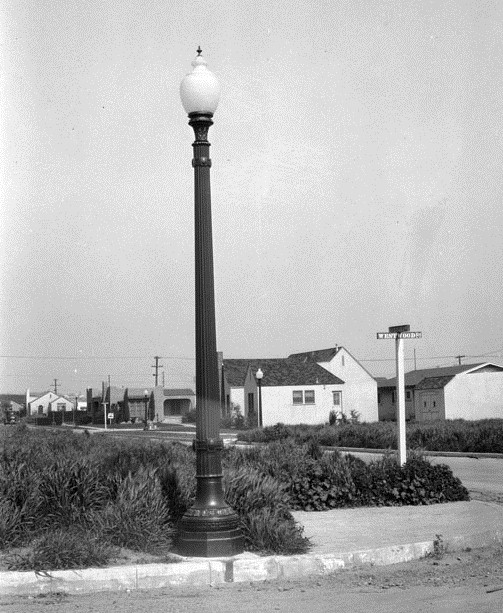 |
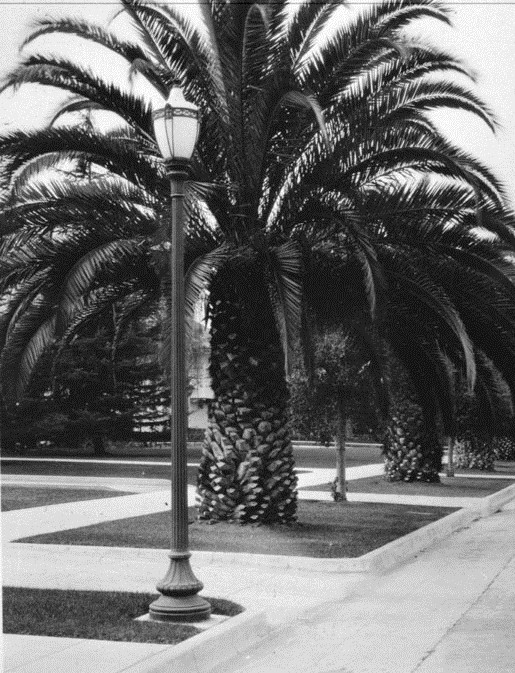 |
 |
Now and Then - We've Come Full Circle!
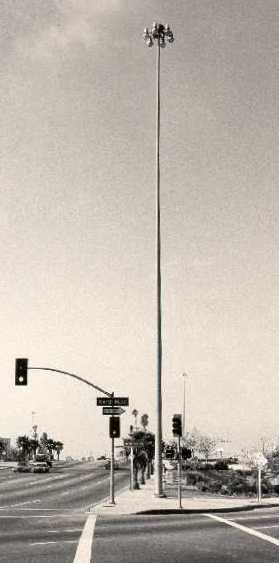 |
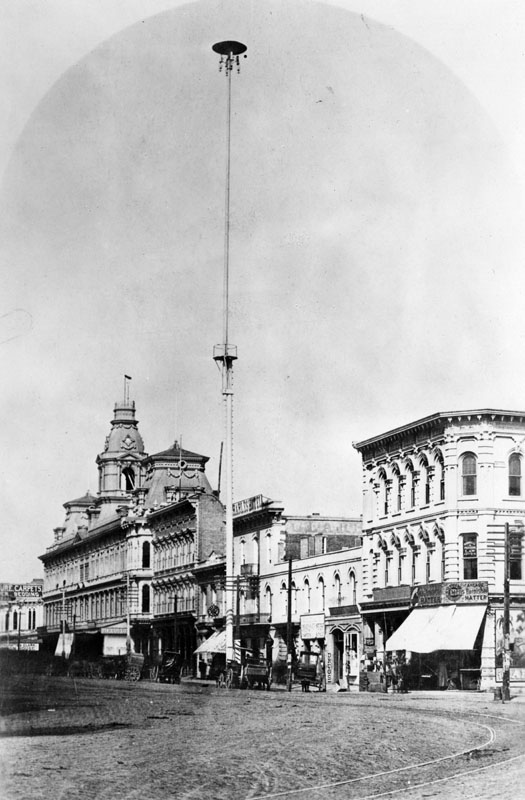 |
|
| (ca. 2000)^^ - The City now operates three systems utilizing 100 foot tall poles. | (ca. 1882)* - One of the first of seven electric street lights installed in the City of Los Angeles. It stood 150 feet tall. |
Century City Special
The Modern Look - Century City Special (ca. 1960s)^^ - Century City was developed as a major business center in the early 1960's principally sponsored by the Aluminum Corporation of America (ALCOA), hence the use of these aluminum davit poles throughout the streets within Century City.
|
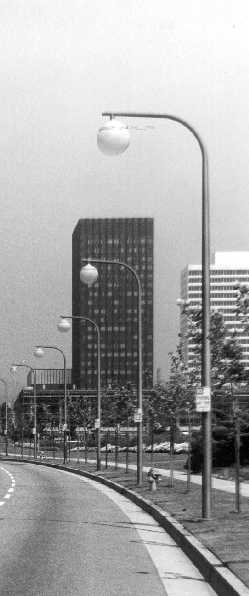 |
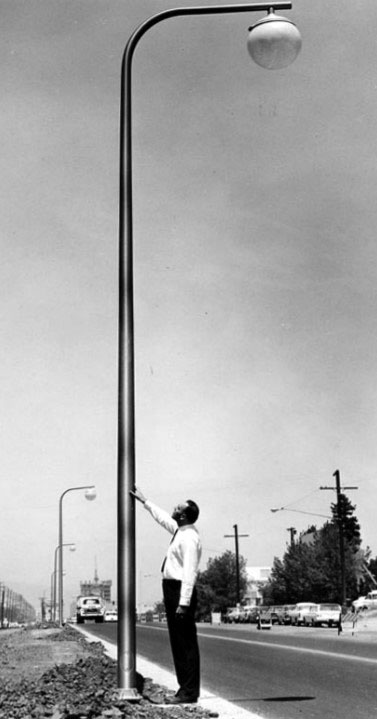 |
(1960)* – View looking west on Santa Monica Boulevard in Century City. A man stands at the base of a newly installed streetlight known as the ‘Century City Special’. |
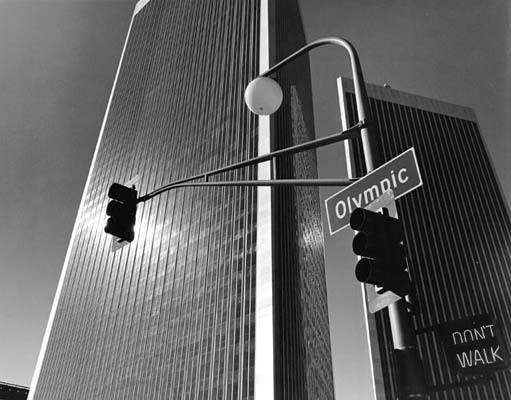 |
|
| (1976)^ - View showing a combination streetlight-traffic signal 'Century City Special' on Olympic Boulevard in Century City. In the background is the triangular shaped Century Plaza Towers, located at 2029 and 2049 Century Park East. |
Downtown Modern-Style
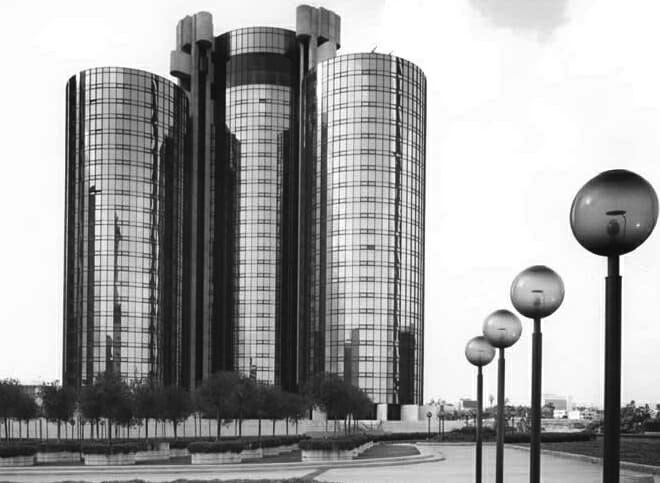 |
|
| (ca. 1980)^x^ - Modern-style streetlights stand in the courtyard in front of the Westin Bonaventure Hotel in downtown Los Angeles. |
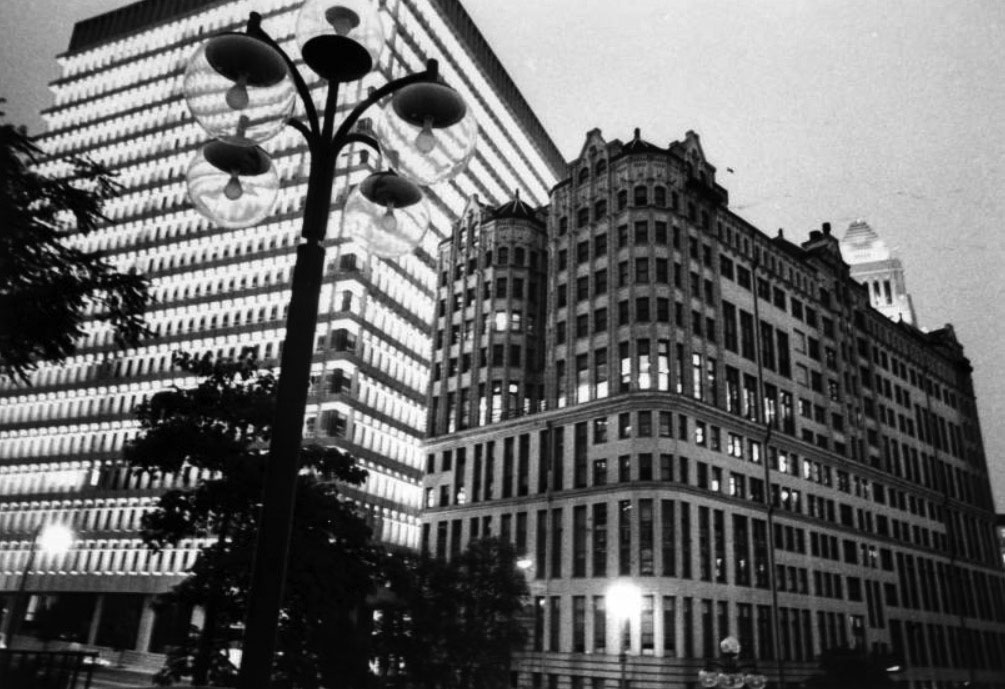 |
|
| (1972)*^ – A 5-lamp decorative streetlight stands in front of th Old Hall of Records building and the newer Criminal Courts building located on Poundcake Hill as seen from across Broadway at the County Mall. |
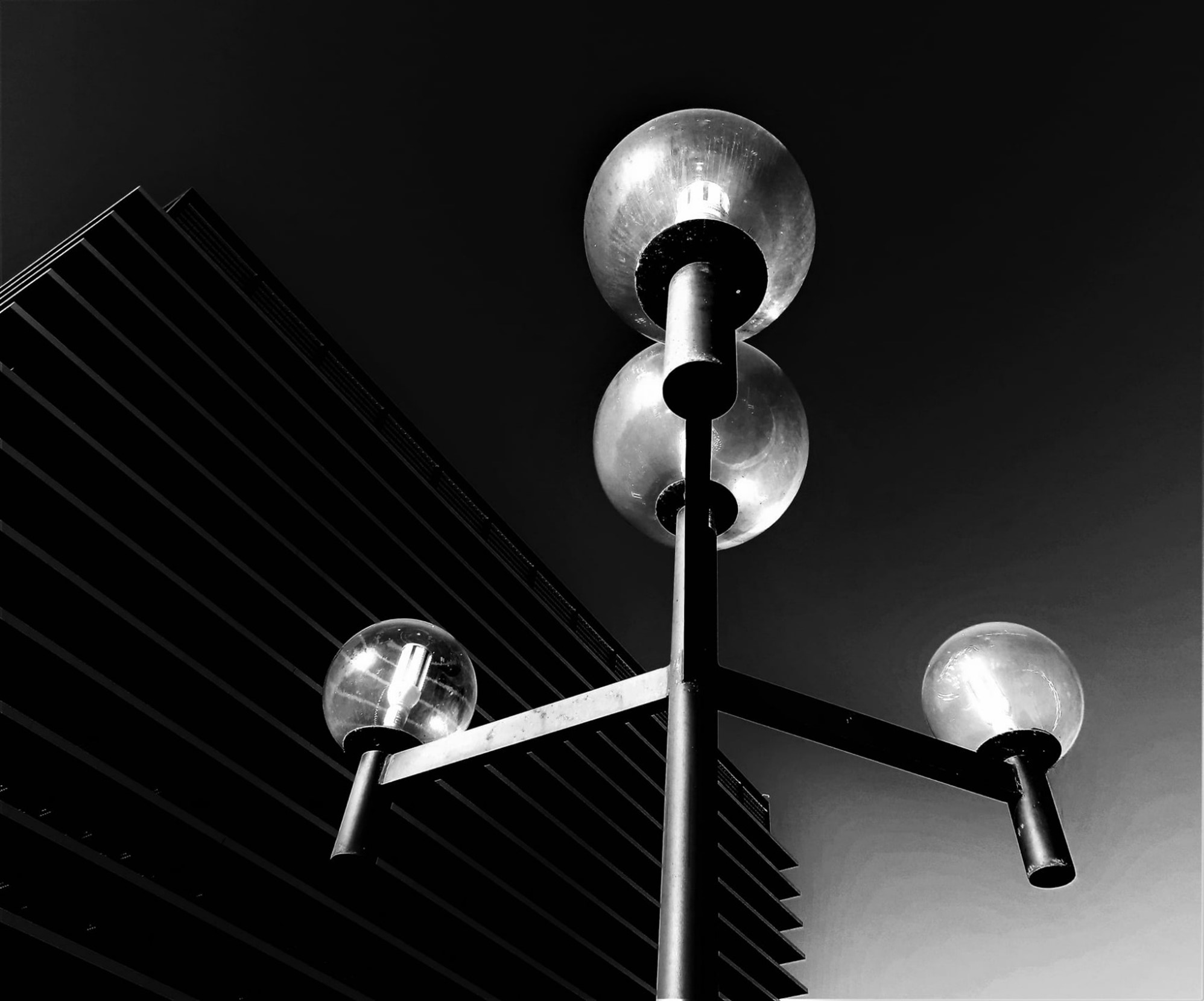 |
|
| (2021)* – 4-bulb decorative LED streetlight with the DWP Building seen in the background. Photo by Howard Gray |
LAX
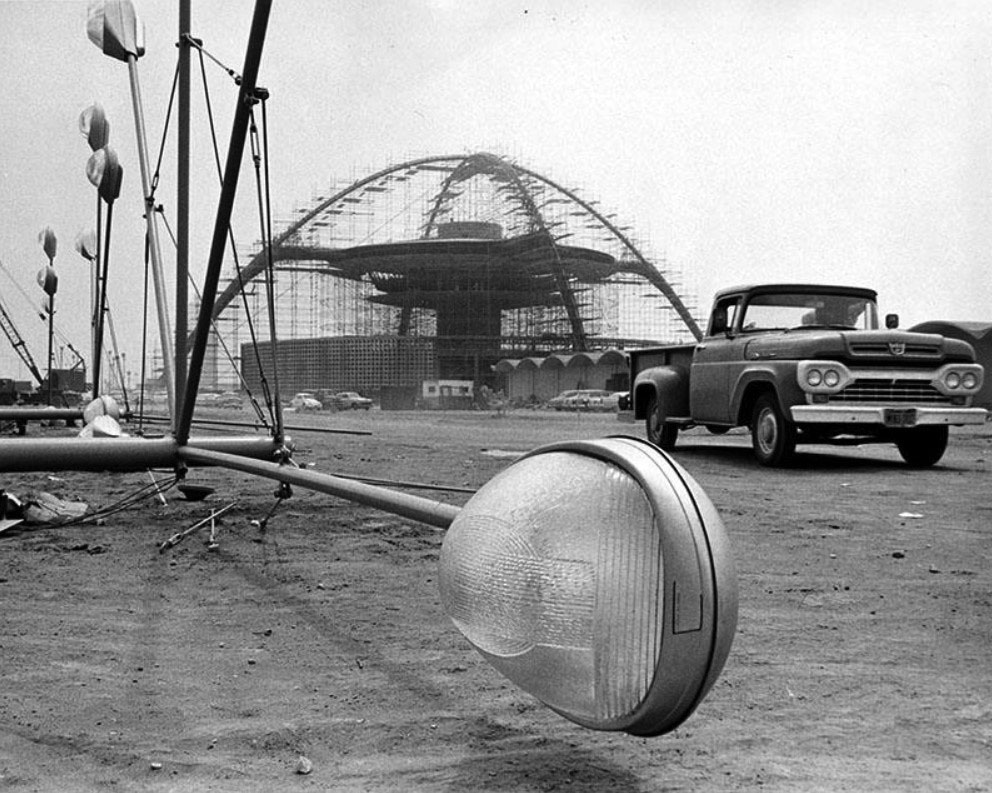 |
|
| (1961)* - New streetlights being assembled in the foreground as construction of LAX's Theme Building proceeds in the distance. Photo by John Woods - LAPL |
Historical Notes Los Angeles International Airport installed eight M-1000 mercury-vapor luminaires mounted atop 57' Pacific Union metal poles, 60 poles spaced 160' apart, six FTC. M-400 mercury vapor used on perimeter roadway and approaches. |
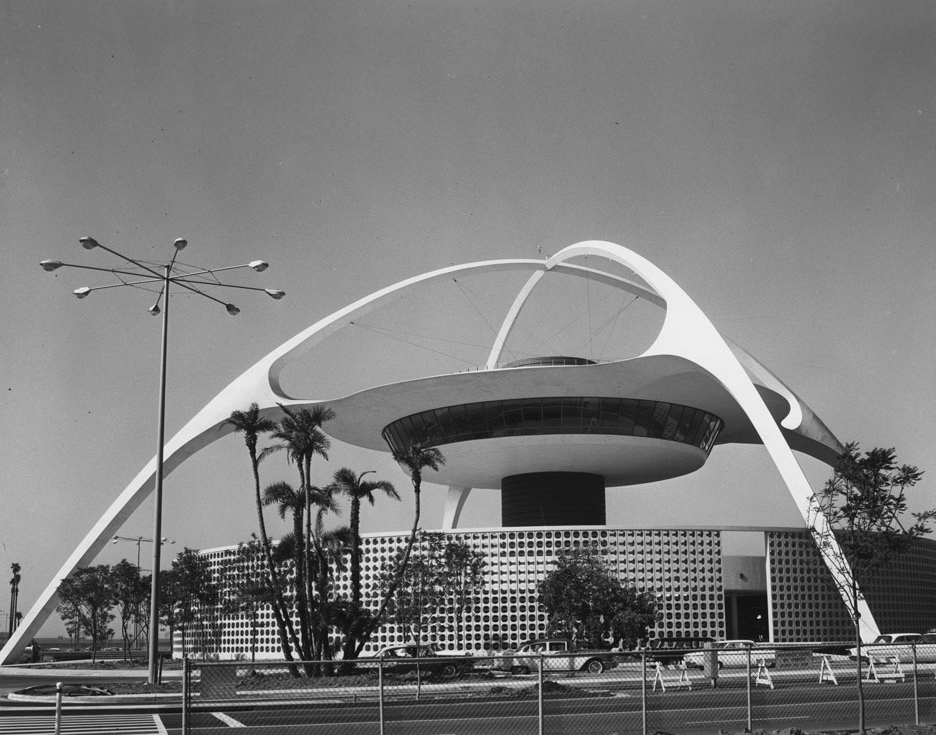 |
|
| (1961)*^ - A tall post with eight street lamp heads on it is situated adjacent to the Theme Building at the Los Angeles International Airport. Another lamp can be seen in the far background. |
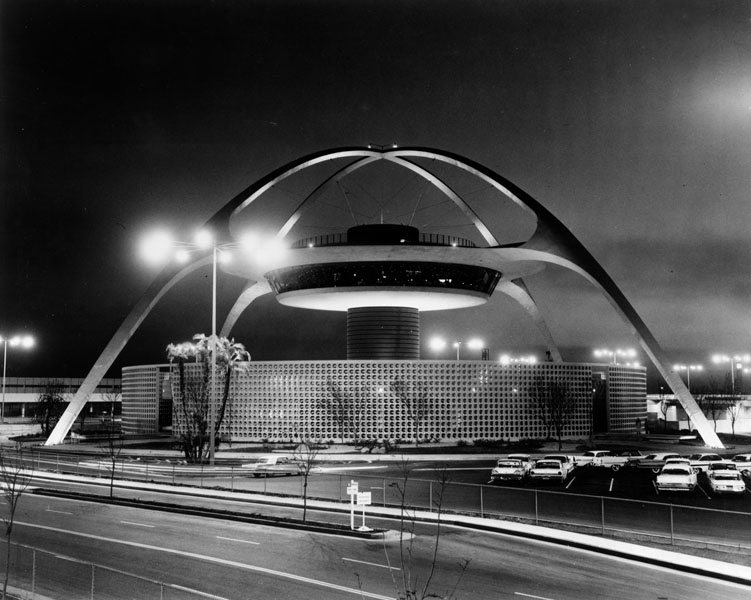 |
|
| (1960s)^ - Theme Building at the Los Angeles International Airport illuminated at night. Multiple lights can be seen around the building and in the parking area. |
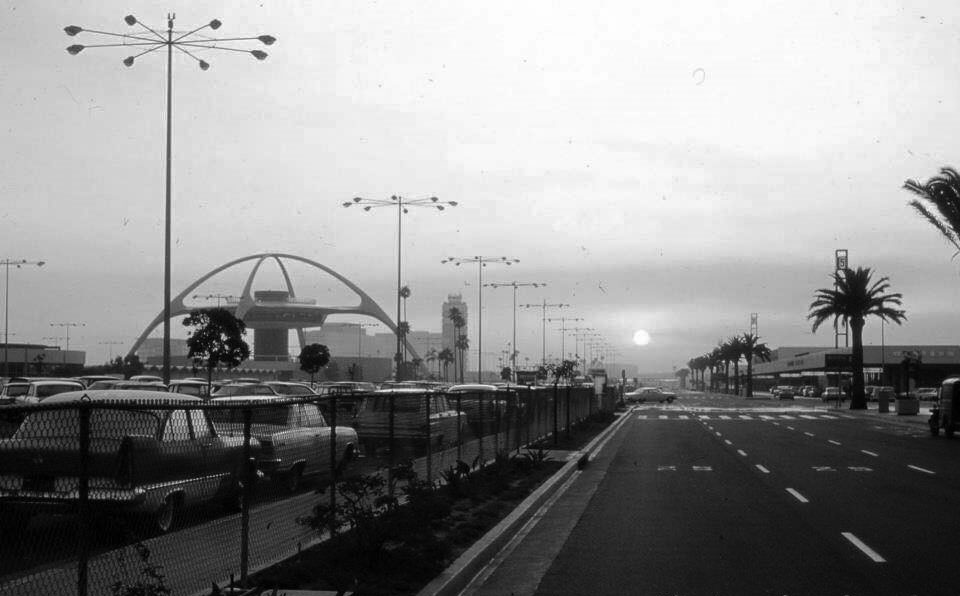 |
|
| (ca. 1964)* - An early morning sunrise at LAX Airport during the Atomic Age. Photo LA Times |
 |
|
| (1961)^v^ – View showing the control tower administration building at LAX. Also seen is a 57’ tall, 8-lamp, mercury-vapor streetlight in the parking lot. |
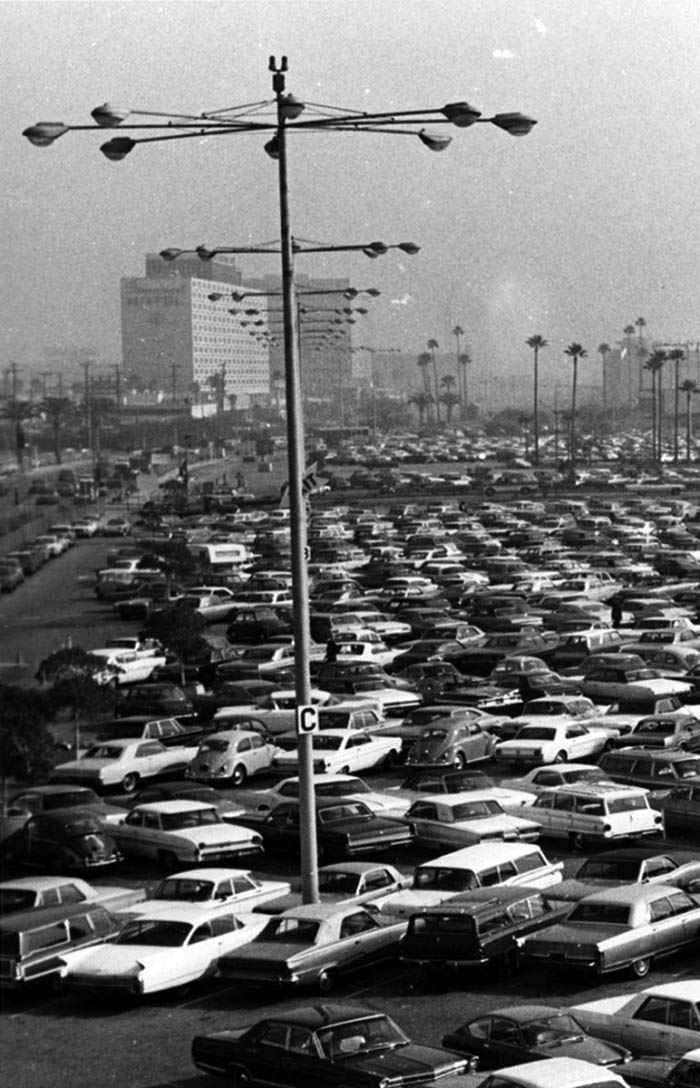 |
|
| (ca. 1974)*^ – A line of tall eight-headed lamps stand in the foreground, above row upon row of automobiles in a series of parking lots outside the airport. |
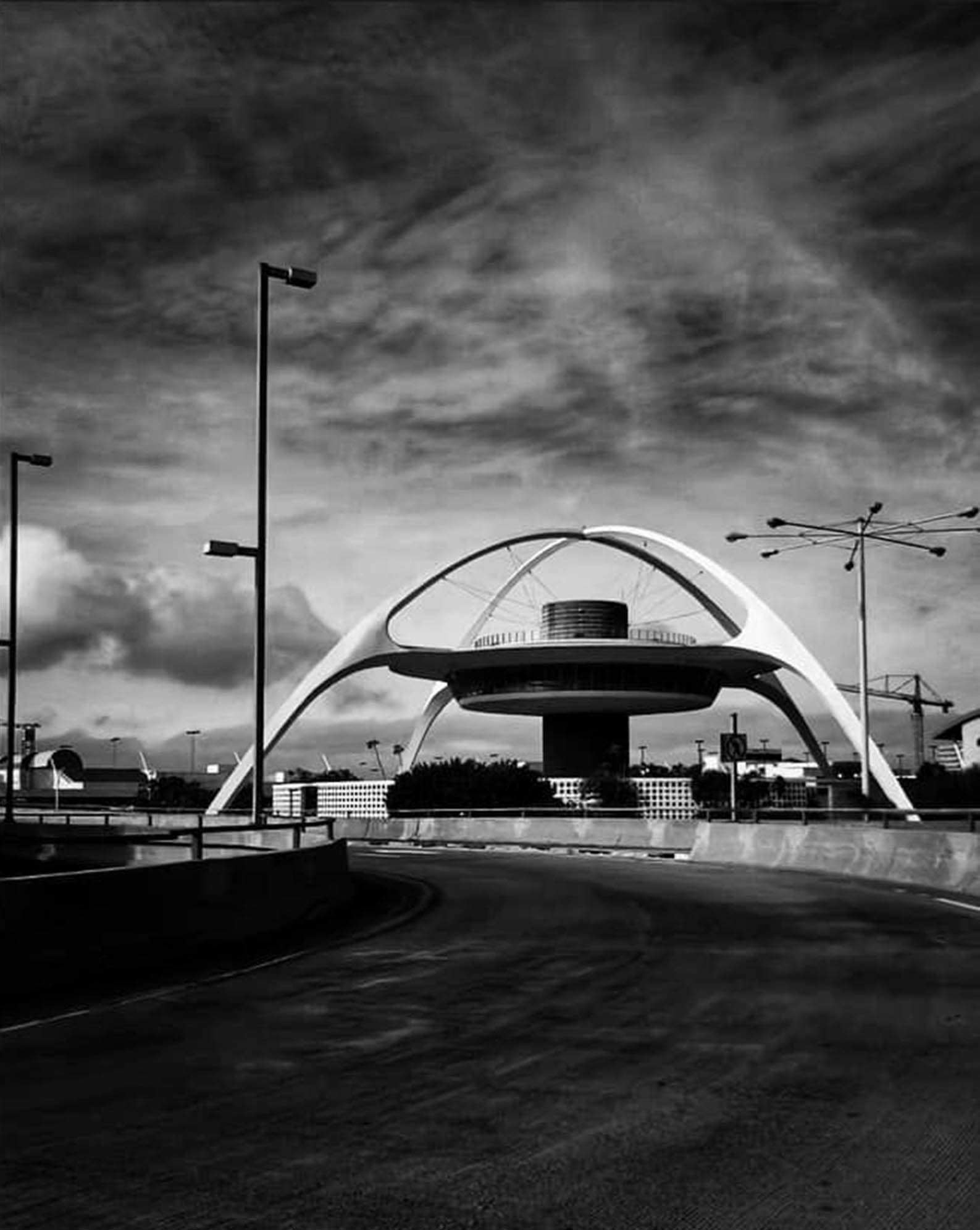 |
|
| (2022)* – Streetlights surrounding the Theme Building. Photo by Carlos G. Lucero |
LAX Eaton Contemporary Streetlights
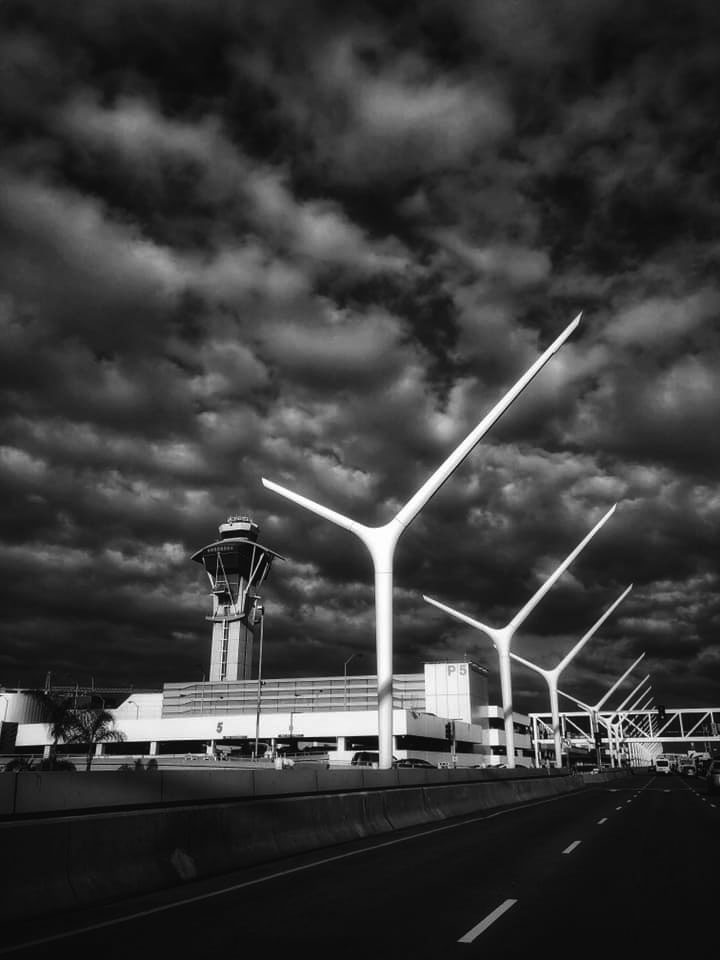 |
|
| (2020)^.^ - Double-arm Y-shaped contemporary streetlights, looking more like airplane propellers, line the roadway at LAX with the Control Tower seen in the background. Photo by Carlos G. Lucero |
Historical Notes Eaton dual-arm contemporary streetlights played a crucial role in revamping the exterior curbside lighting, as part of the first and second phases of the $118-million LAX Curbside Appeal and Roadway Improvement Project. The newly installed street lighting consumes 48 percent less energy than the 33-year-old, high-pressure sodium lights they replaced. |
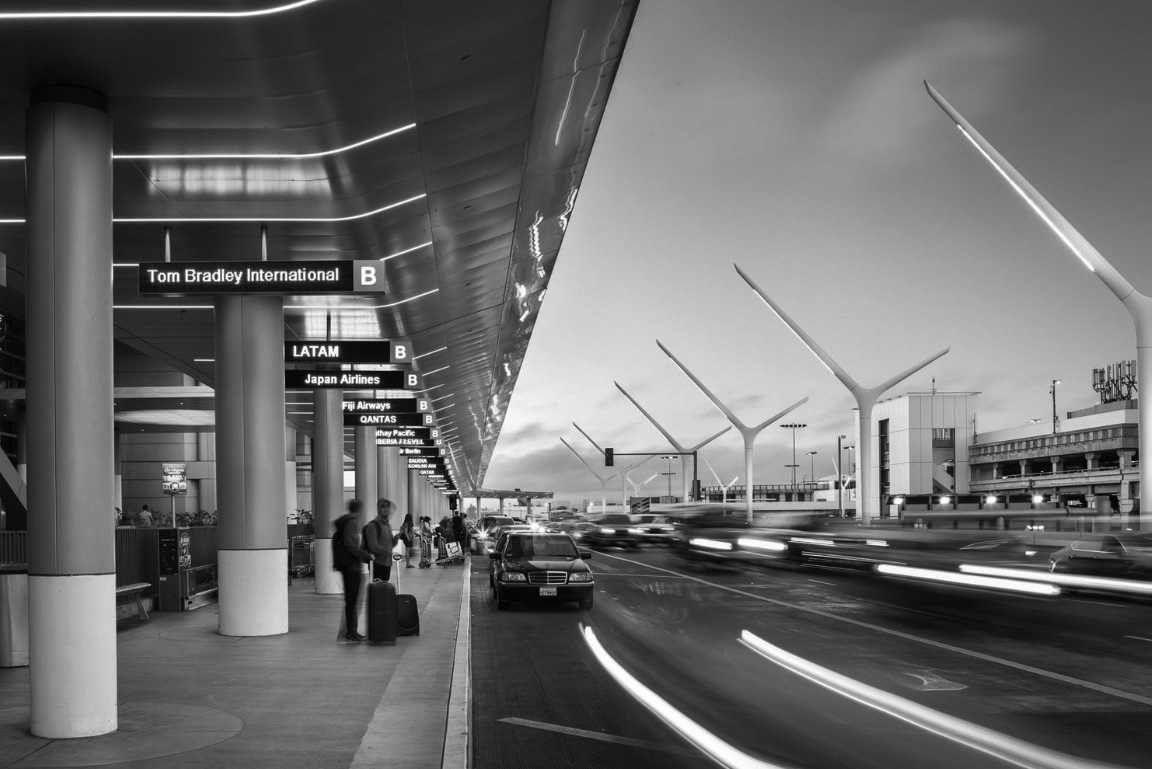 |
|
| (2018)^.^ - View showing highly customized, double-arm Y-shaped, contemporary streetlights in front of the Bradley International Terminal at LAX. Photo courtesy of Mike Kelley |
Historical Notes In 2013, the first 13 of the dual-arm contemporary fixtures were installed for the unveiling of the new $1.9 billion Tom Bradley International Terminal. 78 additional Y-shaped fixtures were subsequently installed throughout the airport. |
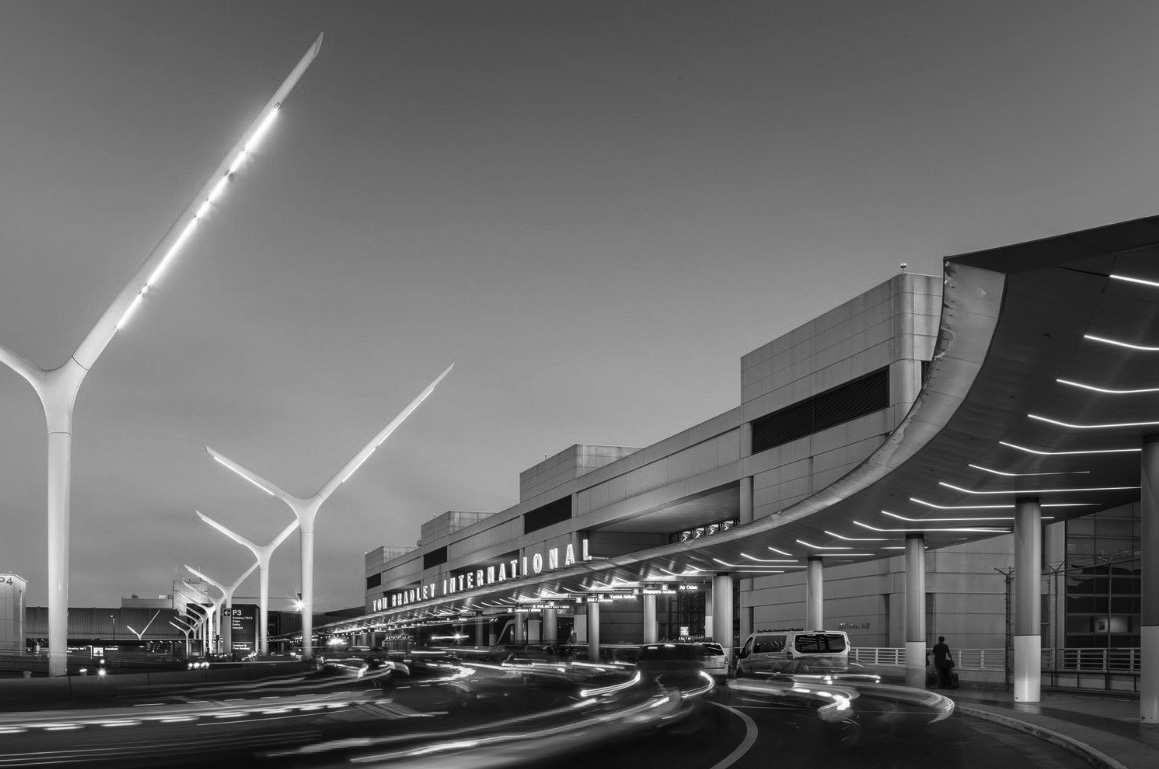 |
|
| (2018)^.^ - A line of Eaton contemporary electroliers light up both the roadway above (Departures) and roadway below (Arrivals) by the Bradley International Terminal at LAX. Photo courtesy of Mike Kelley |
Historical Notes These contemporry Eaton Electroliers were inspired by the ’60s style of the Theme Building and took their sculptural form from airplane propellers. |
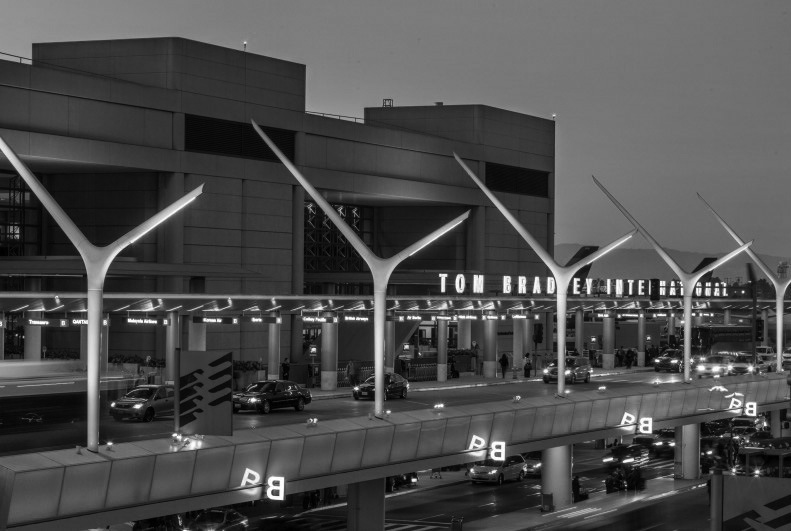 |
|
| (2018)^ – View showing the propeller-like streetlights that illuminate both upper and lower levels at LAX. Photo courtesy of AECOM |
Historical Notes The streetlights’ two arms illuminate different areas and levels of the roadway. The resulting uniform illumination meets the roadway lighting requirements (average 2.5 foot-candles) for both the Lower/Arrivals and Upper/Departures levels at the airport, which serves 70.7 million passengers each year. |
Highland Avenue 'Genie' Specials
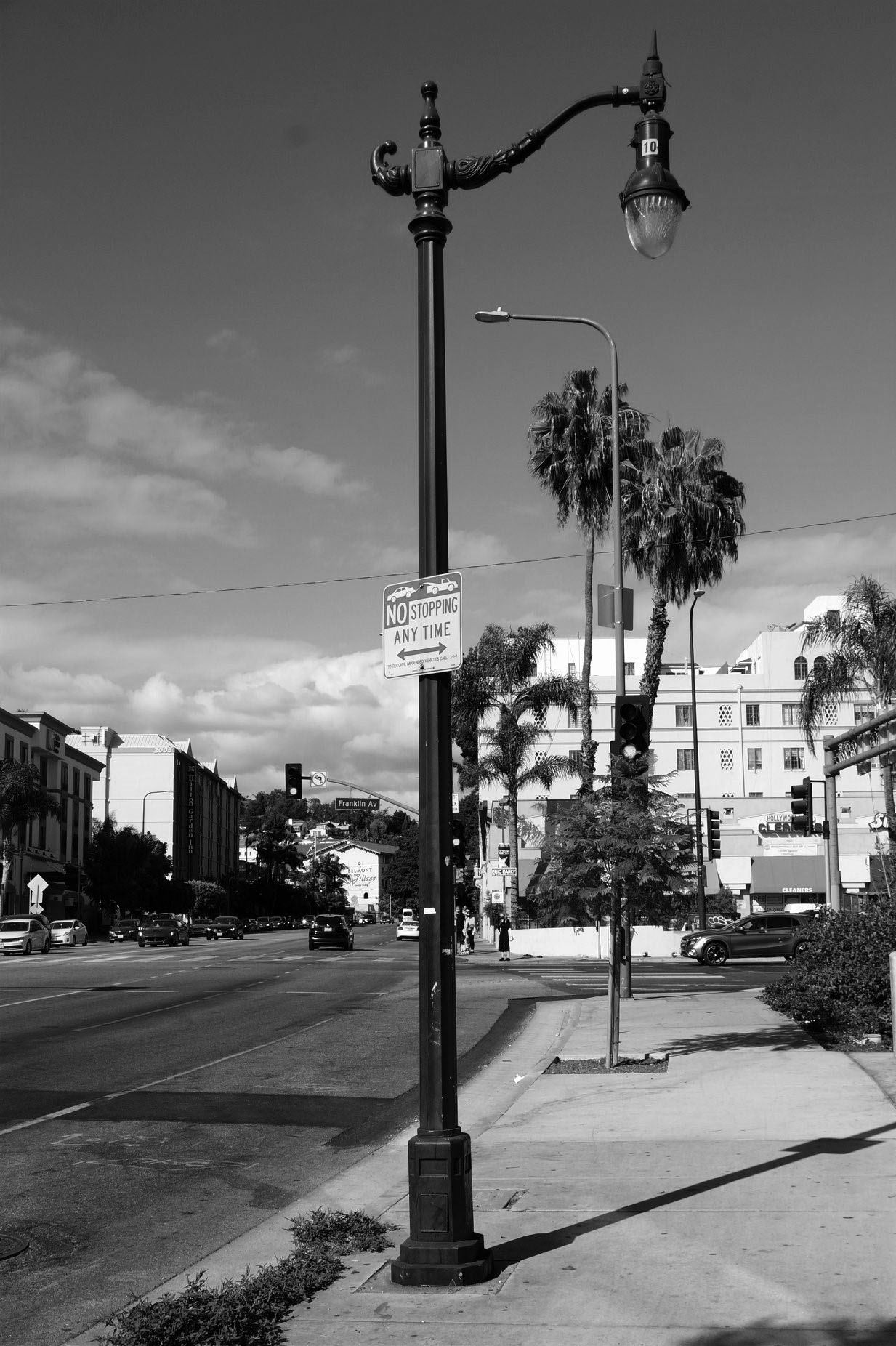 |
|
| (2010s)^.^ – View looking north on Highland at Franklin Ave showing a Genie-type streetlight with a teardrop lantern, known as the Highland Special. Photo by Glen Norman. |
Historical Notes Scroll arms (sometimes called Genie arms for their passing resemblance to Aladdin's Lamp) are pretty common on the pedestrian-scaled lights that have appeared in Los Angeles over the past couple of decades. Usually, those street lights feature skirts surrounding the the globes. The Highland Special Pole does not show this feature. |
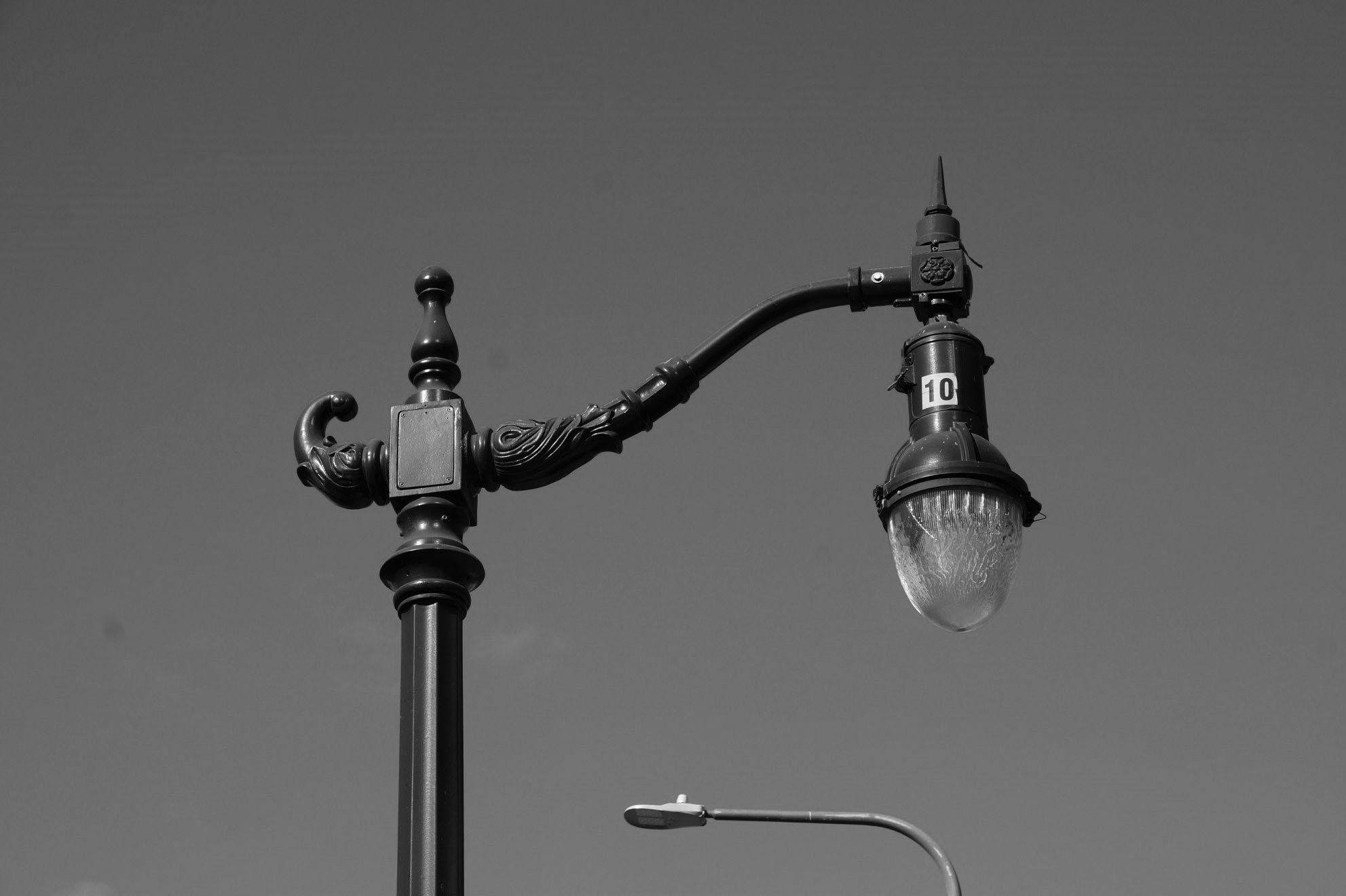 |
|
| (2010s)^.^ – Close-up view showing the Higland Special with its passing resemblance to Alladdin’s Lamp. Photo by Glen Norman |
Historical Notes The Highland Special Pole can be found on its namesake thoroughfare Highland Avenue from Yucca Street to a point North of Franklin Avenue. |
Hollwyood Boulevard 'Genie' Specials
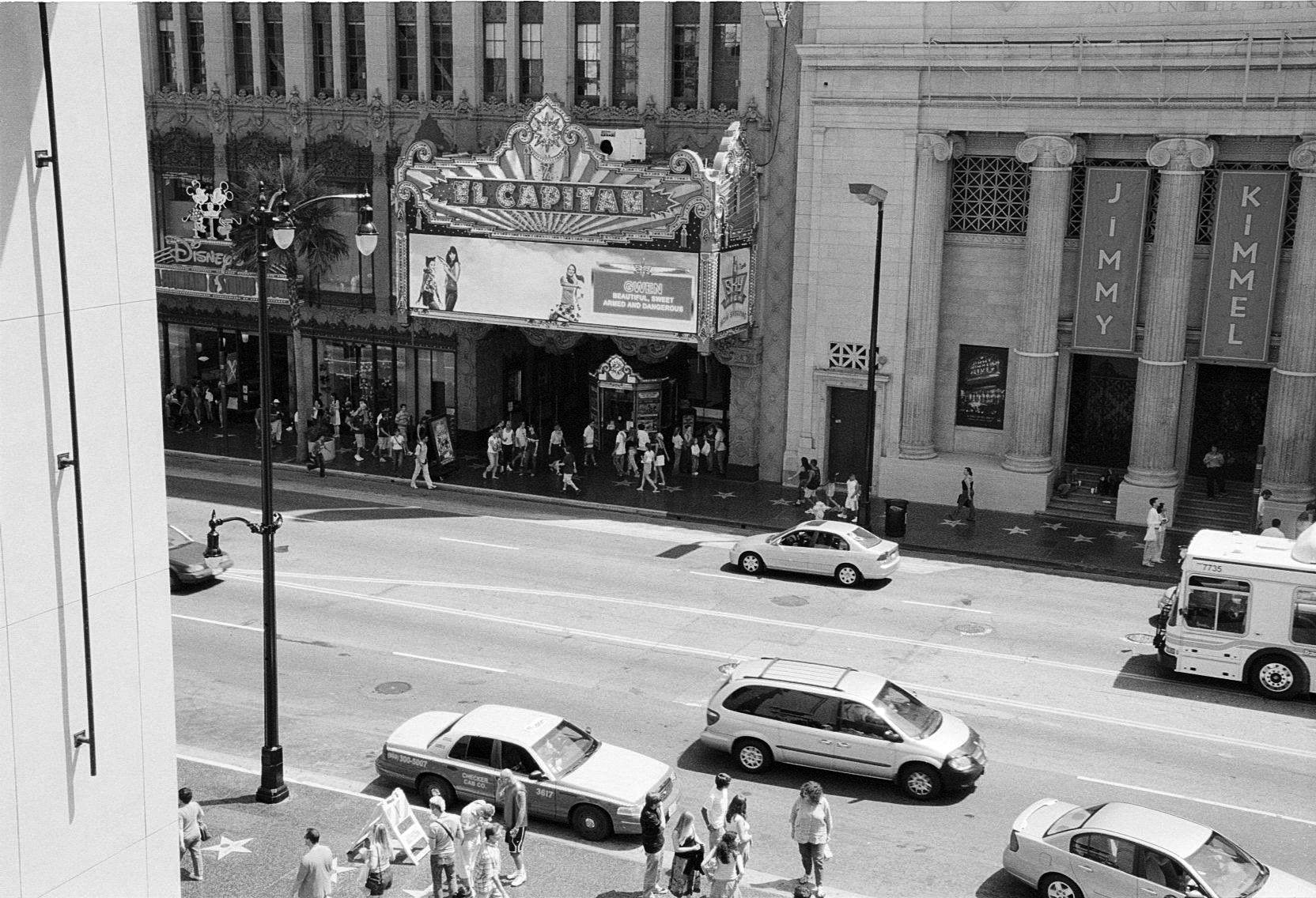 |
|
| (2005)^*^ - View showing a dual-head teardrop Genie-type streetlight on Hollywood Boulevard across the street from the El Capitain. This shot was taken from the balcony of the Hollywood & Highland Center in the middle of the conversion from the circa 1960 "5-Star" heads to the retro-twin teardrops. Photo by Glen Norman |
Historical Notes Scroll arms (sometimes called Genie arms for their passing resemblance to Aladdin's Lamp) are pretty common on the pedestrian-scaled lights that have appeared in Los Angeles over the past couple of decades. Usually, those street lights feature skirts surrounding the the globes. The Highland Special Pole does not show this feature. |
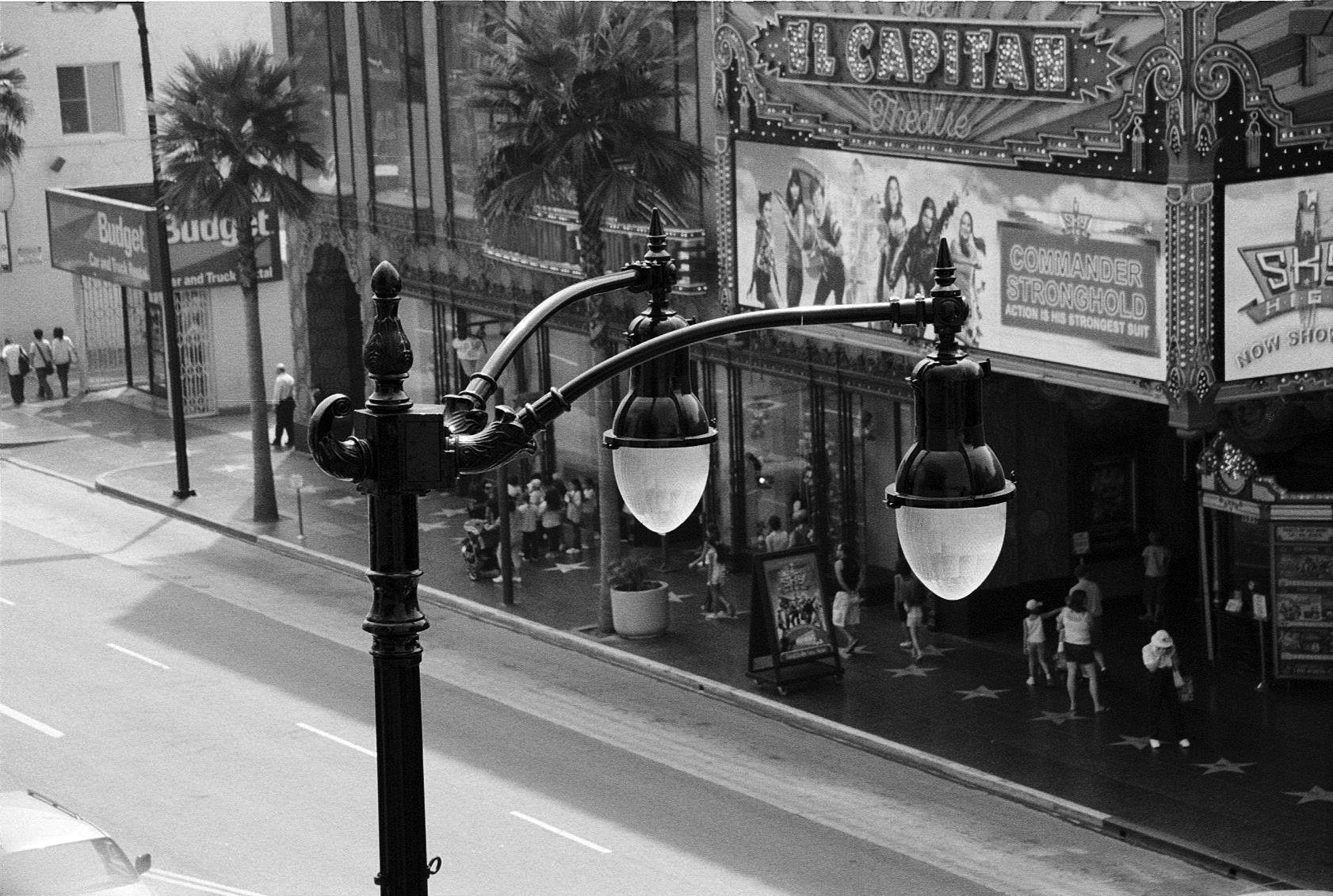 |
|
| (2005)^.^ - Close-up view showing the retro-twin teardrops Genie Lamp-like streetlights on Hollywood Boulevard. Photo by Glen Norman |
Historical Notes The twins were originally lamped with 400 Watt Metal-Halide, but were updated recently to 100 Watt LEDs. |
'Genie Lamp' Streetlights (Boyle Heights)
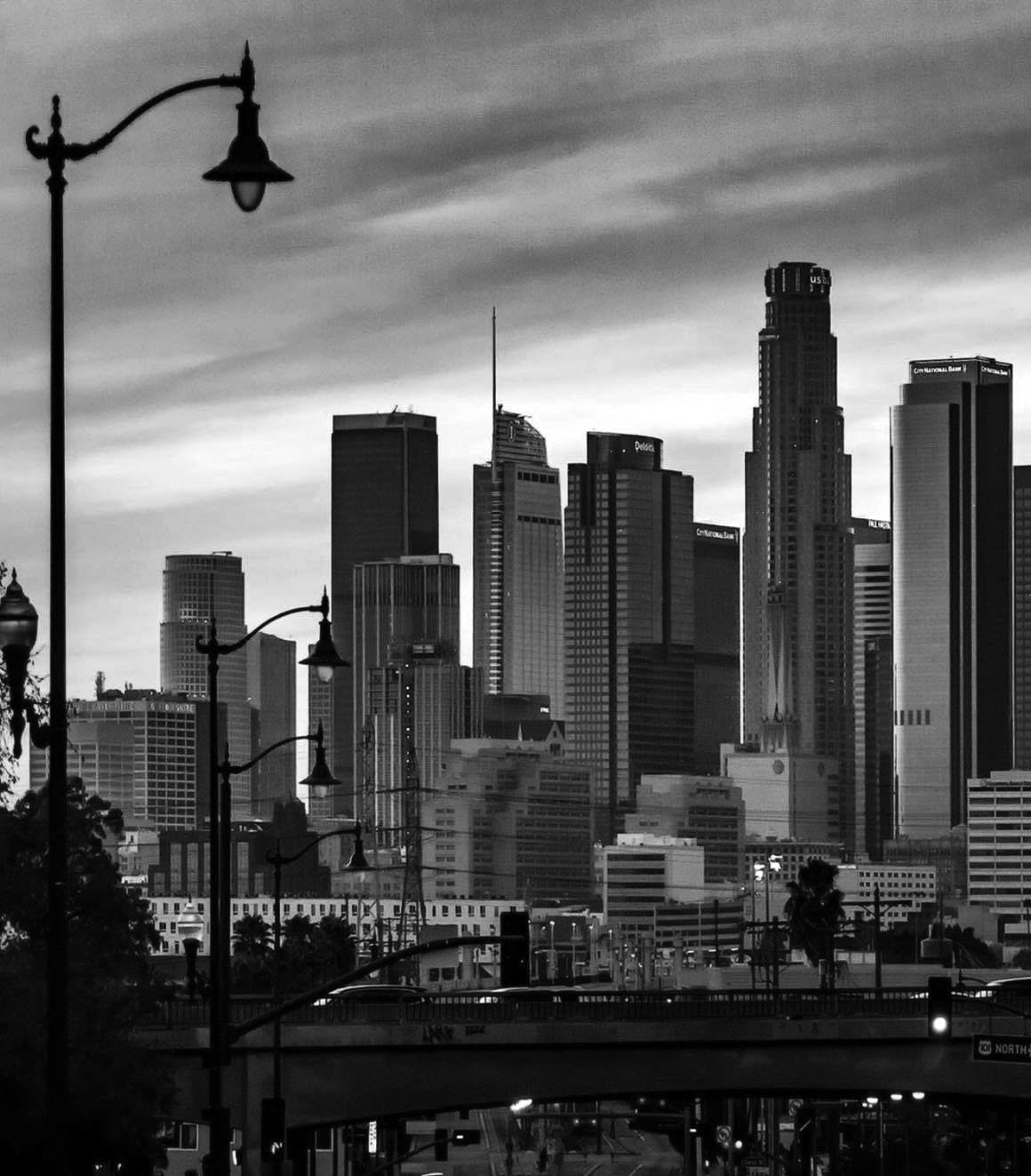 |
|
| (2020)^.^ - View looking west on 1st Street from near Boyle Avenue toward DTLA. Note the beautiful single lamp streetlights hanging from one-arm pendants which are connected to assemblies resembling a ‘genie lamp’. Also seen is the beautiful LADT Skyline. The two tallest buildings in the background are the new Wilshire Grand with its 10-story spire and the 73-story US Bank Tower. Click HERE for a Google Street View. Photo by @dannym87 / I Love Los Angeles |
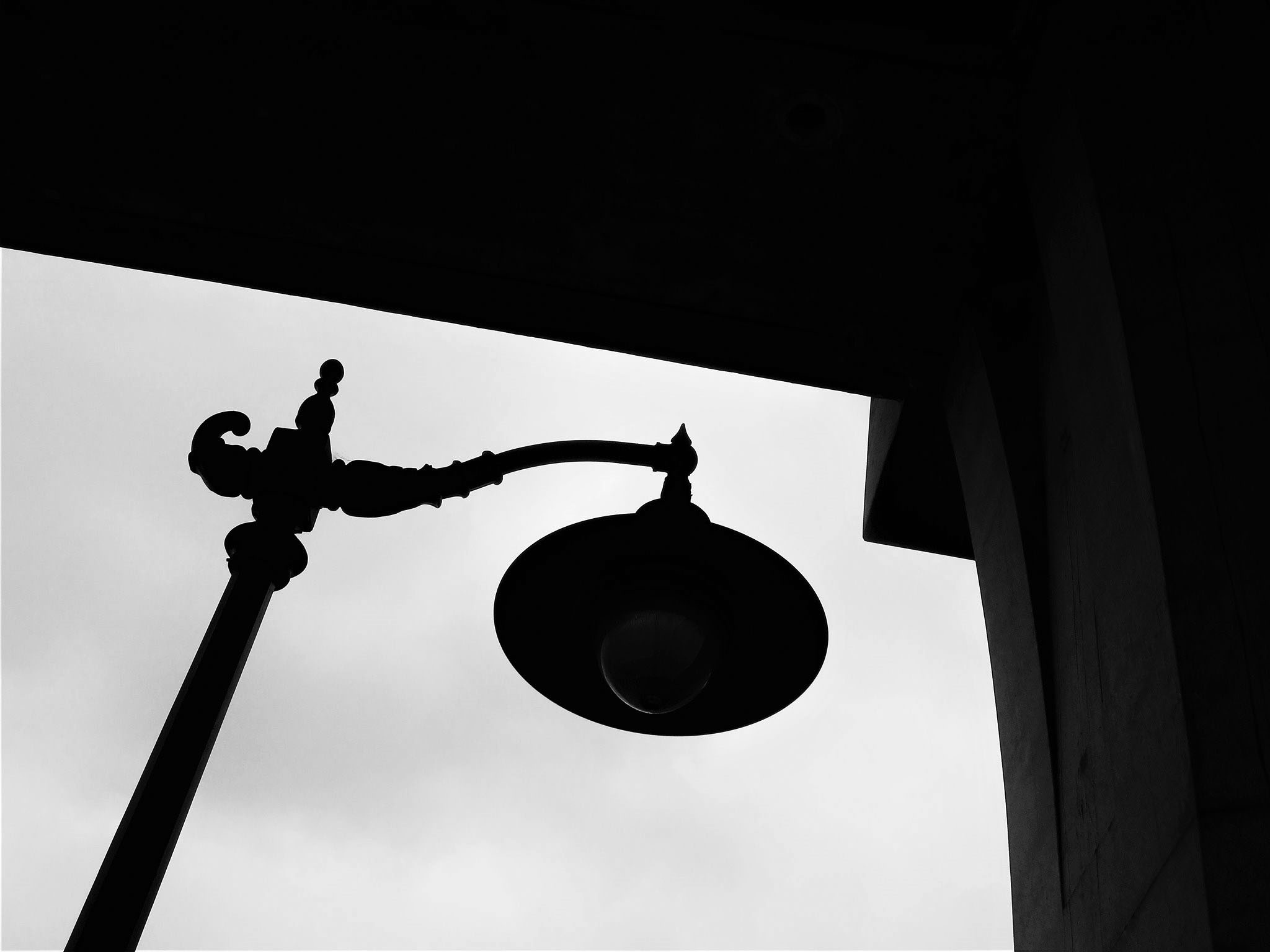 |
|
| (2020)^.^ - Looking up at a ‘Genie Lamp’ Streetlight near the 101 Freeway overpass on 1st Street. Photo by Howard Gray |
'Genie Lamp' Streetlights (DTLA)
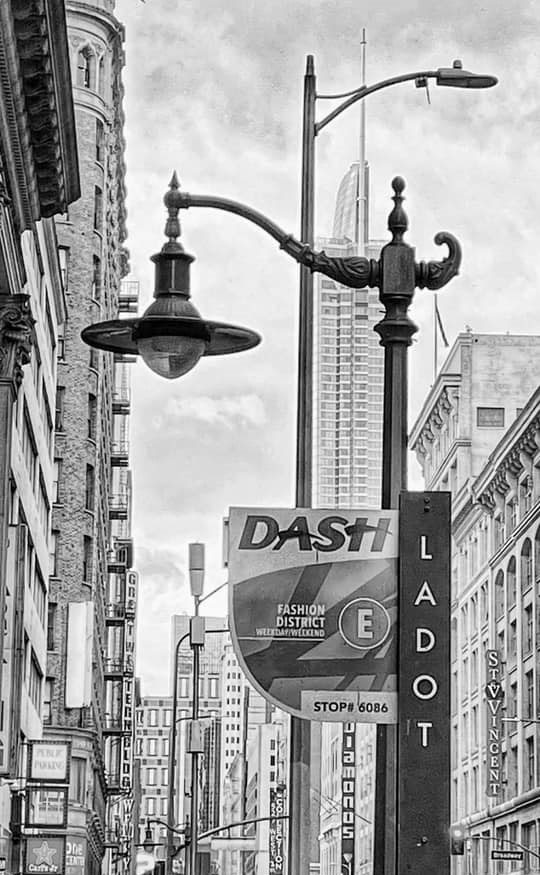 |
|
| (2021)^ – View looking west on 7th Street near Broadway showing a ‘Genie Lamp’ Streetlight over a LADOT DASH Bus Stop with the more traditional Cobra Head-style LED light behind it. In the distance can be seen the Wilshire Grand Center high-rise. Photo by Carlos G. Lucero |
* * * * * |
Cobra LED Electroliers
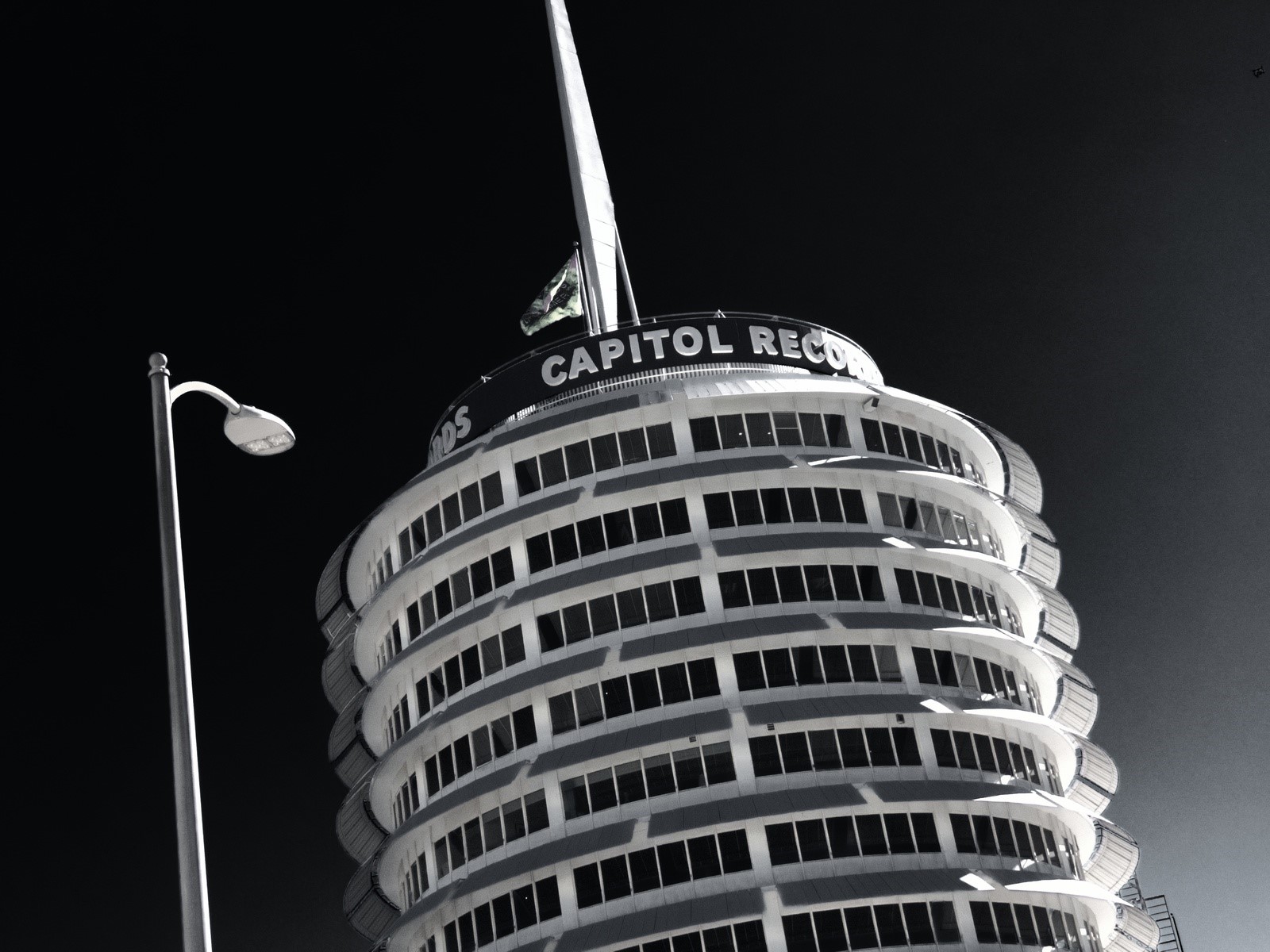 |
|
| (2019)** - A Cobra Head LED streetlight stands in front of the Capitol Records Building in Hollywood. Photo by Ted VanCleave |
Historical Notes Los Angeles has 215,000 street lights, 2nd most on any major city in the United States. Since 2009, LA started converting all of these lights to LEDs. Today, LED lights are capable of producing almost double the ratings compared to when they started. Millions of dollars have been saved by the City through this form of conservation.^ |
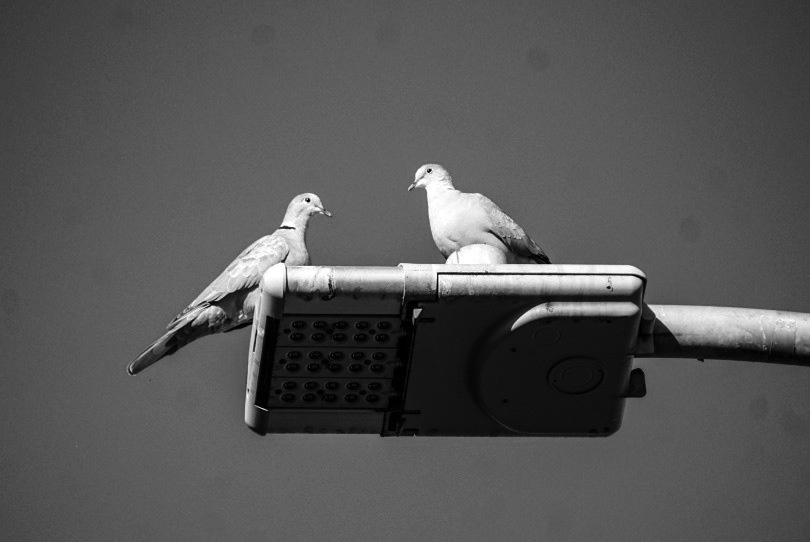 |
|
| (2020)^.^ - Two pigeons rest atop a new Cobra LED Streetlight…the most common streetlight being installed in Los Angeles today. They come in a variety of sizes and shapes. Photo courtesy of Dionesio C Grava |
Historical Notes Today, Cobra Head LED streetlights are commonly used for street lighting applications because they are shaped in such a way that diffuses light to cover a wide patch of ground and, more importantly, they are highly energy efficient. |
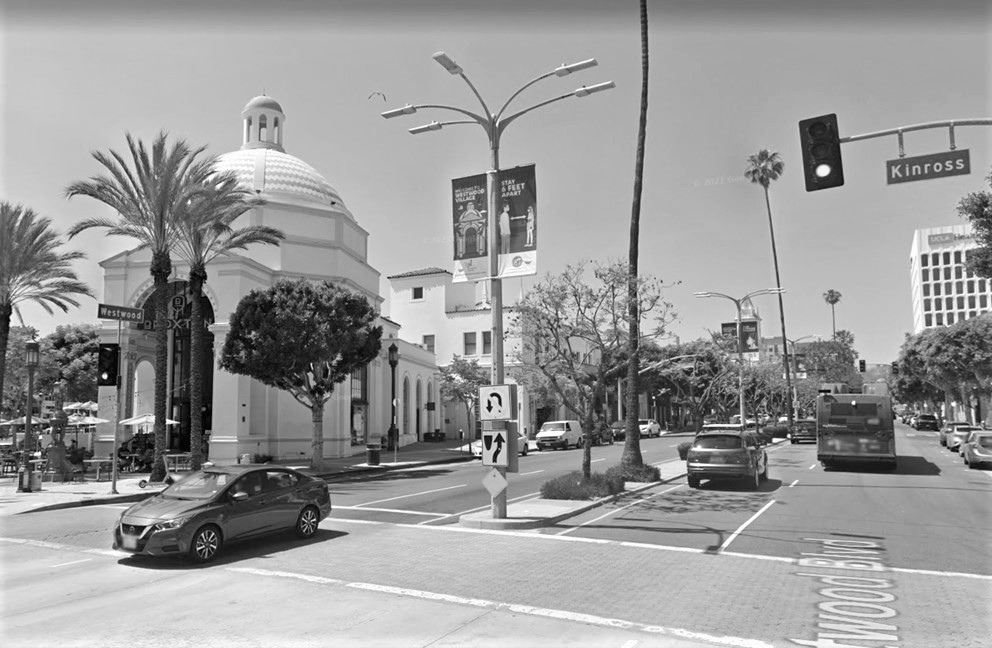 |
|
| (2021)* - Google street view showing a Five-arm Cobra LED Streetlight in front of the iconic Janss Dome Building at the corner of Westwood Boulevard and Kinross Avenue in Westwood Village. |
Metropolitan LED Electroliers
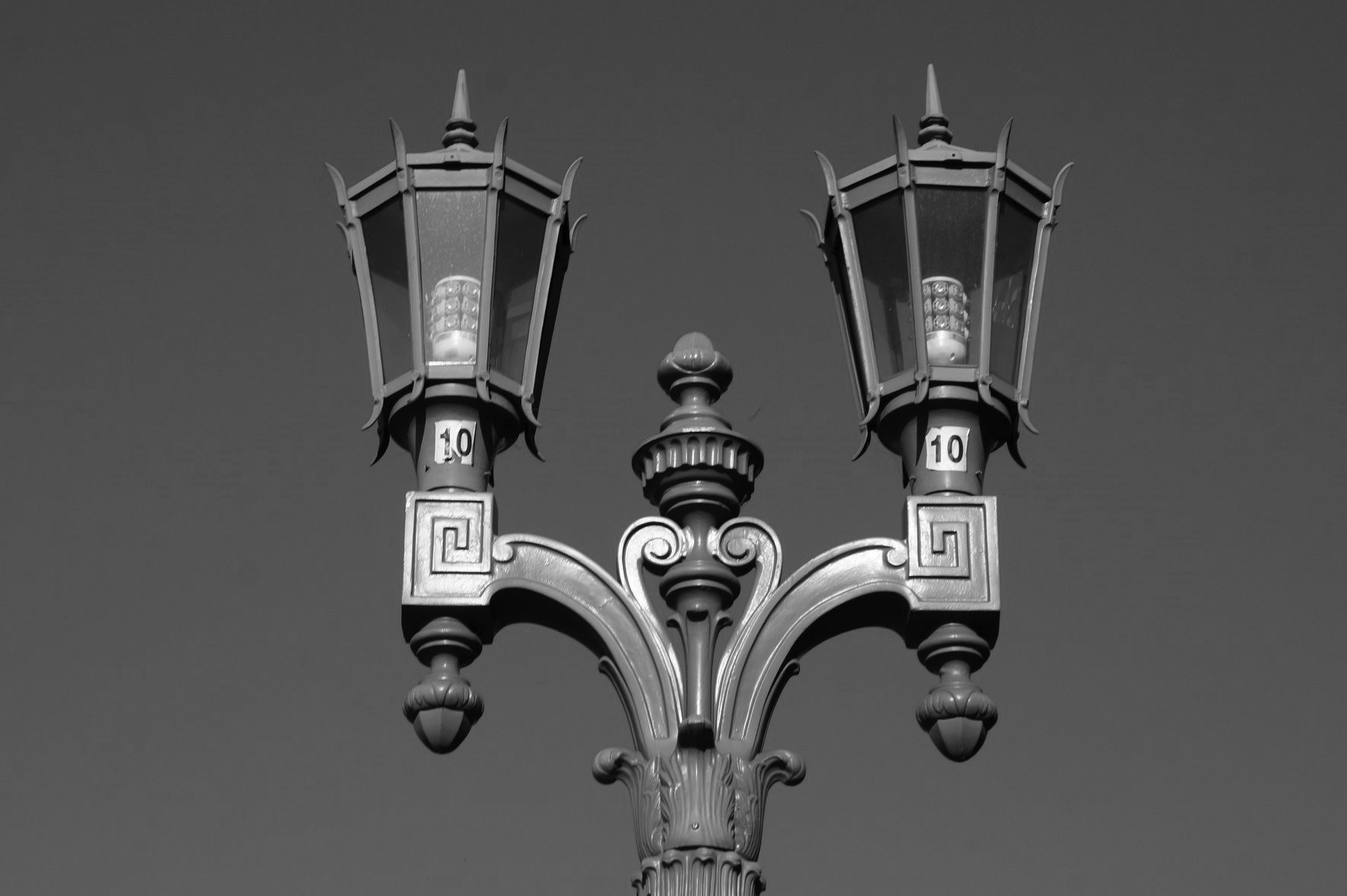 |
|
| (2020)^.^ - View showing traditional Metropolitan Streetlight converted to utilize higher efficient LED lights. Photo by Glen Norman |
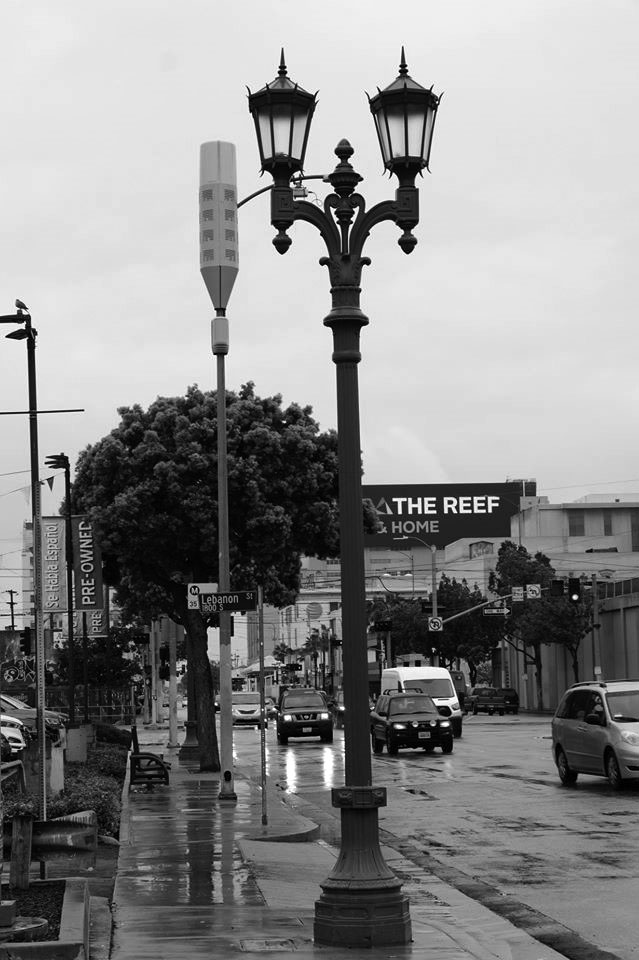 |
|
| (2020)^.^ - View showing a Metropolitan LED electrolier located on Washington Boulevard and Lebanon Street on a rainy day. Note the unusually shaped electrolier behind it. It is actually a combination streetlight-cell tower post commonly referred to as a ‘Smartpole’. Photo by Glen Norman |
Combination Streetlight - Cell Towers (Smartpoles)
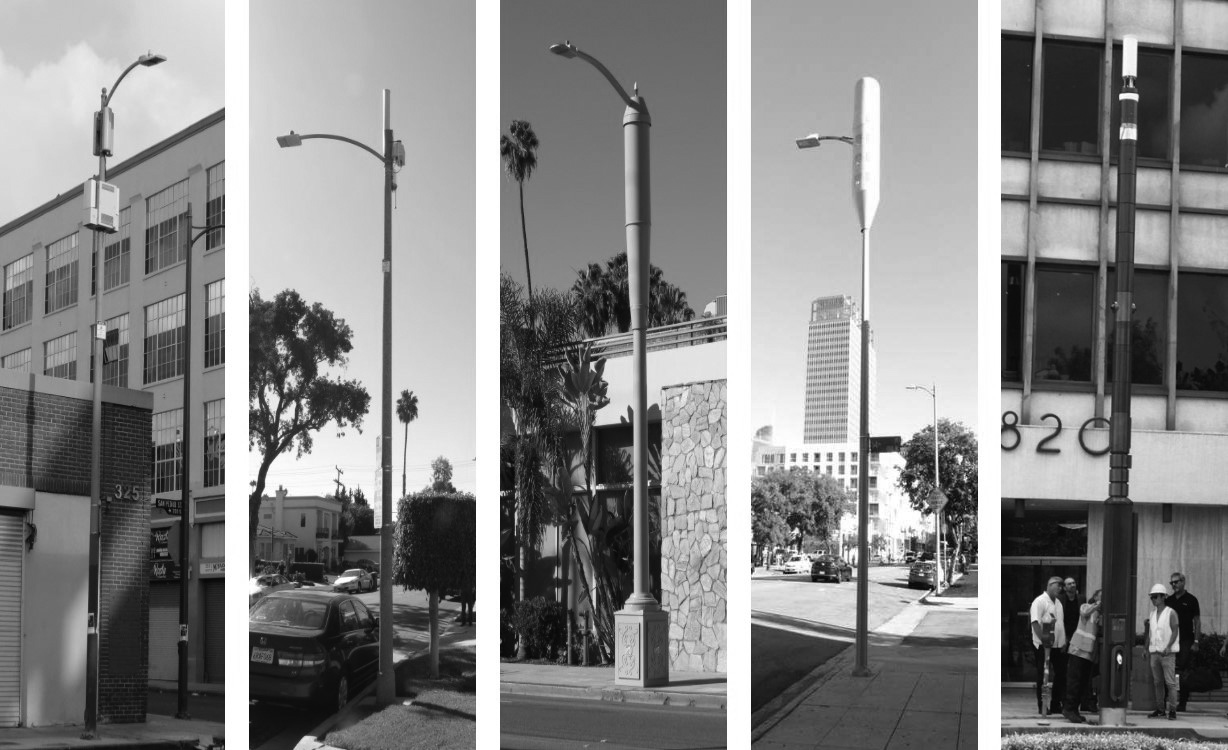 |
|
| (2019)^^ - Above are several designs and evolution of pole designs ('Smartpoles') which integrate streetlight and telecommunication equipment (cell sites). |
Historical Notes In 2015, the LA City Bureau of Streetlighting kicked off a program that integrates telecommunication companies’ cell sites with newly installed streetlight electroliers. The combination streetlights (called ‘Smartpoles’) have gone through several iterations of designs as can be seen in the above image. Originally installed in the Hollywood area only, they can now be found throughout the City (200-plus as of 2020). |
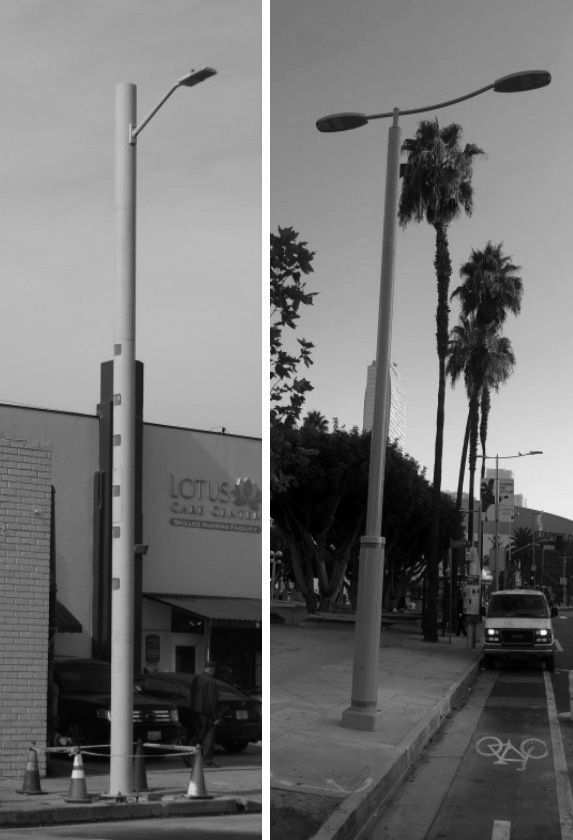 |
|
| (2020)^.^ - Hundreds of these combination streetlight-cell tower 'Smartpoles' have been installed throughout the City. (initially in the Hollywood area). |
Union Metal (UM-70149)
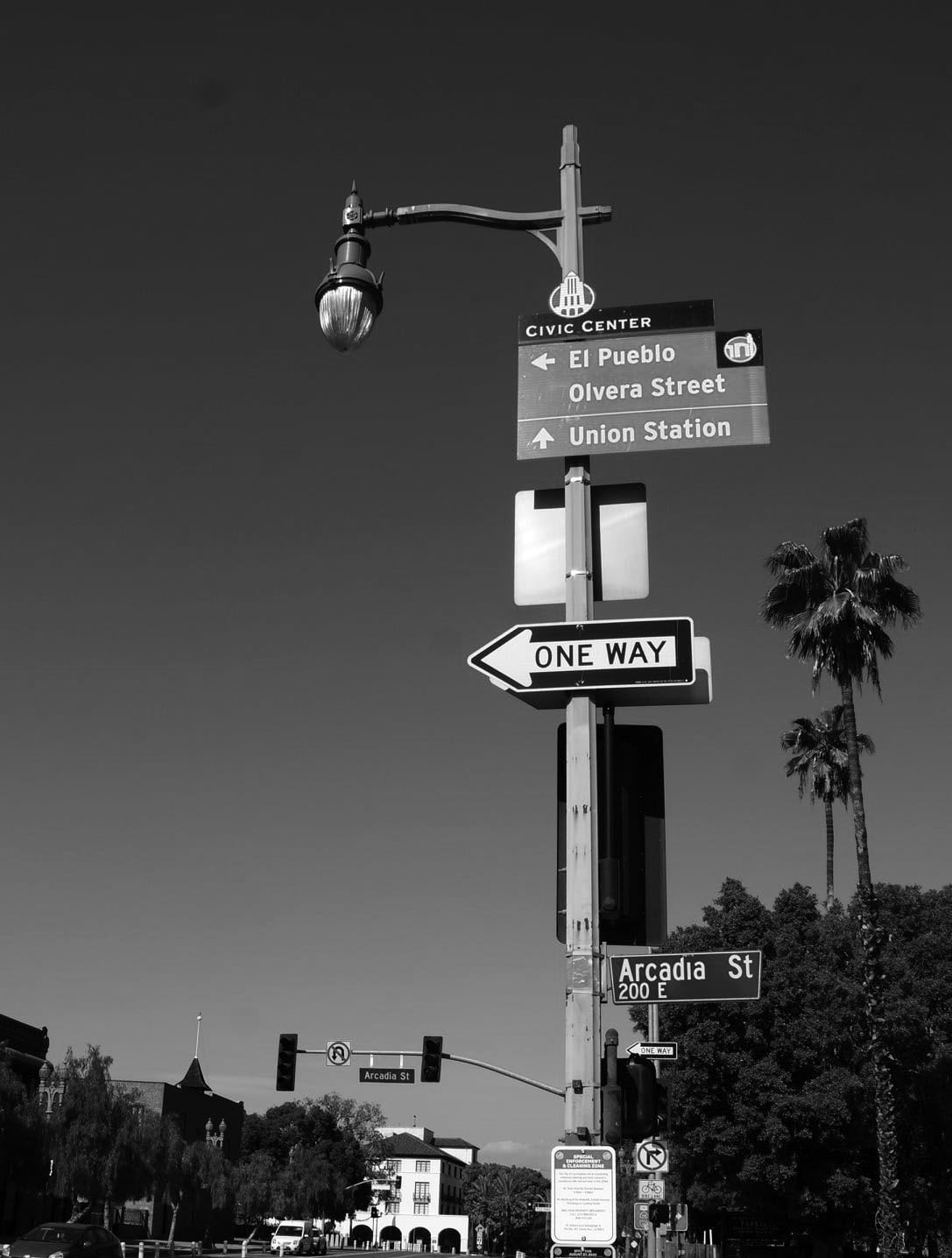 |
|
| (2021)^ – View loking North on Los Angeles Street at Arcadia Street showing a Union Metal (UM-70149) streetlight with side-mounted teardrop fixture. The Old Plaza, the birthplace of Los Angeles, is off to the left. Photo by Glen Norman |
Historical Notes The Union Metal (UM-70149) streetlight dates back to the early 1950s. |
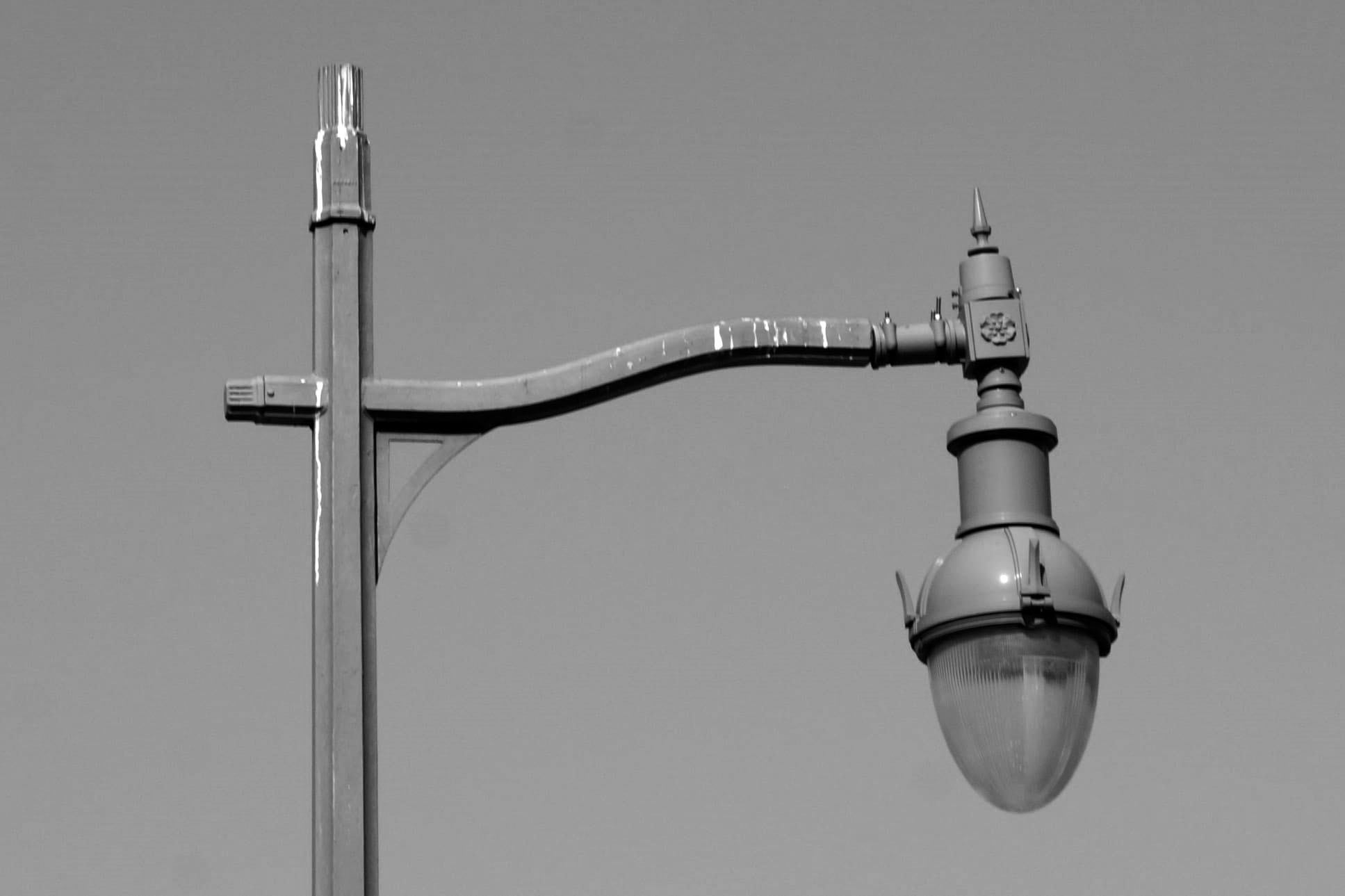 |
|
| (2021)^ – Close-up view showing the side-mounted teardrop fixture (Lumec RN 20 luminaire) on the UM-70149 streetlight. Photo by Glen Norman |
Historical Notes The Lumec RN 20 luminaire would have replaced a Mercury or HPS cobra. But, that cobra in turn had replaced what looks to be the original side-mounted teardrop fixture. Note the typical "L.A." finial; we also see it on the CD 929 and CD 923 street lights among others. |
Sternberg “Richmond” Streetlight
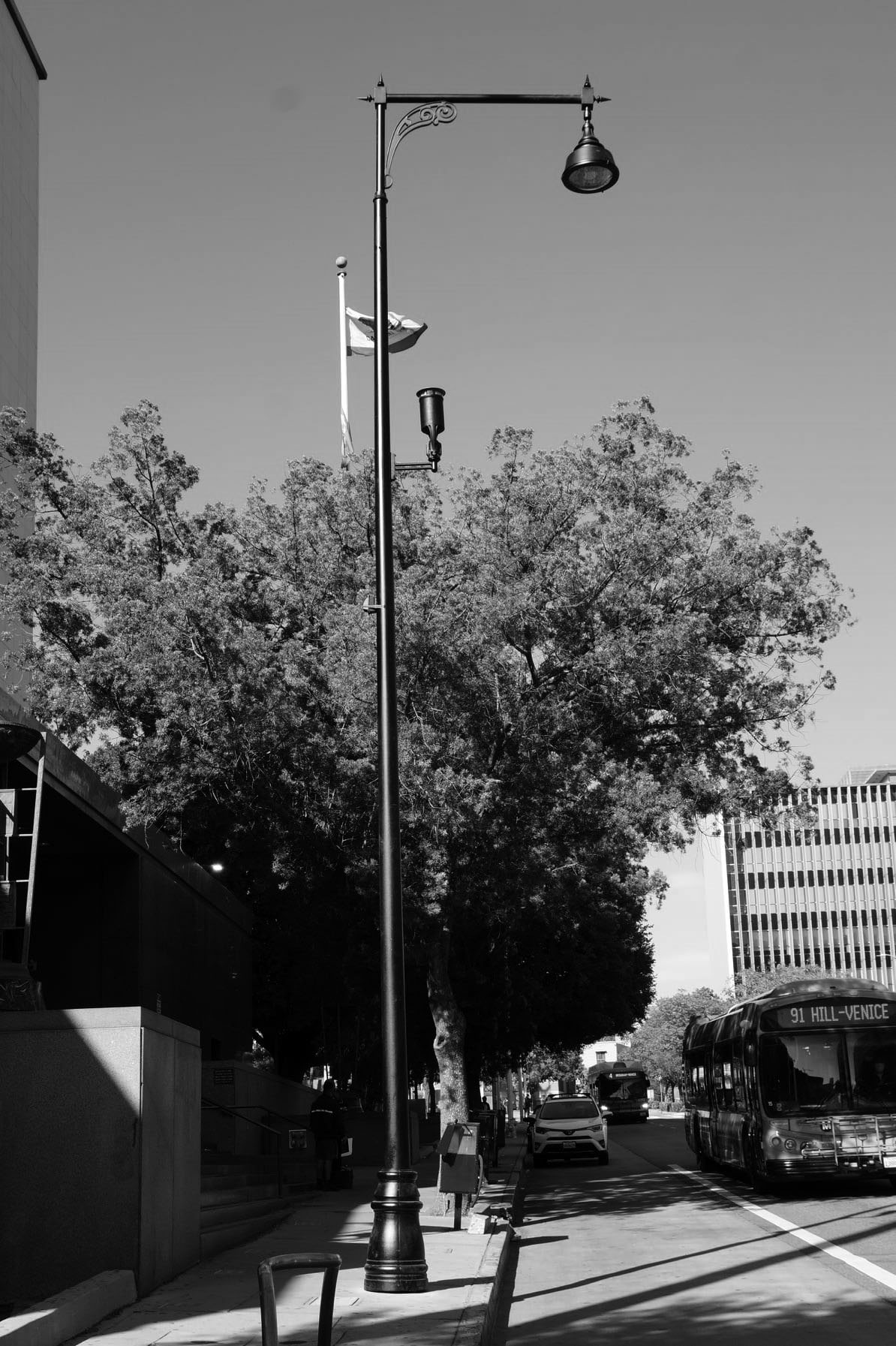 |
|
| (2021)^ - View looking North on Hill Street, just North of West 1st Street showing a Sternberg “Richmond” streetlight next to the L.A. County Courthouse. Photo by Glen Norman |
Historical Notes "So why is this here? This was the only one around. It's definitely NOT the winner nor any of the entries in the recent "L.A. Lights the Way" competition. It also does not appear on any of the LABSL maps. Maybe erected for a movie or TV shoot, given the Courthouse background? And what's with that little upward pointing thing about 3/4 of the way up the pole? It's too high to benefit the sidewalk and is pointed in the wrong direction." –Glen Norman |
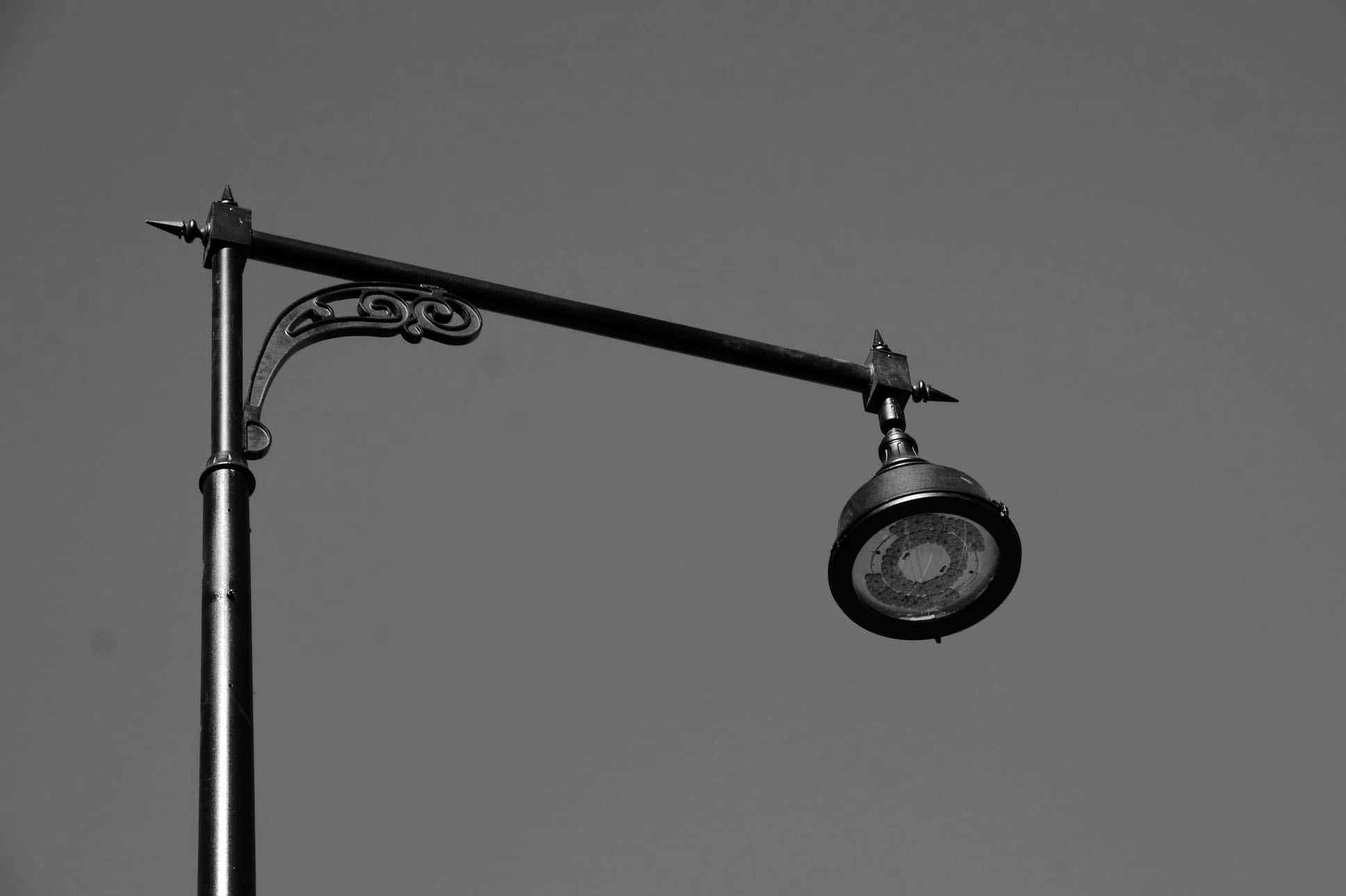 |
|
| (2021)^ - Close-up view of the Sternberg “Richmond” streetlight with teardrop LED fixture resembling a shower head. Photo by Glen Norman |
Beverly Boulevard Bridge
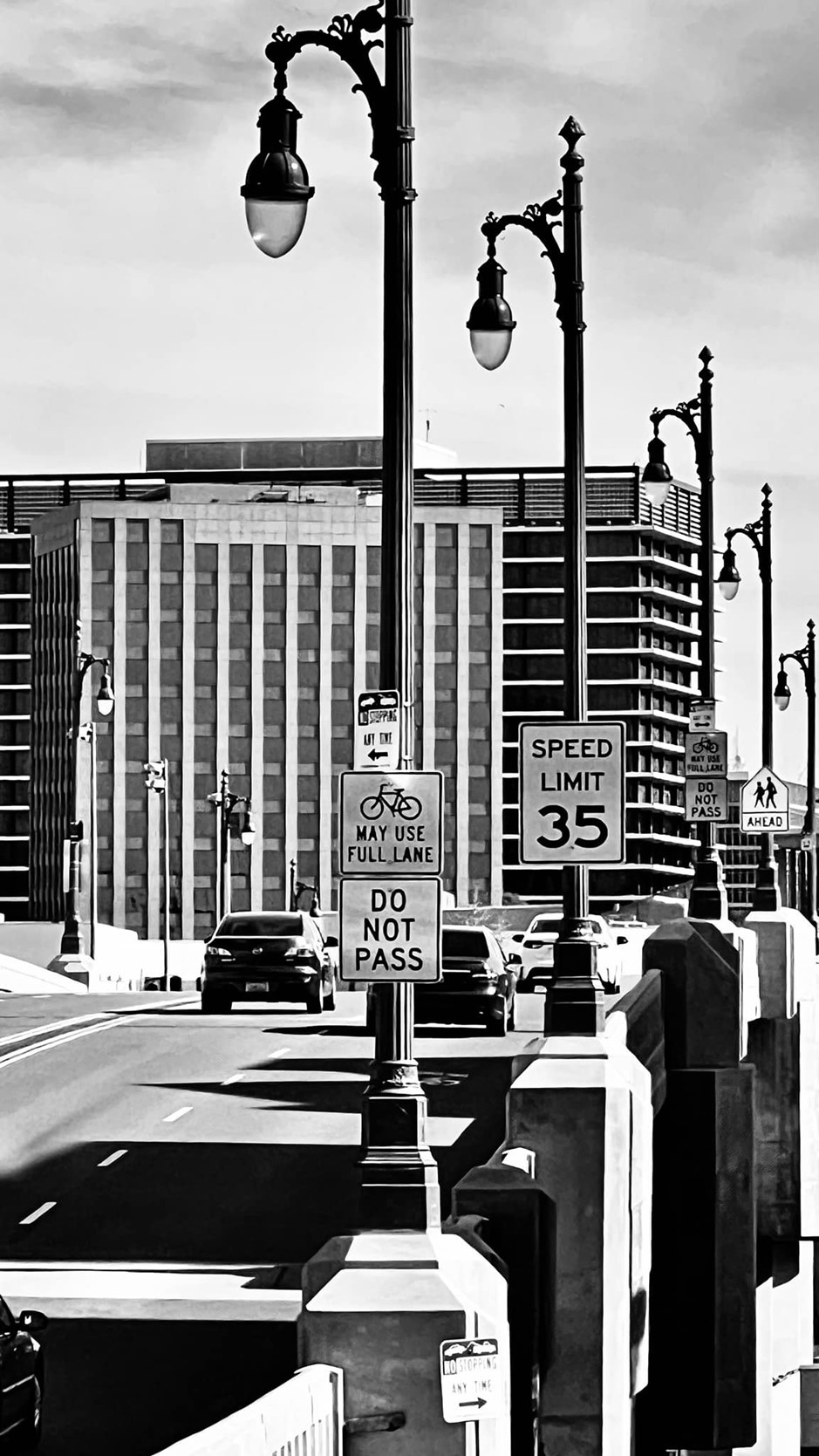 |
|
| (2023)* - View looking east toward the DWP building on the Beverly Boulevard Bridge over Glendale Boulevard showing newly installed teardrop electroliers lining both sides of the bridge. Photo by Carlos G. Lucero |
Broadway Rose
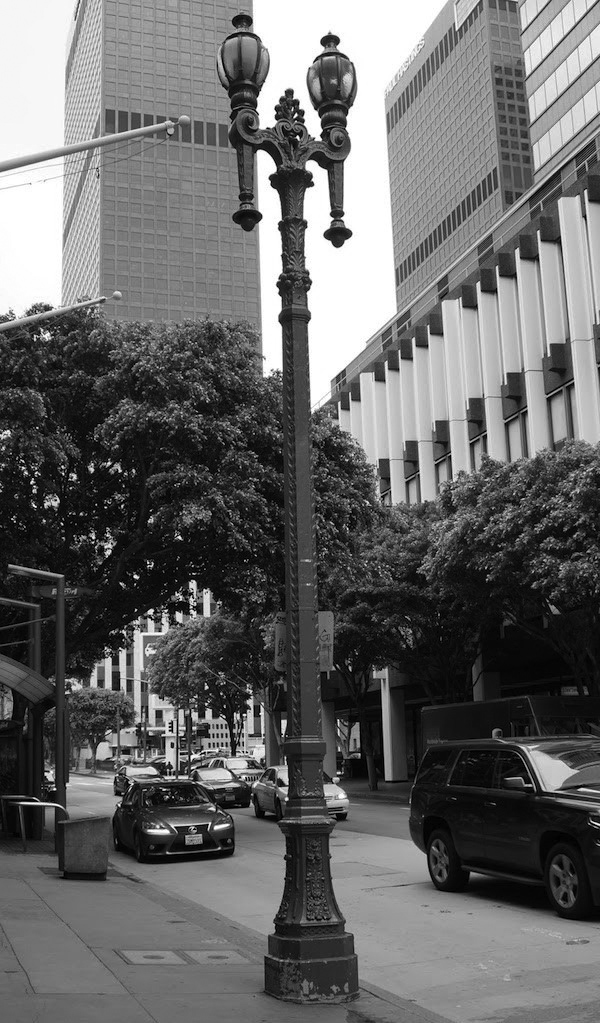 |
|
| (2017)^.^ - The Broadway Rose in the wild, Downtown L.A. Photo: Glen Norman |
Historical Notes Marked by three ornate ribbons of roses climbing up their safts, the eponymous Broadway Roses, designed by a General Electric engineer and originally installed in 1919, used to extend from Aliso Street to Pico Boulevard. Given that Broadway was the first L.A. street to have ornamental lights, hailed in the papers as “the radiant way,” this lamp’s lavish design should come as no surprise. (In fact, the Roses originally shared Broadway with an even grander, more filigreed type of post—the Spanish Renaissance-inspired Broadway Special, designed by the same engineer.) The response was overwhelming: “This is one of the most elaborate jobs of ornamental electroliers ever made on the coast,” the Los Angeles Times observed, “and is a 100 percent home product.” Unfortunately, the excitement didn’t last. During the 1950s, the shafts and luminaires of the Broadway Roses were replaced with more functional, higher intensity, yet decidedly more somber CD-913 overheads, leaving only the original bases intact. Today there are only a handful of complete models remaining in Los Angeles, which can be found running down Sixth Street between Olvie and Flower Streets. The Broadway Specials, incidentally, have vanished altogether.* |
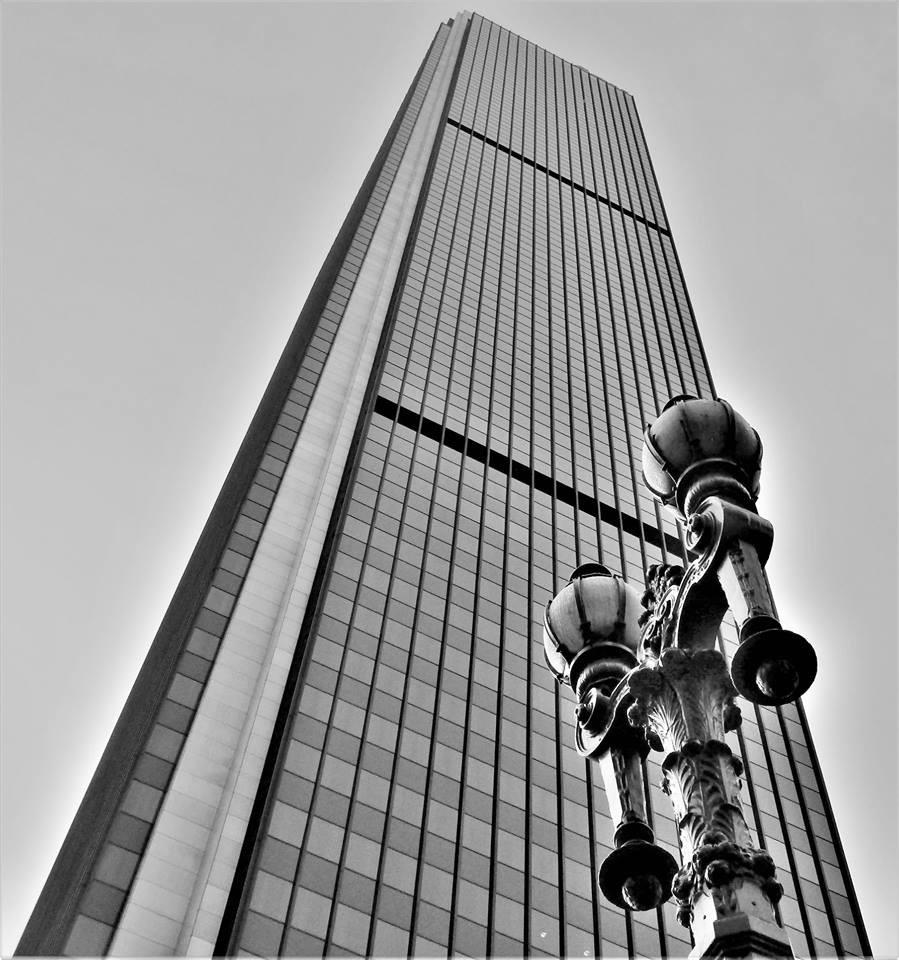 |
|
| (2018)^.^ – View looking up at the ornate dual lamp Broadway Rose with the 1973-built, 860-foot tall Aon Building behind it. |
UM-1906 (Contemporary Views)
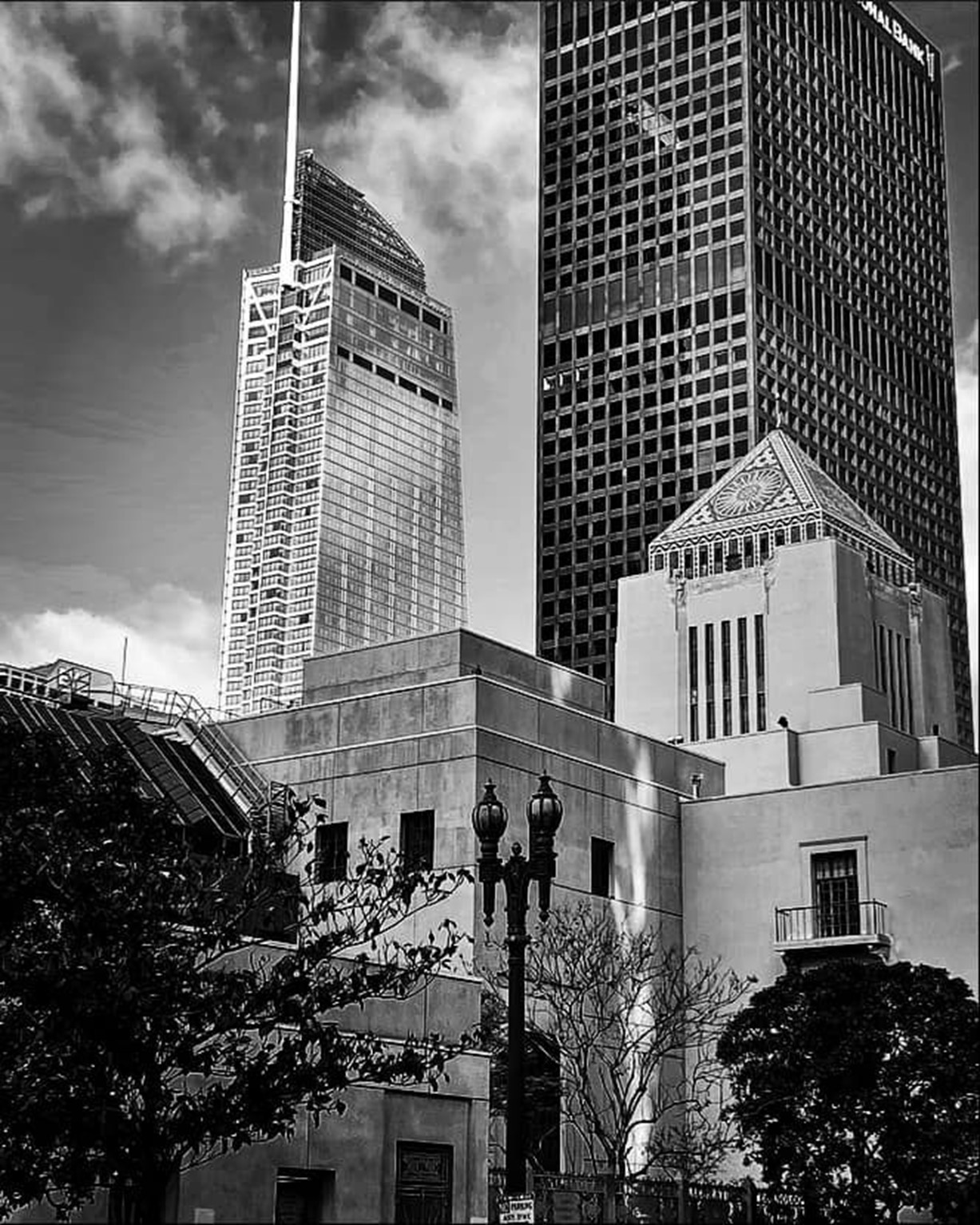 |
|
| (2022)* – An ornate dual-lamp UM (Union Metal) 1906 electrolier stands in front of the Los Angeles Central Library with the Wilshire Grand Center and City National Bank buildings seen in the background. View is looking SW from 5th Street. Photo by Carlos G. Lucero |
Historical Notes These dual-lamp electroliers (UM-1906's) were originally installed in the mid 1920’s. They were manufactured by the Union Metal Company of Canton, Ohio. The Bureau of Street Lighting still uses these UM-1906's in select areas of Downtown Los Angeles. |
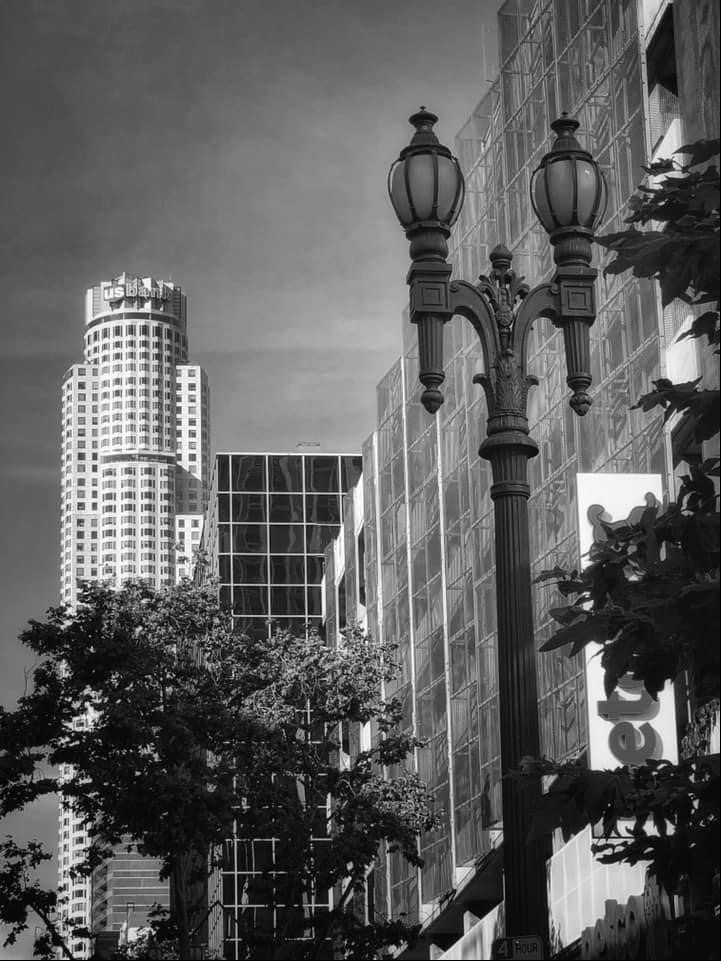 |
|
| (2020)^.^ – View looking down Hope Street at the U.S. Bank Building with a beautiful dual-lamp UM (Union Metal) 1906 electrolier seen in the foreground. Photo by Carlos G. Lucero |
Historical Notes Although similar in many ways, the dual-lamp UM-1906 should not be confused with the Broadway Rose and Broadway Special. Click HERE to see the differences. |
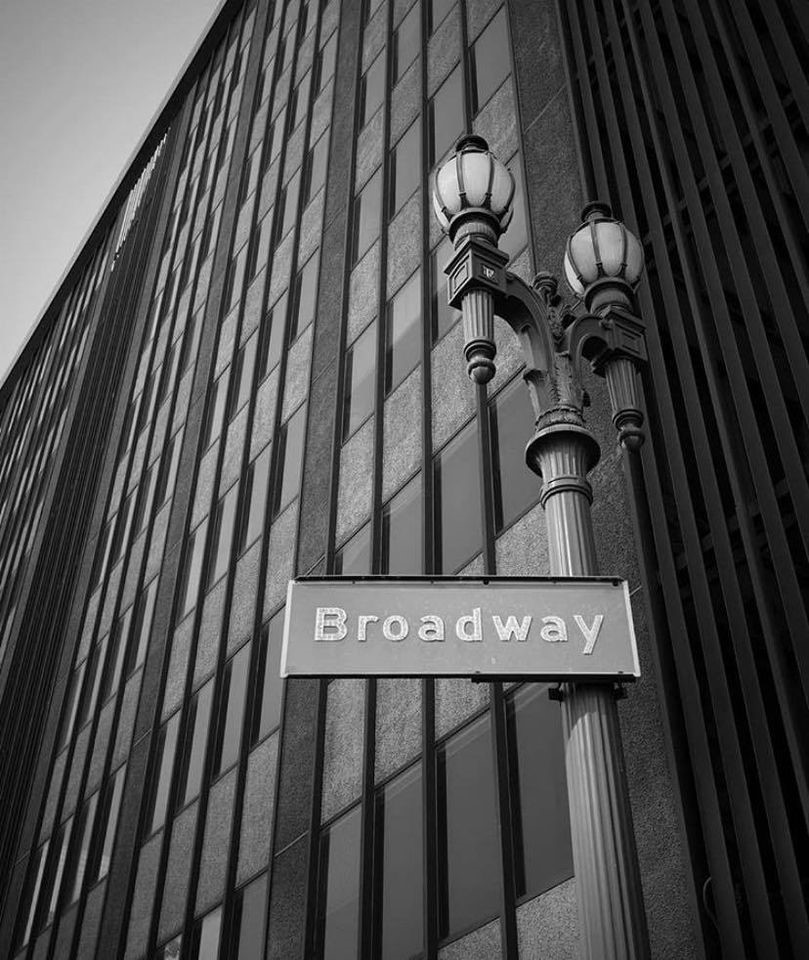 |
|
| (2020)^.^ - Dual-lamp UM-1906 electrolier located on Broadway in Downtown L.A. Photo courtesy of Historic Core |
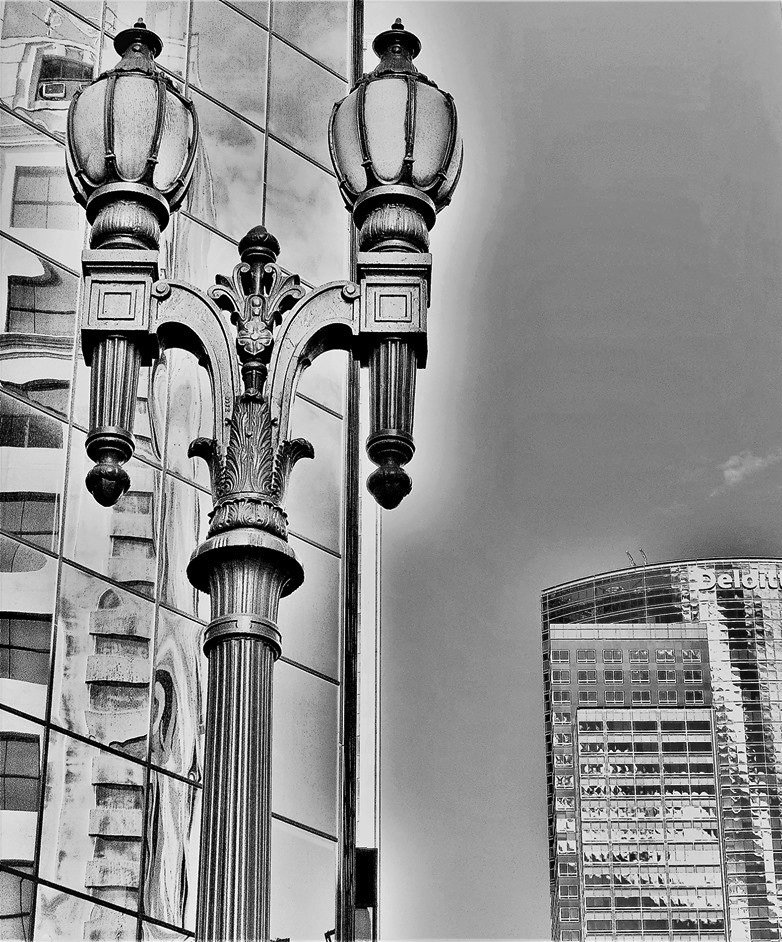 |
|
| (2019)^.^ – Dual-lamp UM-1906 electrolier at 7th and Grand in Downtown L.A. Photo by Howard Gray |
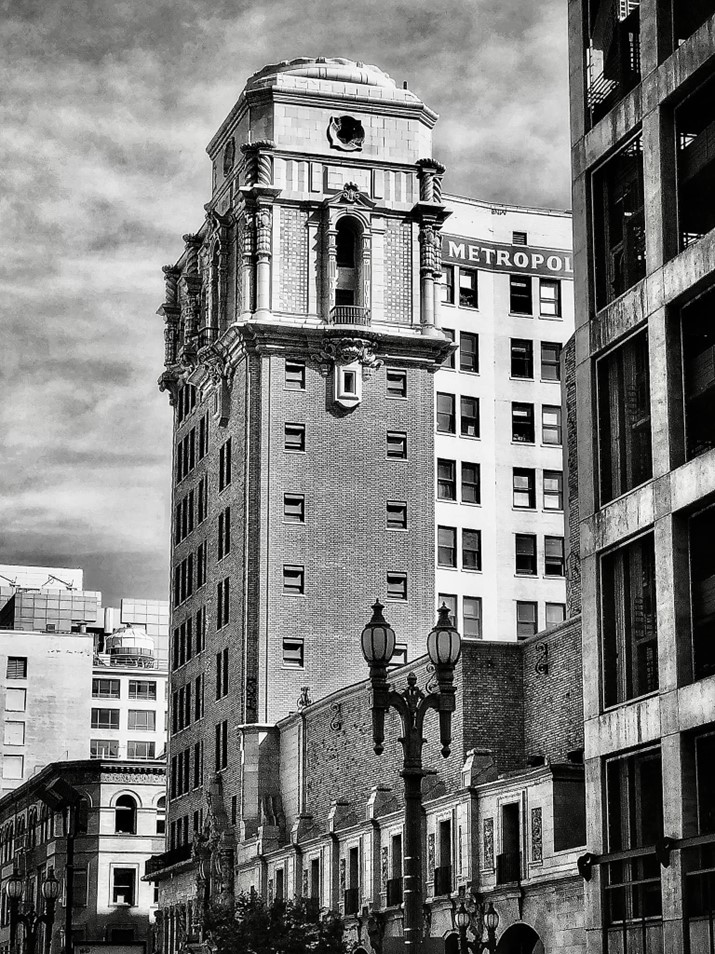 |
|
| (2022)^ - A dual-lamp UM-1906 stands on 3rd Street in front of the Million Dollar Theater (aka Grauman's Theatre, aka Edison Building and later MWD Building), Located on the SW corner of Broadway and 3rd Street. Photo by Carlos G. Lucero |
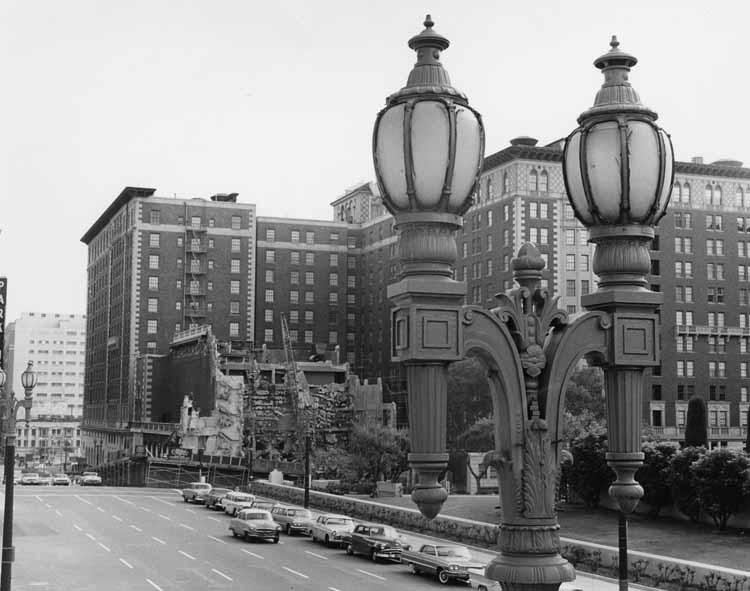 |
|
| (1964)^^^ – Close-up detailed view of a dual-lamp (UM-1906) electrolier in downtown Los Angeles. View is looking east on 5th street toward Grand Ave. Photo by William Reagh |
Historical Notes In the photo above, the large building in the distance is the Biltmore Hotel and the building being demolished is the Biltmore Theatre, built in 1924. Also, the LA Central Library is to the right (out of view). |
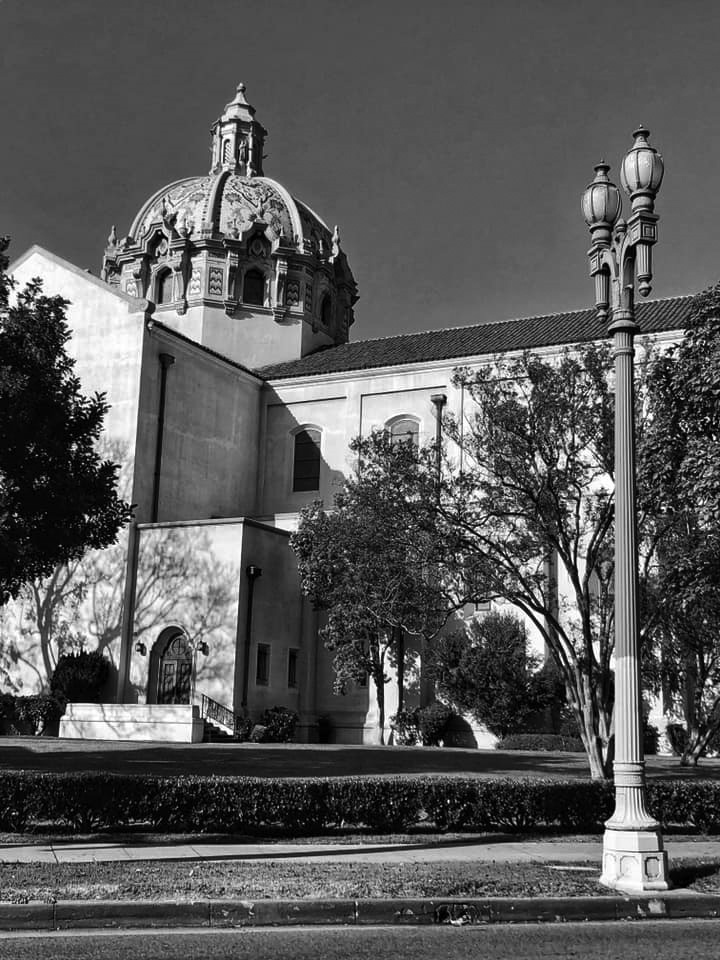 |
|
| (2020)^.^ - A UM-1906 standing tall near the intersection of Figueroa and Adams in front of the St. Vincent Catholic Church. Photo by Carlos G. Lucero |
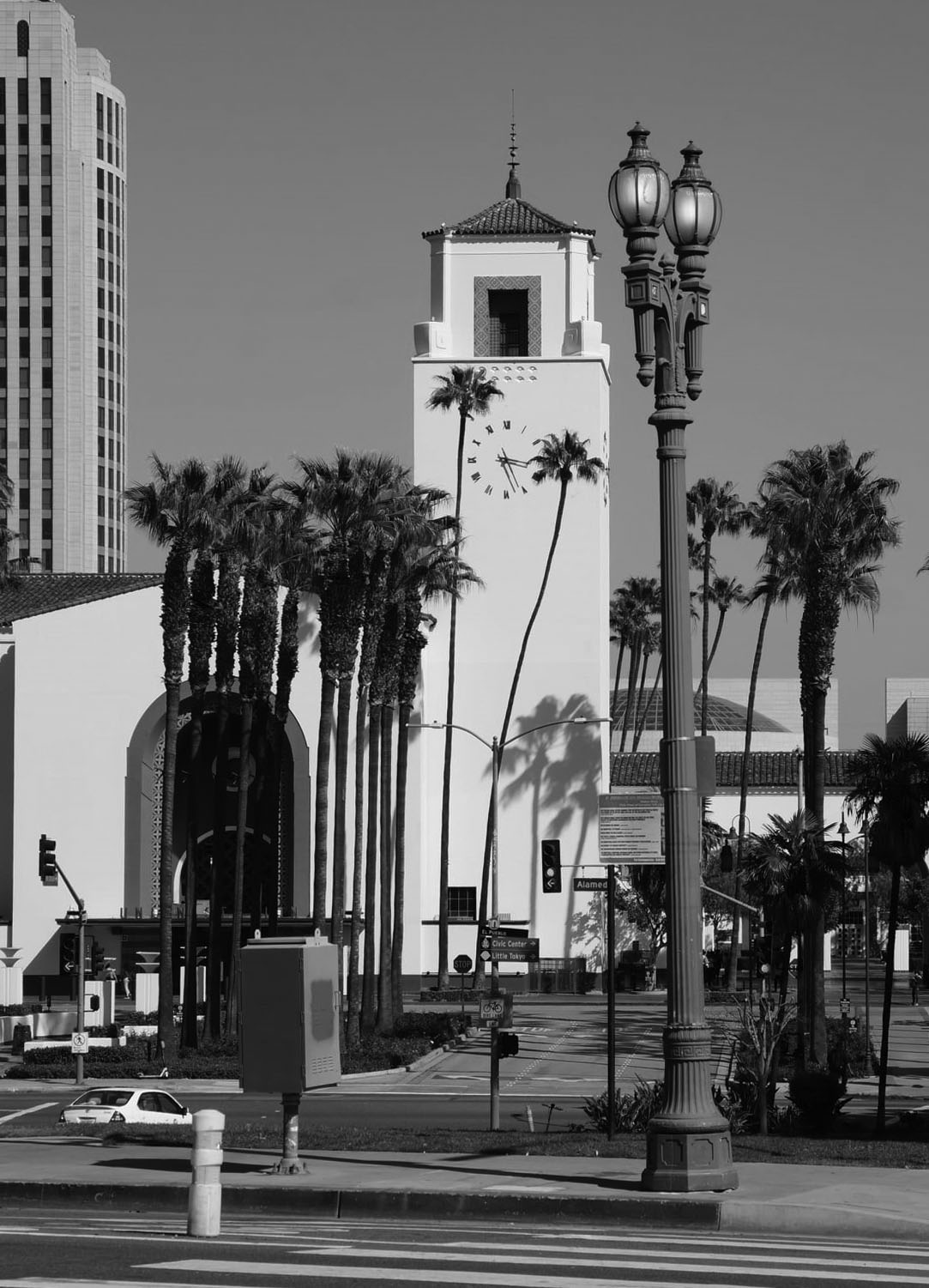 |
|
| (2021)^ – Palm Trees, the Art Deco/Spanish Revival Union Station, and a UM-1906 streetlight. Photo by Glen Norman |
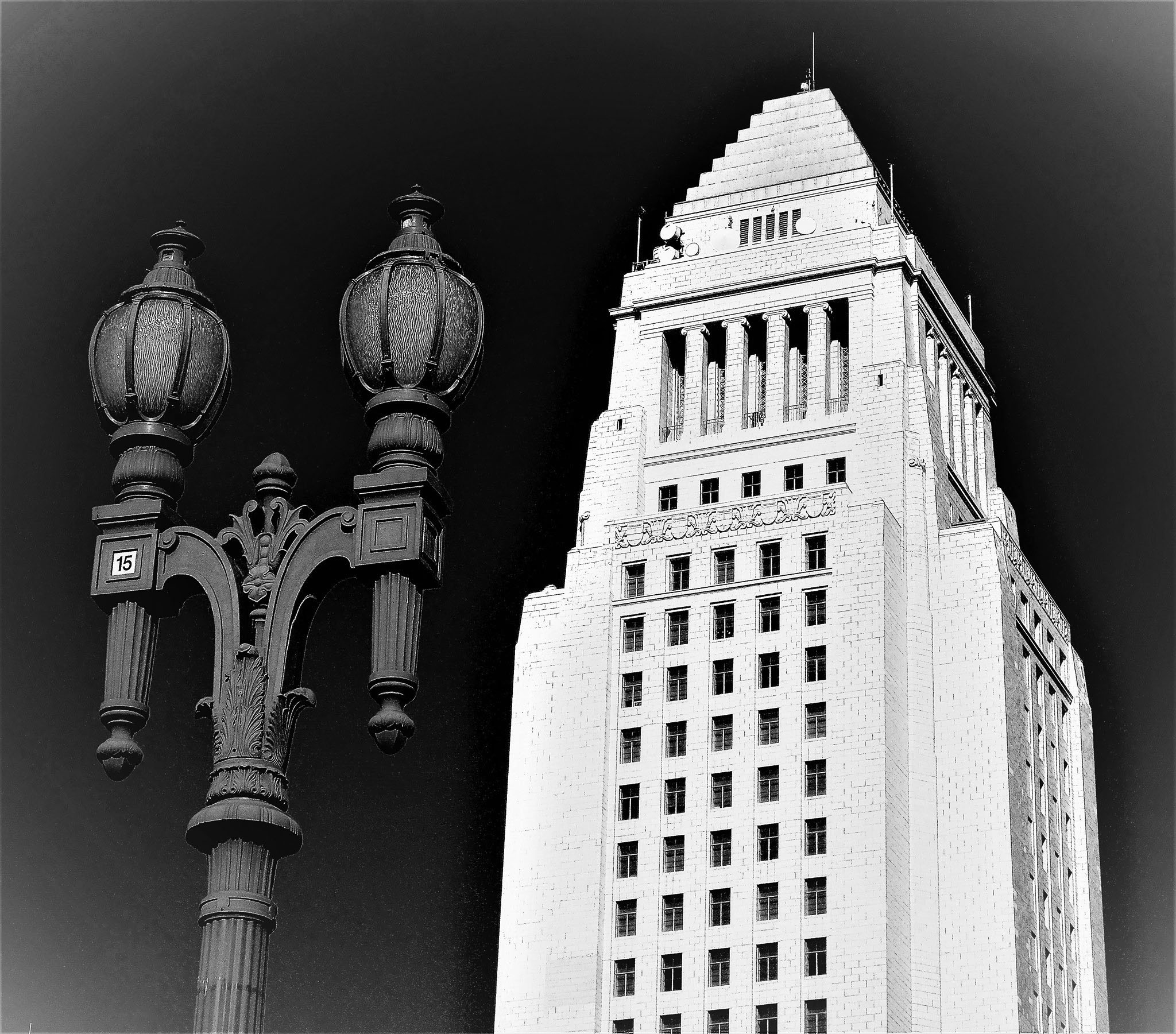 |
|
| (2020)^.^ – Looking up at a dual-lamp UM-1906 streetlight on Main Street with City Hall in the background. Photo by Howard Gray |
Historical Notes Although there are a limited number of these Union Metal Electroliers still standing today (mostly refurbished), hundreds were originally installed in the mid 1920's. They replaced the popular five-globe Llewellyn streetlights mainly in Downtown Los Angeles. Click HERE to see more. |
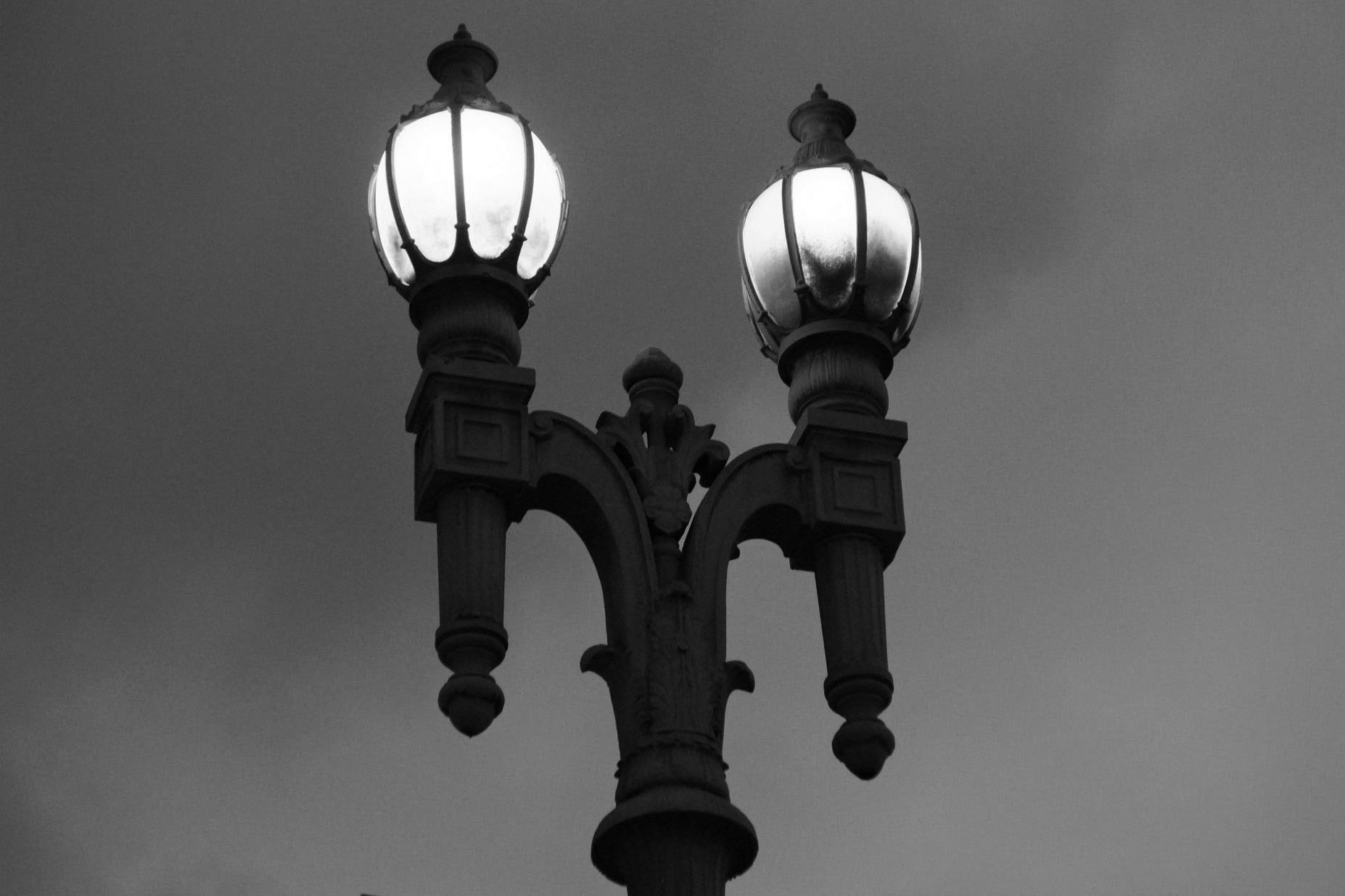 |
|
| (2021)* – Close-up view of a UM-1906 streetlight at dusk, located at the T-intersection of West 7th Street and Columbia Avenue. Photo by Glen Norman |
Wilshire Special (DTLA - Contemporary Views)
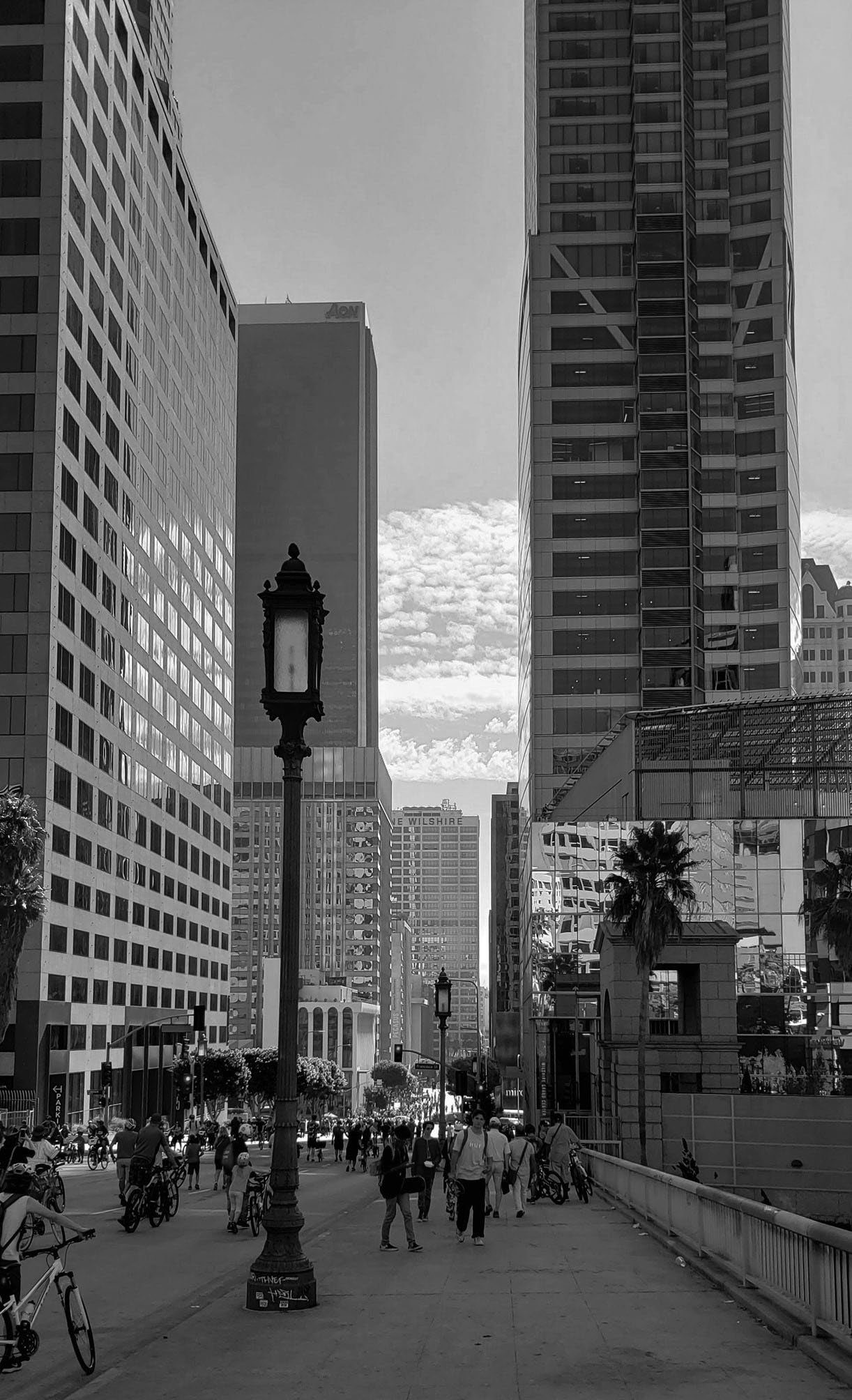 |
|
| (2019)* – CicLAvia event on Wilshire Boulevard as it crosses the Harbor Freeway with Wilshire Specials lining both sides of the street. The tall tower to the right is part of the Wilshire Grand Center. Photo by Gene Cabrera |
Historical Notes The first CicLAvia event, on October 10, 2010 opened a stretch of streets from East Hollywood through downtown Los Angeles into Boyle Heights. Over 100,000 people turned out, exceeding organizers’ expectations. The event itself was inspired by Ciclovia, a similar, annual open streets event taking place in Bogota, Colombia since 1974. Over 30 subsequent CicLAvia events have taken place in communities across Los Angeles County, usually covering a 5-10 mile stretch of city streets. Some of the locations used are Pasadena, South Los Angeles, Culver City, Thai Town and West Hollywood. In 2013, CicLAvia—To the Sea ran 15 miles from downtown Los Angeles to Venice Beach.* |
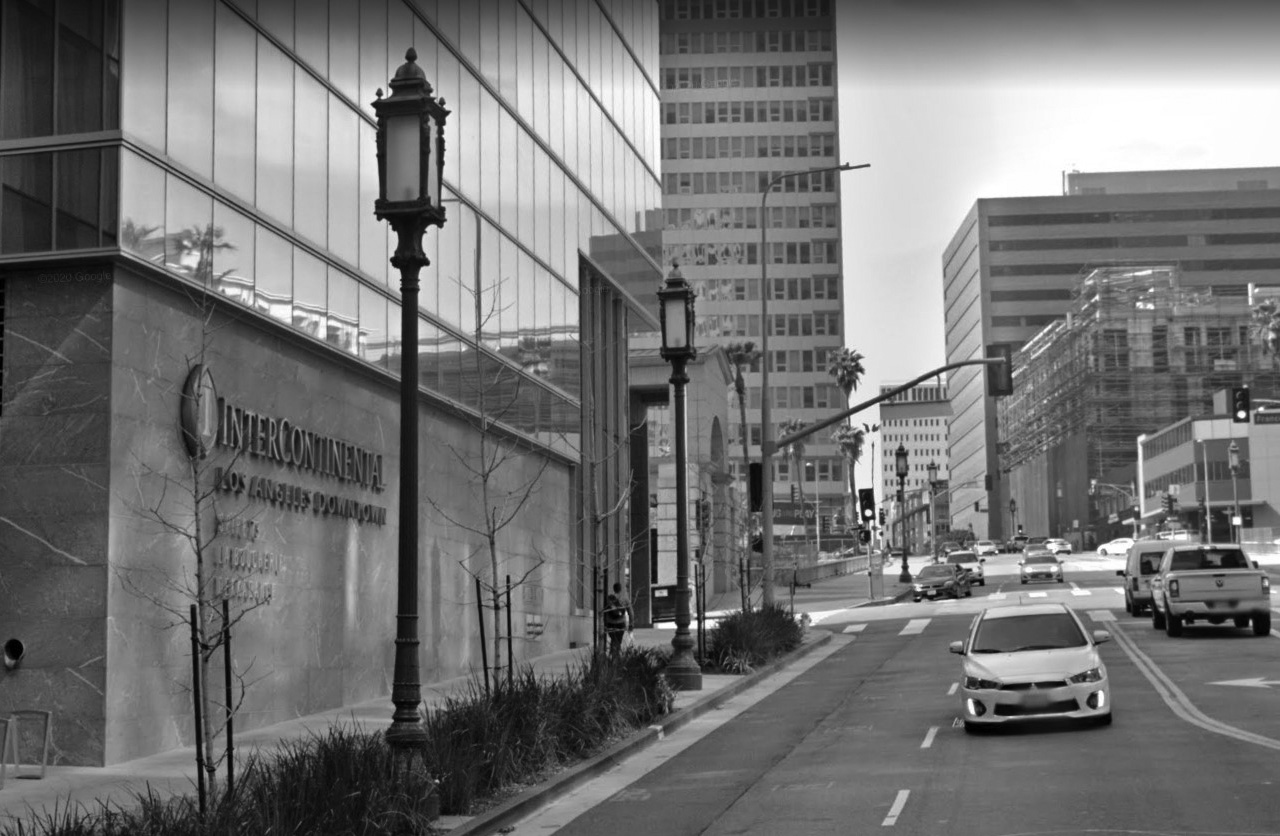 |
|
| (2019)^ – Google street view looking west on Wilshire Blvd toward Francisco Street showing Wilshire Specials in front of the Inter-Continental Hotel, part of the Wilshire Grand Center. |
Historical Notes The Wilshire Special streetlights were originally installed in 1928 along Wilshire Boulevard from Park View to Fairfax Ave. In the 1930s these ornate electroliers were also installed on the remaining sections of Wilshire all the way to downtown. Click HERE to see more on the history of the Wilshire Special. |
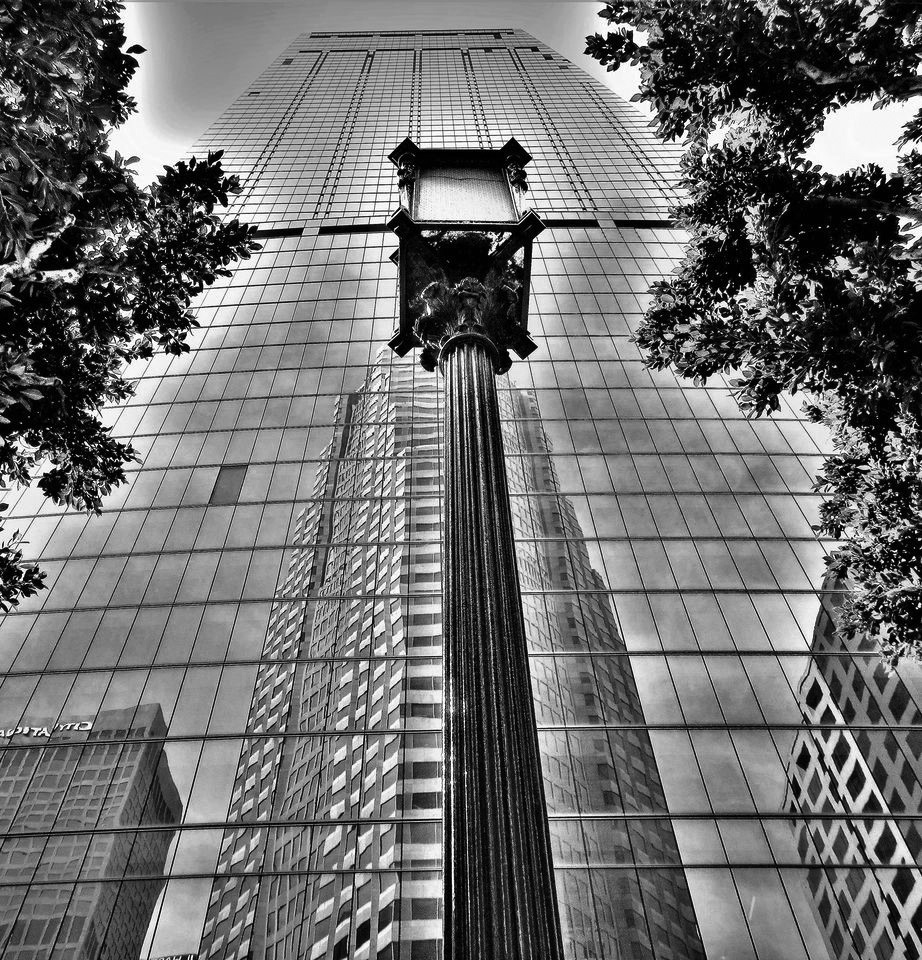 |
|
| (2020)^.^ – Looking up to the top of a Wilshire Special and the 1,100 feet tall Wilshire Grand Center. Photo by Howard Gray |
.jpg) |
|
| (2022)* – Detail close-up view of a Wilshire Special in DTLA all lit up. Click HERE to see more on the history of the Wilshire Special. |
The Llewellyn "Washington"
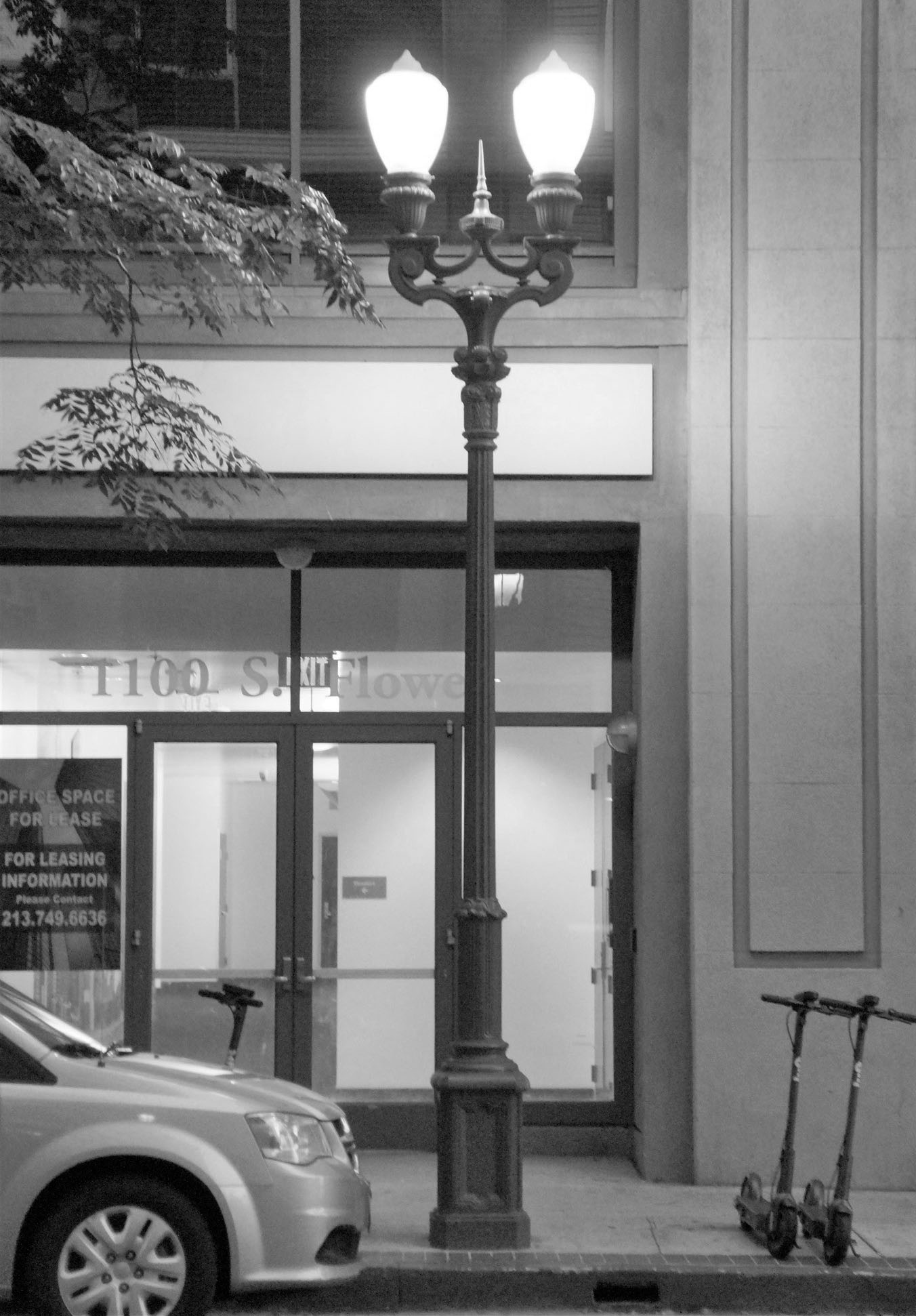 |
|
| (2019)^ - View showing the Llewelly “Washington” dual-lamp streetlight. It’s a look-alike cousin of the Llewellyn “Western” which is extinct. Photo by Glen Norman |
Historical Notes The Llewellyn "Washingtons" are no longer found on Washington Boulevard, but a small run of them can be found on West 11th Street between Broadway and Hope Street. |
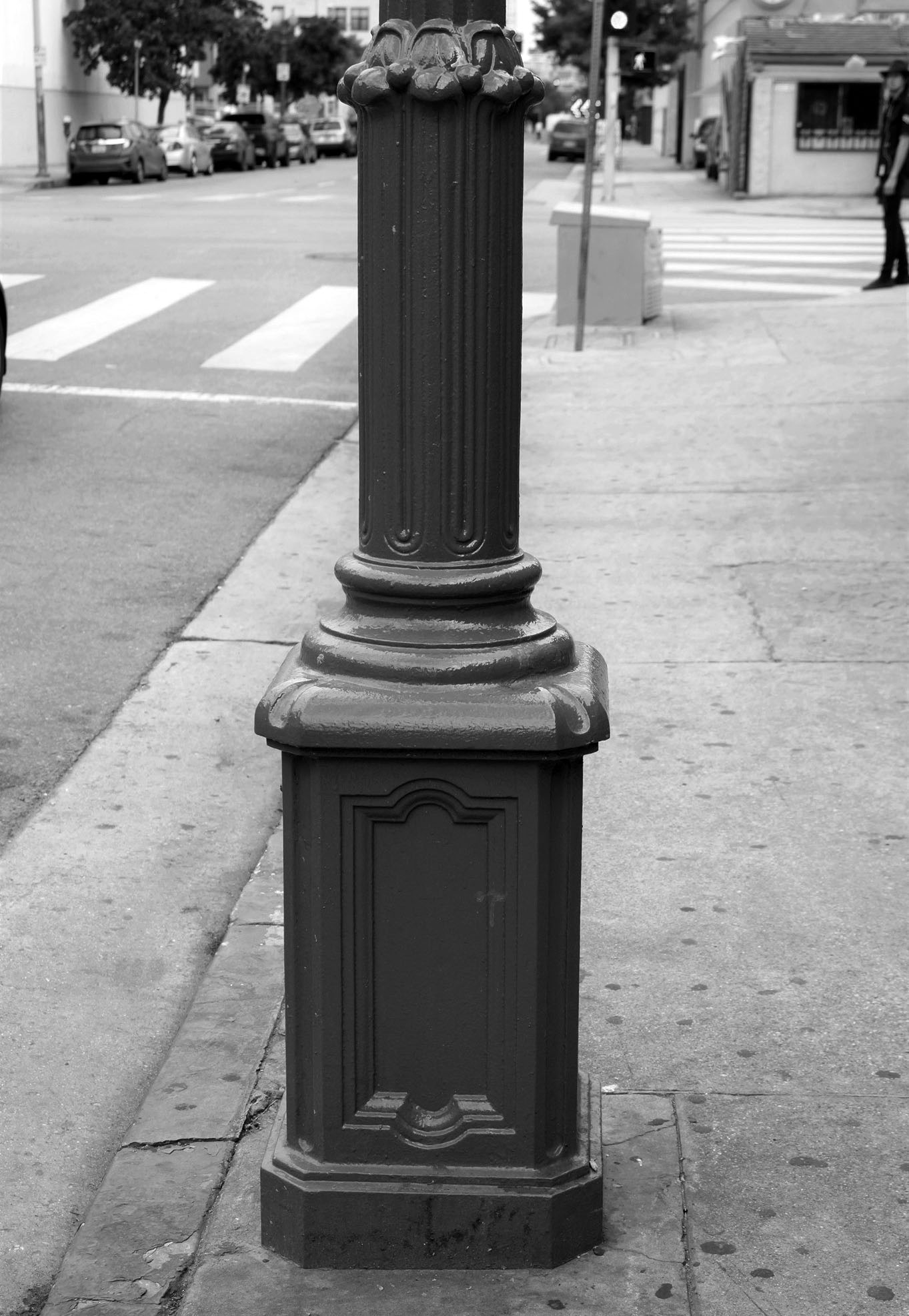 |
|
| (2016)^ - Close-up look at the base of a Llewellyn "Washington” streetlight. Photo by Glen Norman |
 |
|
| (2017)* - Close-up view of a Llewellyn "Washington" located in South Park, DTLA. Photo by Glen Norman |
Los Angeles Plaza
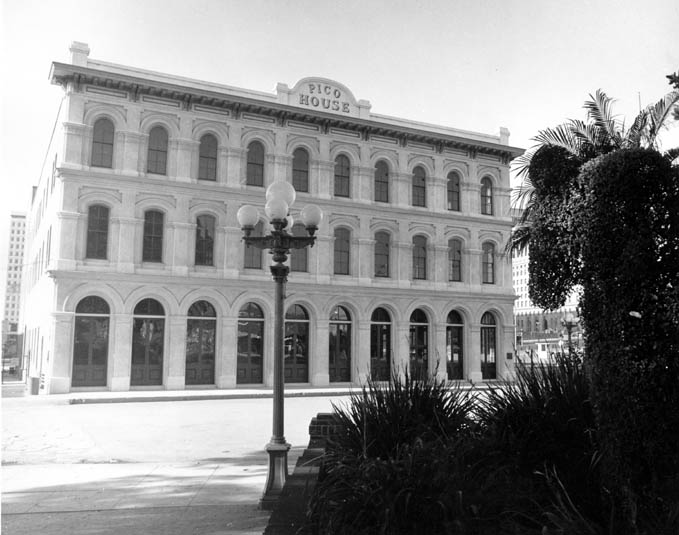 |
|
| (1970s)*#^ - 5-bulb ornate streetlight in located in the historic Los Angeles Plaza across the street from the Pico House. |
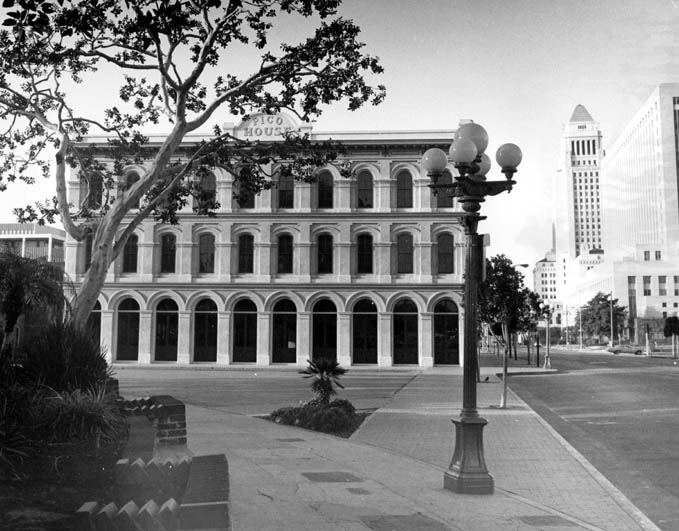 |
|
| (1977)^ - View of the Pico House from the L.A. Plaza with City Hall in the background. Ornate 5-lamp streetlight sits in the foreground. Click HERE to see more in Early Views of the L.A. Plaza. |
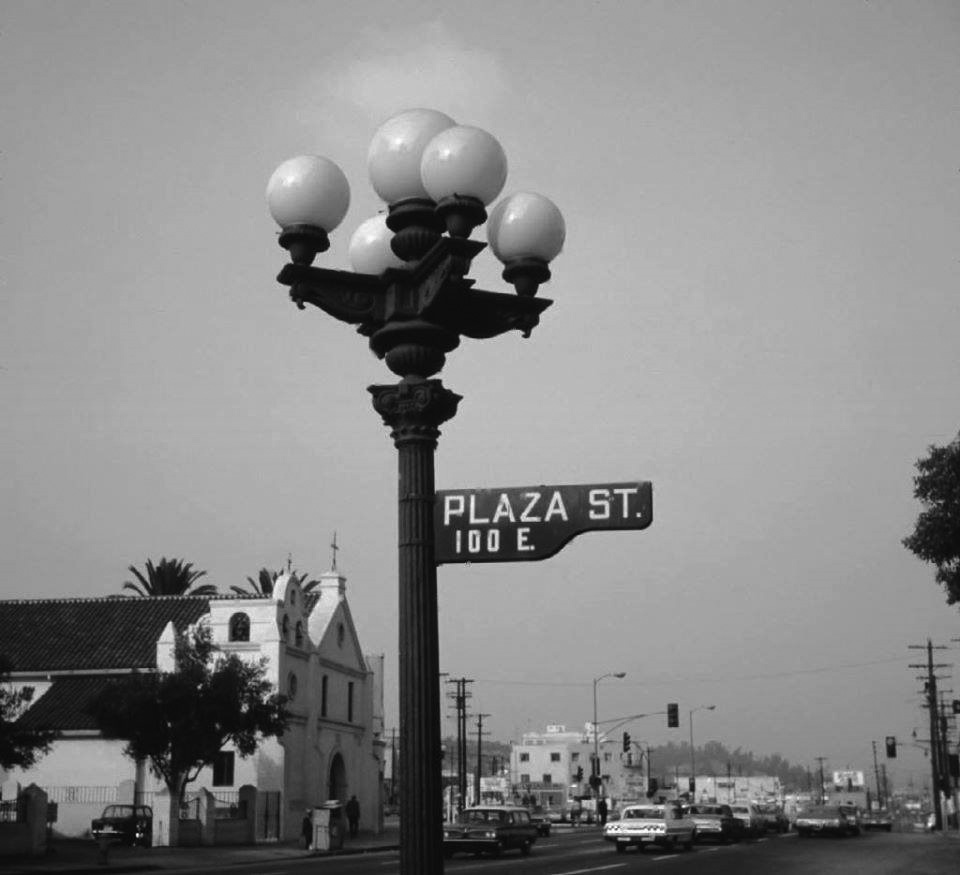 |
|
| (1969)^.^ - View looking northwest showing an ornate 5-globe Llewellyn Electrolier standing on the edge of the LA Plaza with the Old Plaza Church seen in the background. Photo by Glen Norman |
Historical Notes The most common of the incandescent multiple globe electroliers of the early 1900s were those manufactured by the Llewellyn Iron Works of Los Angeles. The firm became so identified with this style of street light that any multiple globe electrolier became commonly known as a Llewellyn. The Llewellyn Iron Works, founded in 1889‐1890, was one of the largest metal working facilities in Los Angeles. It manufactured structural steel – including that for the Bradbury Building (1893). |
From Gas to Electric Lights
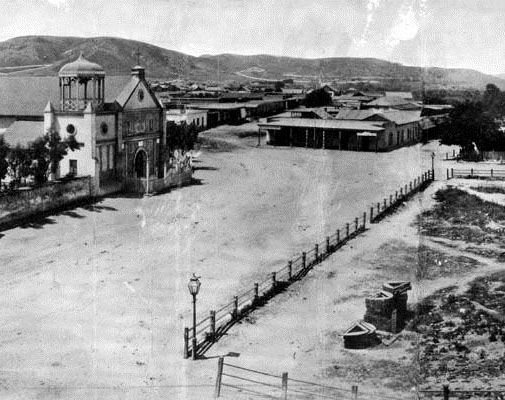 |
 |
|
| (1869) vs. (1969) - View looking NW showing the Old Plaza Church as seen from the Pico House. |
Historical Notes Click HERE to see more in Early Views of the L.A. Plaza. |
* * * * * |
5-Globe Llewellyn (Contemporary Views)
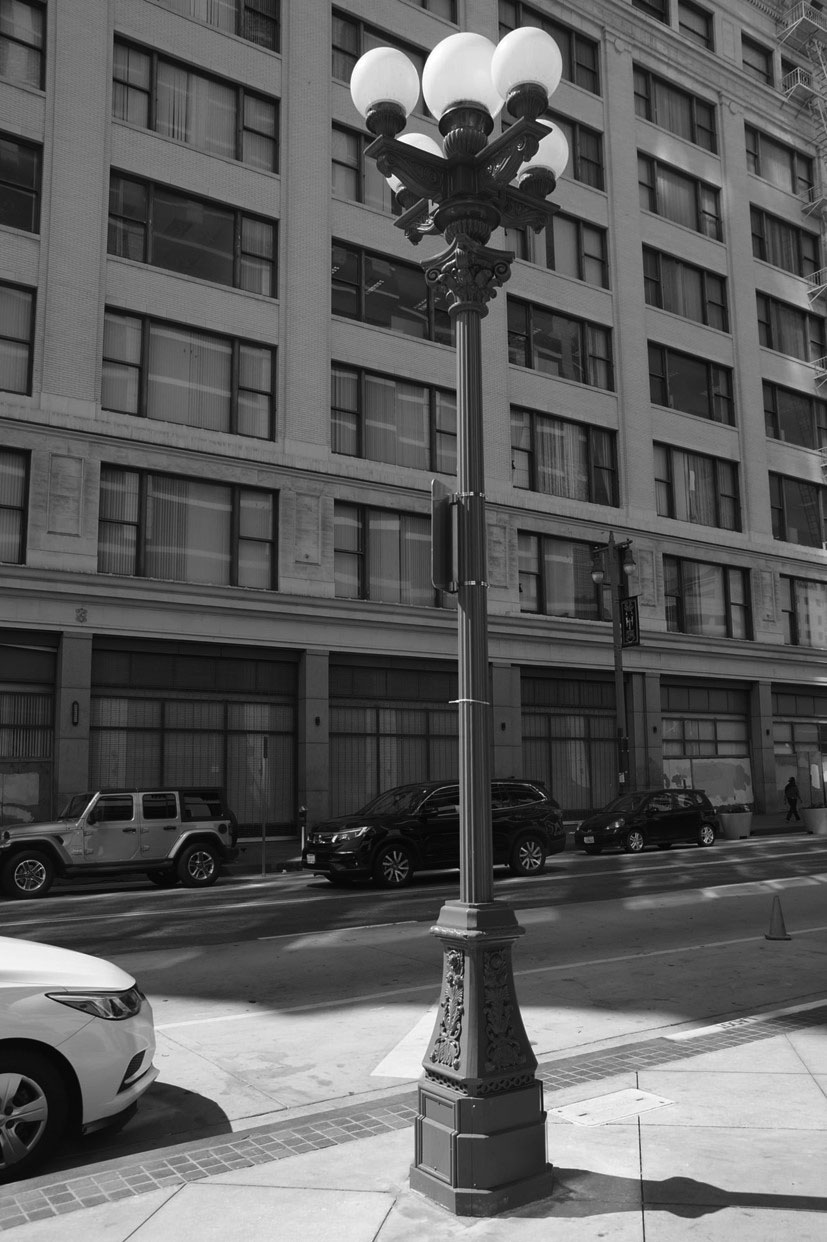 |
|
| (2021)* – View showing a 5-Globe Llewellyn on Broadway standing across the street from the original Broadway Department Store Building (built in 1913) on the SW corner of 4th and Broadway. Photo by Glen Norman |
Historical Notes The Llewellyns that populated Broadway from 1905 to 1919 had 7 globes. In fact, no other Llewellyn cluster light design in Los Angeles had more than 5 globes in deference to the Broadway originals. |
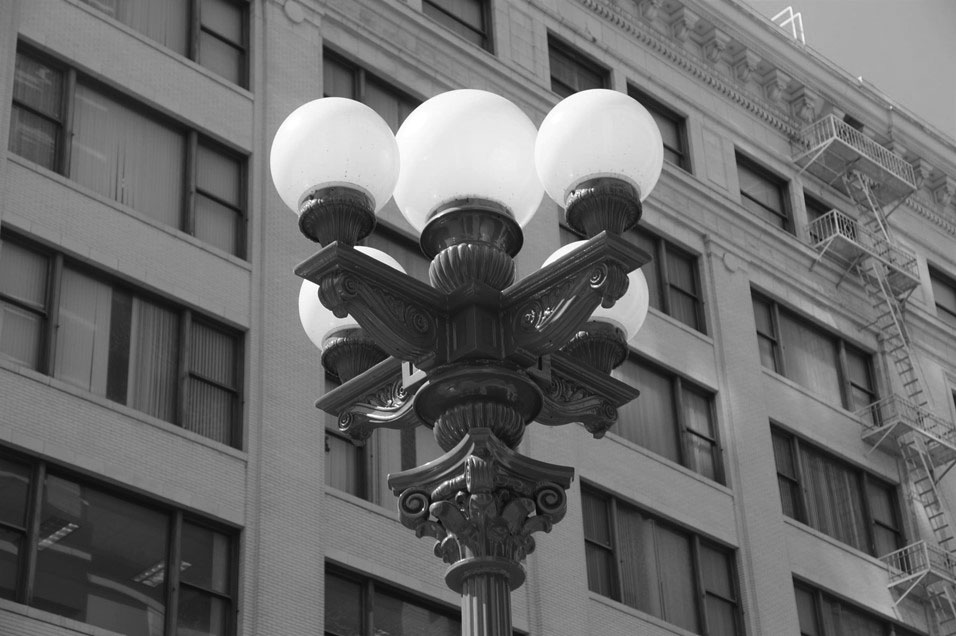 |
|
| (2021)* – Close-up view of the 5-Globe Llewellyn streetlight seen in previous photo. Photo by Glen Norman |
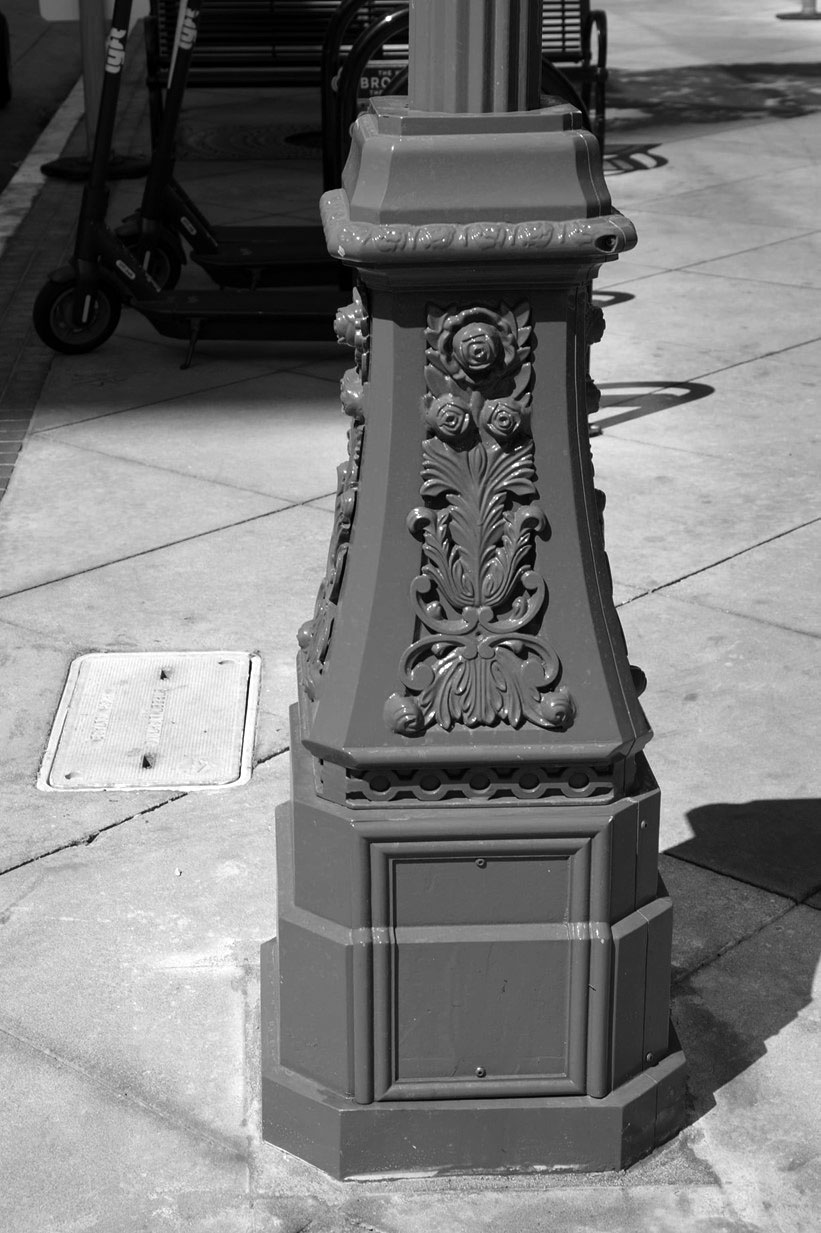 |
|
| (2021)*– Close-up view showing base of the 5-Globe Llewellyn streetlight on Broadway near 4th Street. Photo by Glen Norman |
Historical Notes This is a Rose base, modeled on and scaled down from the original 1919 bases that still populate Broadway. Keystone Iron and Steel Works produced the originals. |
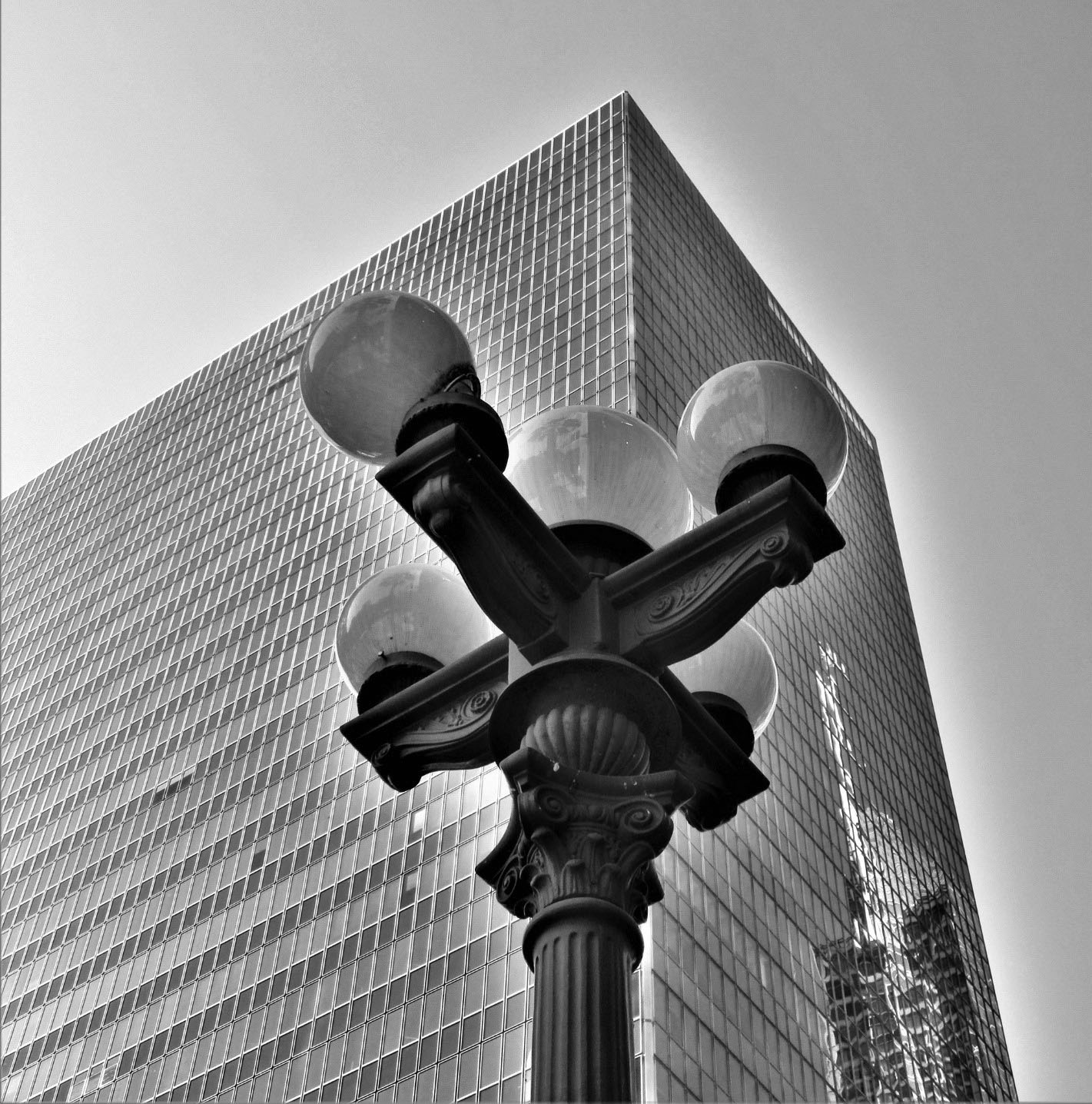 |
|
| (2020)^.^ - Looking up to the top of a refurbished 5-globe Llewellyn Electrolier in need of repair with the MCI Building in the background. The reflection of the Wilshire Grand Tower can be seen at right. Photo by Howard Gray |
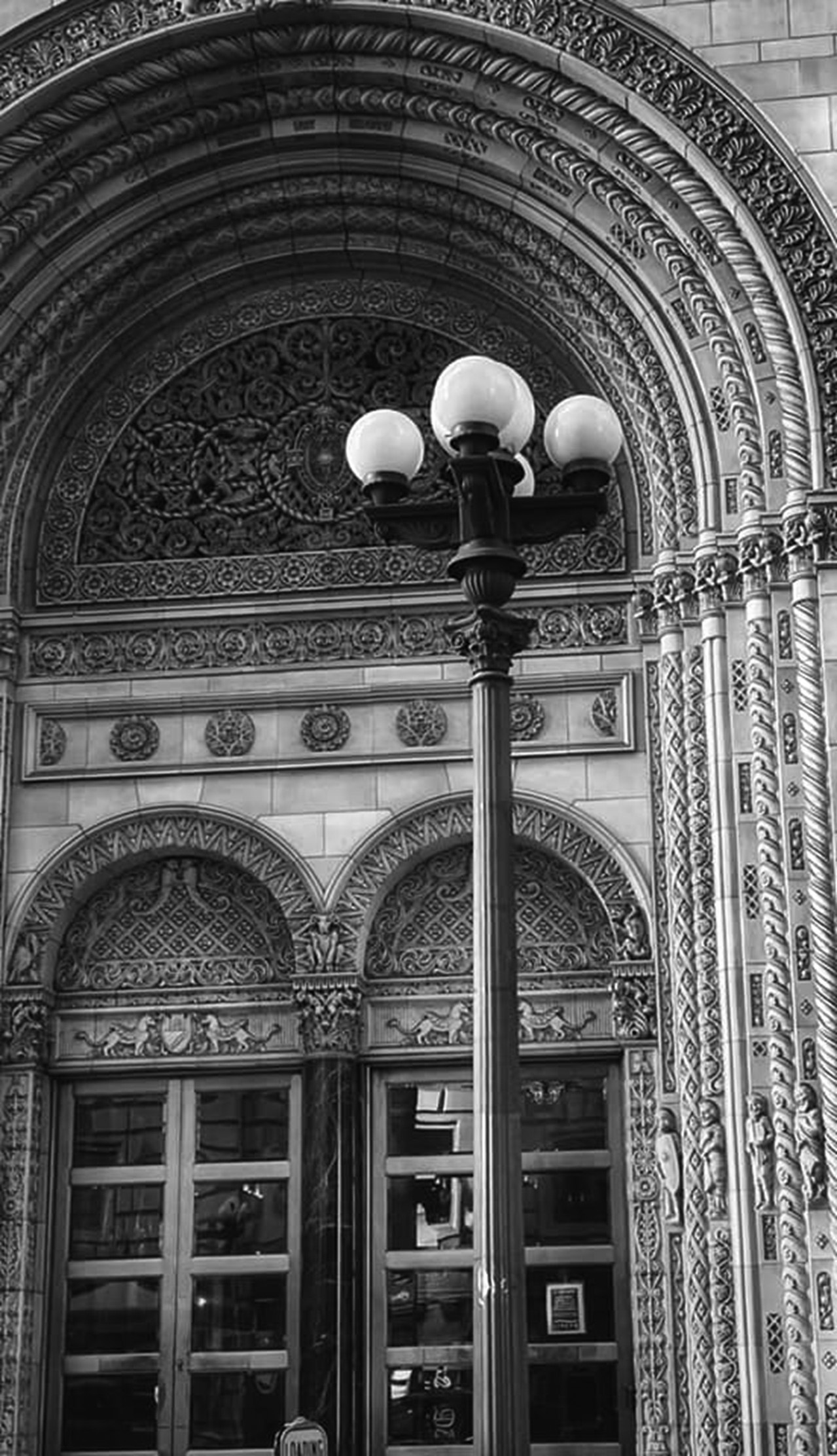 |
|
| (2021)* - Close-up contemporary view showing an ornate 5-lamp streetlight standing in front of an even more ornate Fine Arts Building, 811 W. 7th Street. Photo by Carlos G. Lucero |
* * * * * |
Union Station
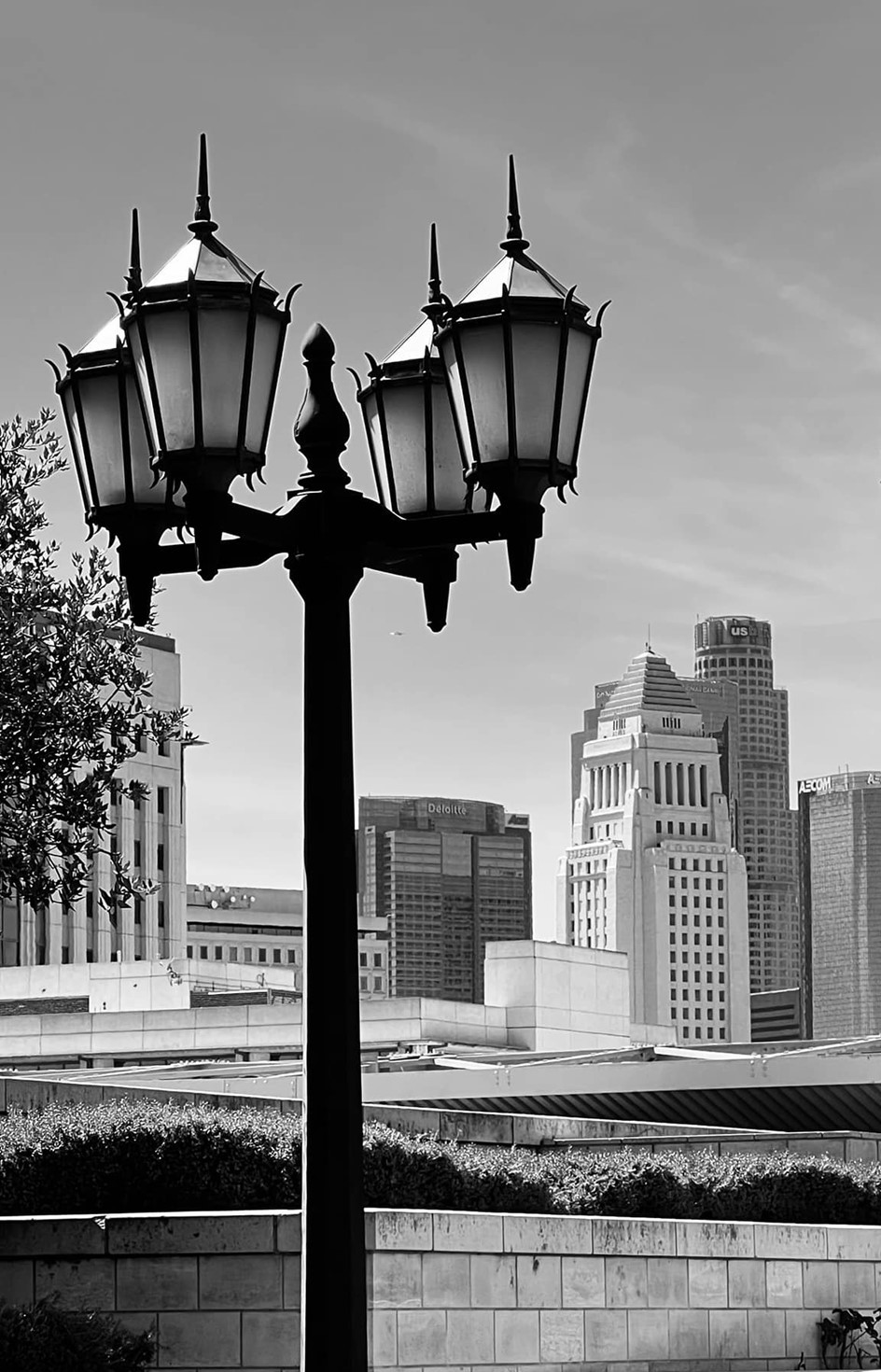 |
|
| (2023)* - View looking south from Union Station towards downtown LA showing a 4-lamp ornate streetlight. Photo by Carlos G. Lucero |
* * * * * |
Vermonica Streetlight Exhibit (Original Location)
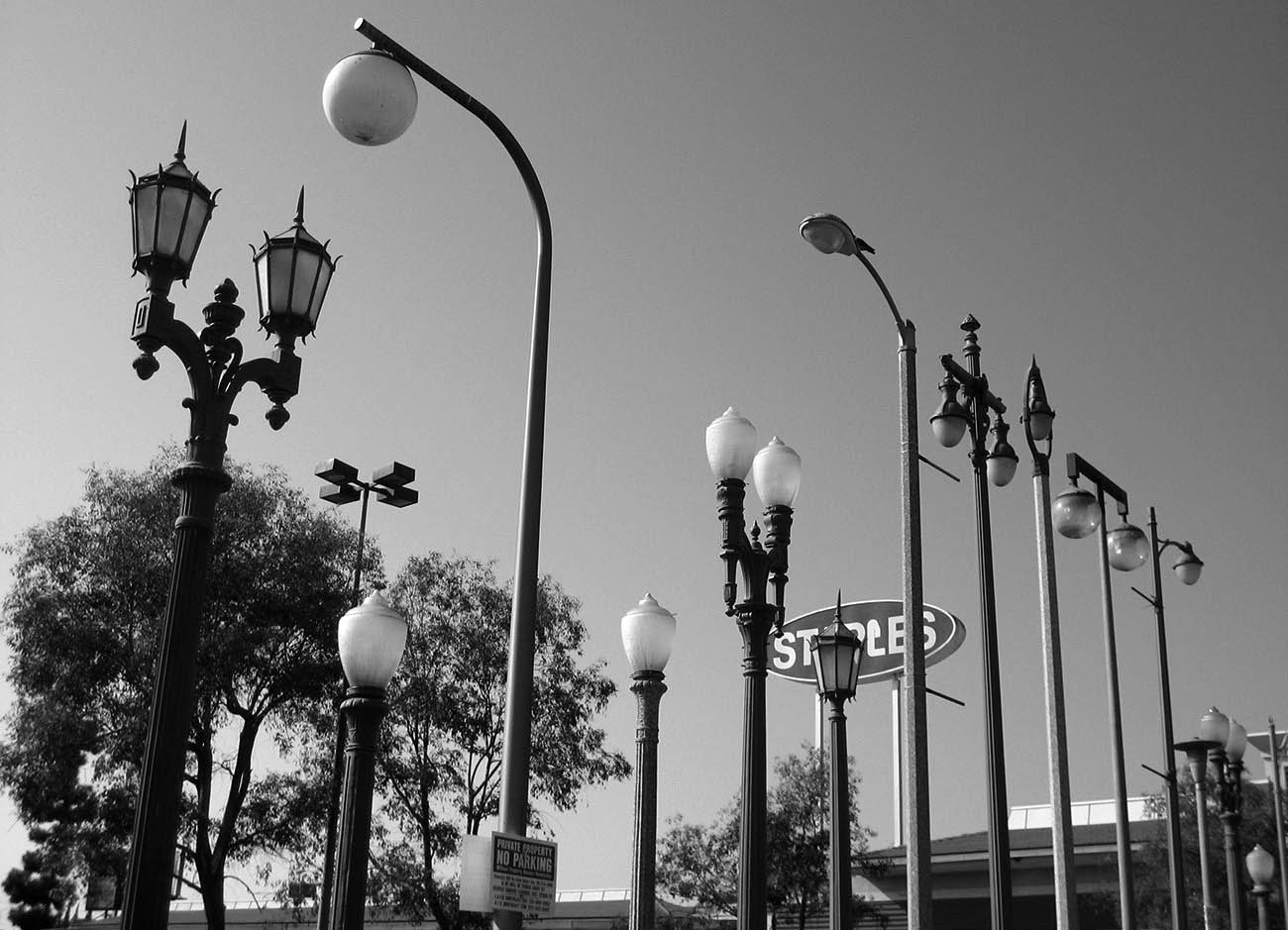 |
|
| (ca. 2010s)^ - The Vermonica Streetlight Exhibit at its first location in the parking lot of a strip mall at the intersection of Santa Monica Boulevard and Vermont Avenue in East Hollywood. Photo courtesy of Sheila Klein / Vermonica |
Historical Notes In 1993, artist Sheila Klein created a sculptural installation out of 25 vintage light poles in the median of a run-of-the-mill strip mall at the intersection of Santa Monica Boulevard and Vermont Avenue in East Hollywood. The piece, titled “Vermonica,” was crafted as a gesture of healing: an illuminating monument to mark a site that had gone up in flames during the 1992 Los Angeles riots. Controversy, naturally, ensued. Part of the problem stemmed from the fact that “Vermonica” occupied a legal gray area: The bureau had supplied the light poles and Klein had made the work with a small grant from the Department of Cultural Affairs, but the sculpture stood on private property and had never been formally acquired by the city of L.A. Fast-forward 24 years to November 2017, when the sculpture was mysteriously removed by the Bureau of Street Lighting without notice. It then materialized in a reconfigured state before the bureau’s headquarters a block to the east. The strip mall owner had asked for the piece to be removed to accommodate some construction. But engineers for the bureau had failed to notify Klein or the Department of Cultural Affairs.* |
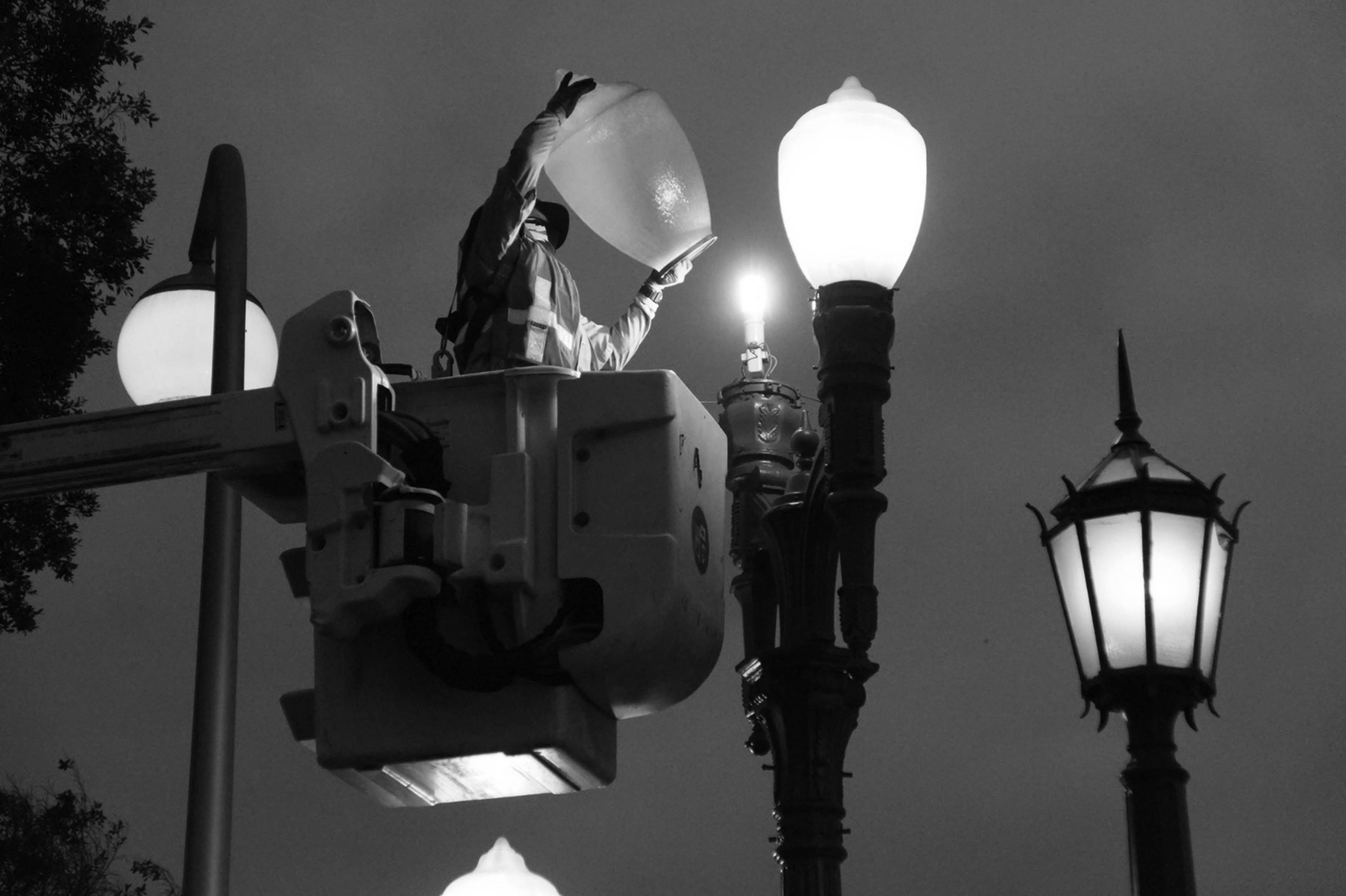 |
|
| (2020)* - LA Bureau of Streetlight worker replacing globe after changing the bulb. The twin streetlight is a Westinghouse-Llewellyn "California Special" a.k.a. "The Magnolia Double." Photo by Glen Norman |
Historical Notes The above photo was taken on 10-23-20 at the LABSL Field Operations Division on Santa Monica Blvd. Within a week of this shot, the poles were moved to the reconstituted "Vermonica" to the West. |
Vermonica Streetlight Exhibit (Current Location)
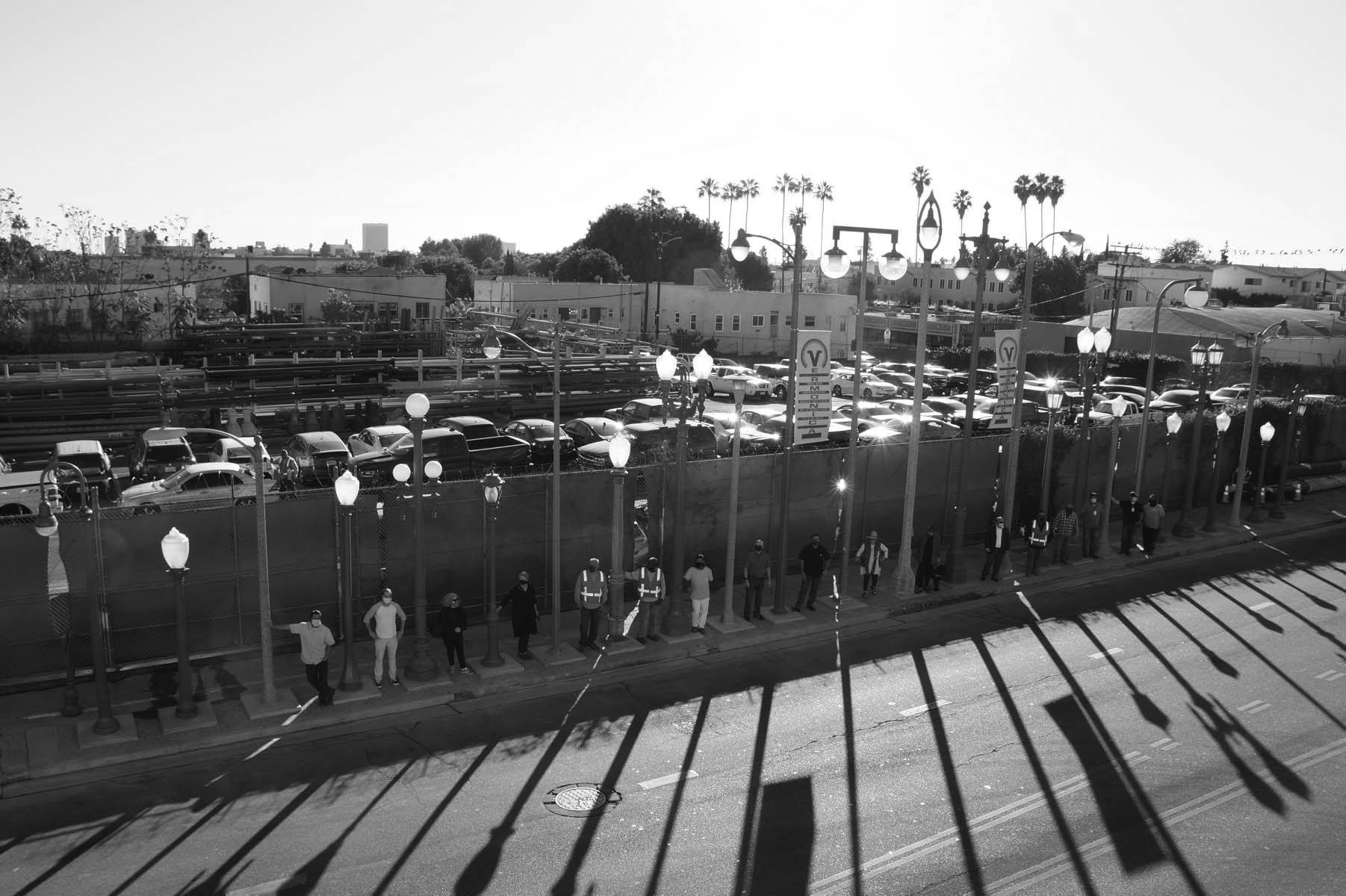 |
|
| (2020)* – Official opening ceremony of the “New” Veronica streetlight art exhibit located on Santa Monica Boulevard at Lyman Place. Sheila Klein is standing between the Little Tokyo light and the Lankershim Harp. Also present are representatives from LABSL, LA Department of Cultural Affairs, and other dignitaries. Photo by Glen Norman |
Historical Notes Vermonica is a public art installation initiated by artist Sheila Klein in May 1993, uninstalled in November 2017 and reinstalled in a new location in December 2020. Vermonica is now located on Santa Monica Boulevard at Lyman Place, opposite the Cahuenga Branch Library. The sculpture is named for the intersection of Santa Monica Boulevard and Vermont Avenue in East Hollywood. Some of the artwork's 25 lamp poles date to 1925, the year Los Angeles's Bureau of Street Lighting opened. Placed in front of a Rite-Aid, the lights glow to illuminate the mini-mall parking lot where it was located at specific times during the night. Sheila Klein cooperated with Los Angeles businesses, bureaus, departments and neighborhoods to erect what she describes as a "formal composition" and a "drive-in museum" of street lighting. Vermonica was envisioned initially as a temporary installation with borrowed poles from the nearby streetlight yard on Santa Monica Boulevard. The sculpture was so popular that it remained in place. Vermonica precedes Chris Burden's Urban Light by 15 years.* |
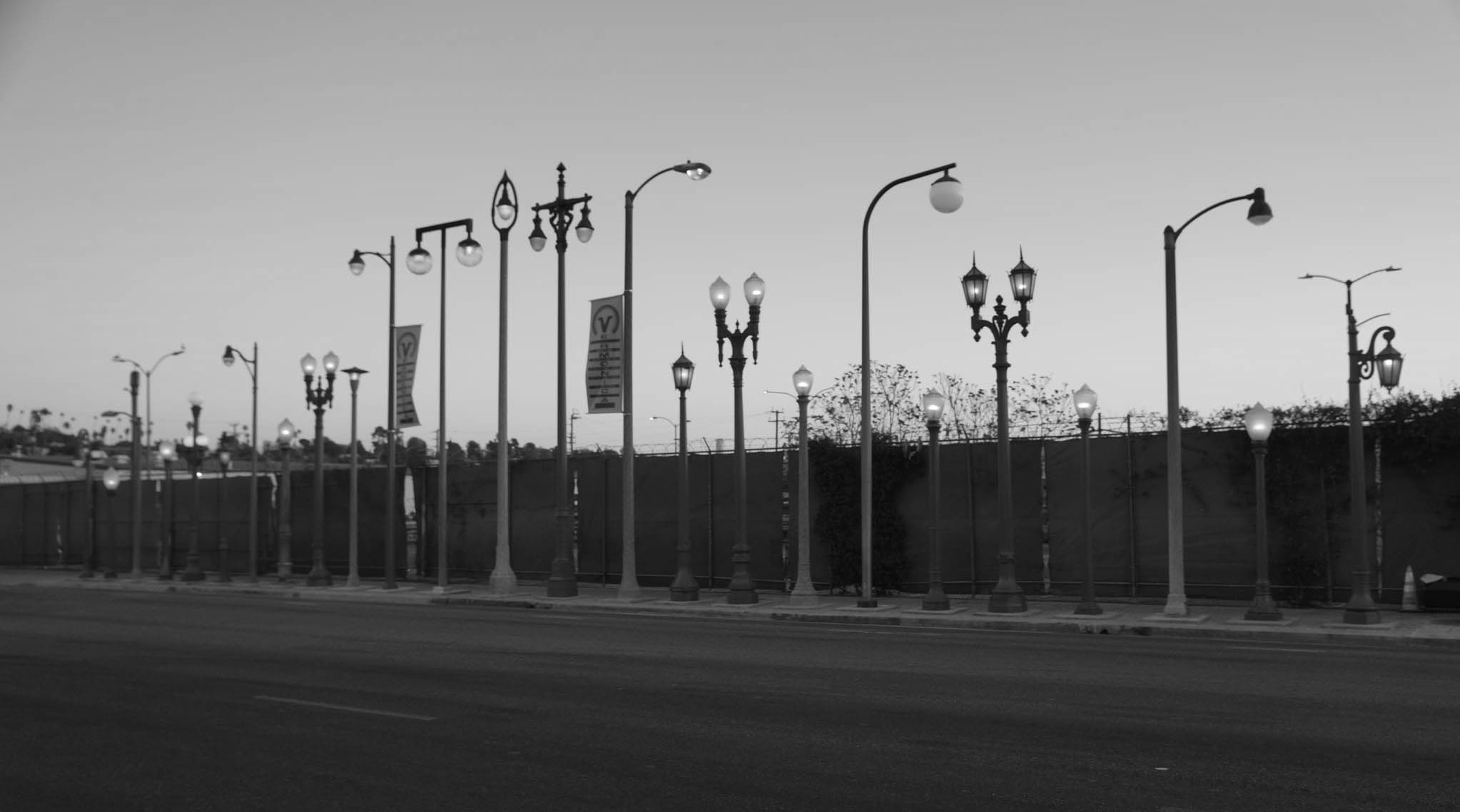 |
|
| (2020)* – Dusk view showing the Vermonica exhibit on Santa Monica Boulevard which includes 25 historic lamp poles some of which date back to 1925. Photo by Glen Norman |
Historical Notes On November 21, 2017, artist Sheila Klein was informed by a member of the public that her artwork had been removed without her knowledge. The elements of the work had been moved to the front lawn of the Bureau of Street Lighting, and reinstalled in a curved line. In a statement, Sheila Klein announced that the reinstalled work is not Vermonica. An assistant director with the Bureau of Street Lighting said the move is not permanent and was necessitated by construction work in the parking lot where the sculpture was originally located. "Our sense of urgency was to protect and preserve the streetlights so that they wouldn't be damaged or removed by someone other than us," Assistant Director Megan Hackney told The Los Angeles Times. On June 6, 2019, artist Sheila Klein launched a petition seeking restoration of Vermonica in light of newly discovered emails from Bureau of Street Lighting staff that show that BSL intentionally dismantled Vermonica to create a new city staff designed work they called "Vermonica". On January 1, 2020, artist Sheila Klein announced on Instagram that an agreement had been reached with the City of Los Angeles for her to restore Vermonica. The newly reinstalled sculpture was completed and re-lit by the artist on December 1, 2020.* |
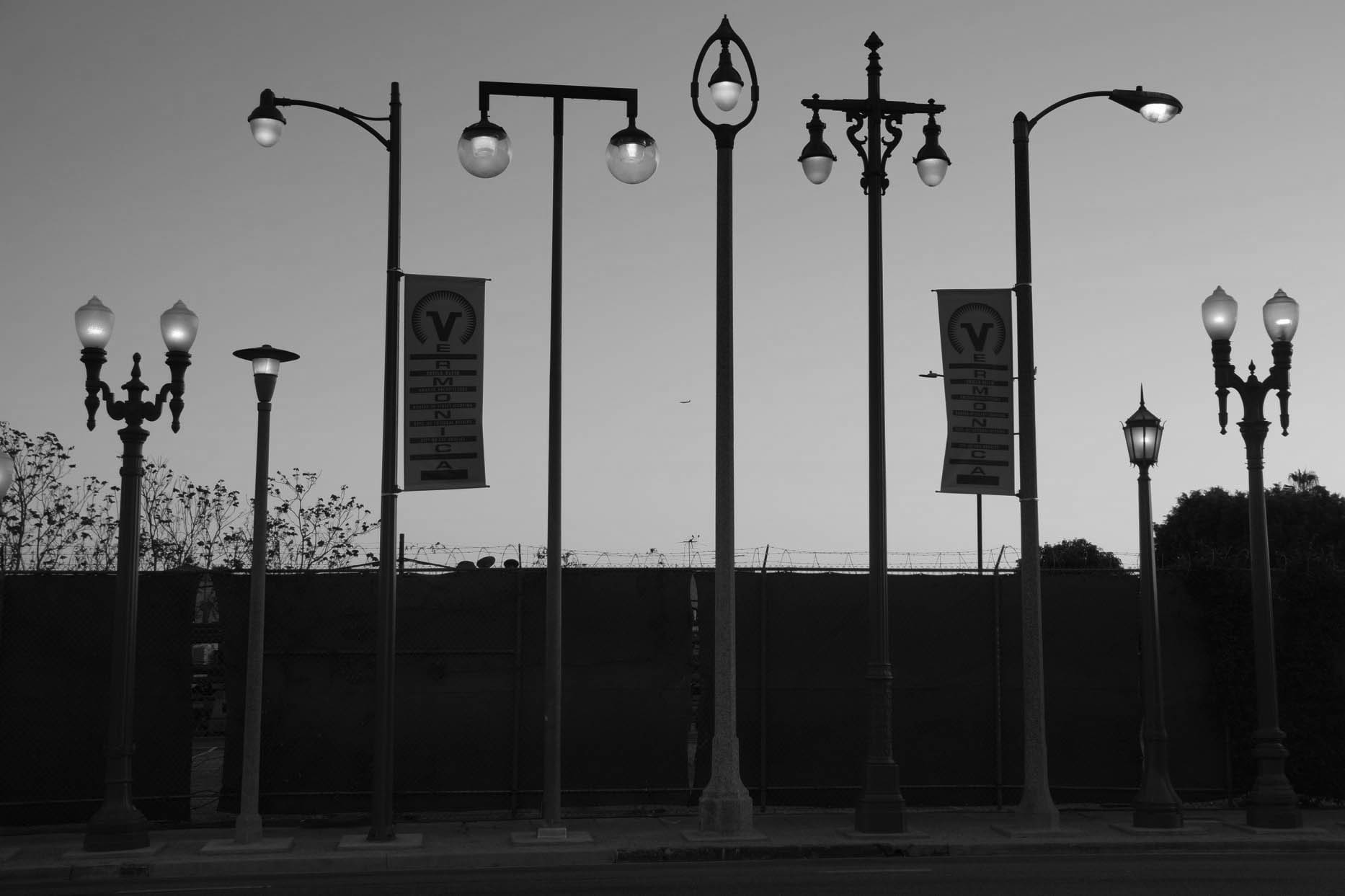 |
|
| (2020)* - Vermonica Exhibit at dusk showing “The Big 5” - Double post-top, single post-top, single overhead, and double overhead. Then reversed to the right of the Lankershim Harp. Photo by Glen Norman |
Historical Notes VERMONICA is named for the intersection where it was originally located, Vermont Avenue and Santa Monica Boulevard. Currently located at 4582 Santa Monica Boulevard at Lyman Place, it is an Urban Candelabra. The installation, which is 120' long and 30' tall, is made of a selection of 25 streetlights from the City of Los Angeles. Some of the streetlights are current, others are rare examples of obsolete poles from the city's past. These 25 poles represent the diversity of the over 400 types currently in use in Los Angeles. The range of materials, styles and historical periods displayed in Vermonica hopes to encourage people to notice the variety and sculptural nature of the street lights they see every day, and to appreciate the efforts of the Bureau of Street Lighting. Vermonica was conceived and executed by artist Sheila Klein. She incorporates the intimate domestic scale of candlesticks into an Urban Candelabra for the household of the street. Vermonica seeks to uncover romantic truths about the city. By accenting one overlooked layer of our environment, Klein encourages further consideration of all our urban layers.^ |
* * * * * |
Urban Light - Los Angeles County Museum of Art (LACMA)
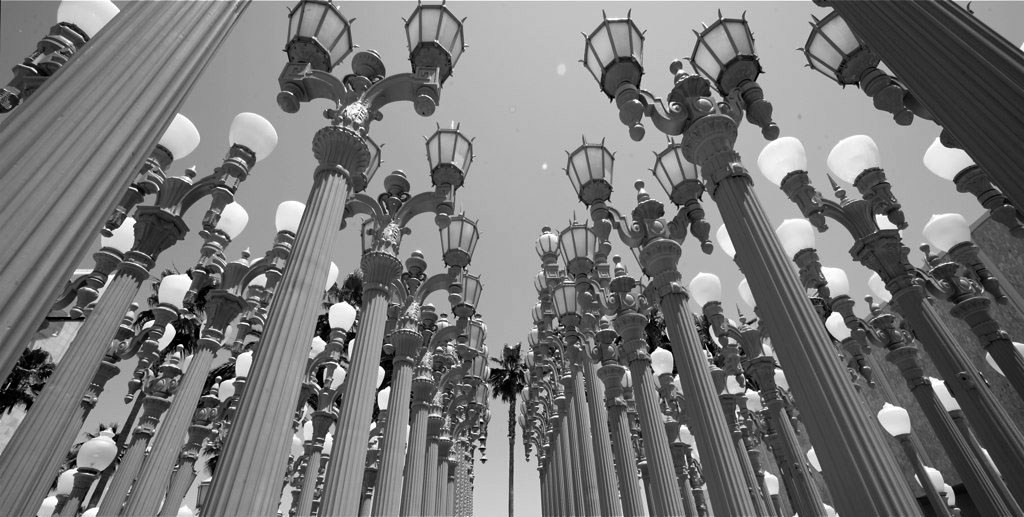 |
|
| (2011)* - Urban Light by Chris Burden located in front of LACMA, 5095 Wilshire Boulevard. Photo courtesy of 'tripod2011' / flickr |
Historical Notes Chris Burden's "Urban Light" installed on the sidewalk in front of LACMA has been one of LA's favorite and most photographed landmarks since its unveiling in February 2008. The piece incorporates 202 antique street lights from cities and neighborhoods in and around Los Angeles. Urban Light is composed of 202 street lamps arranged in a near grid. The lamps mostly came from the streets of Southern California, including Hollywood, Glendale, and Anaheim, with some from Portland, Oregon. There are 16 different streetlight models represented, many of which were commissioned for particular neighborhoods and streets.* |
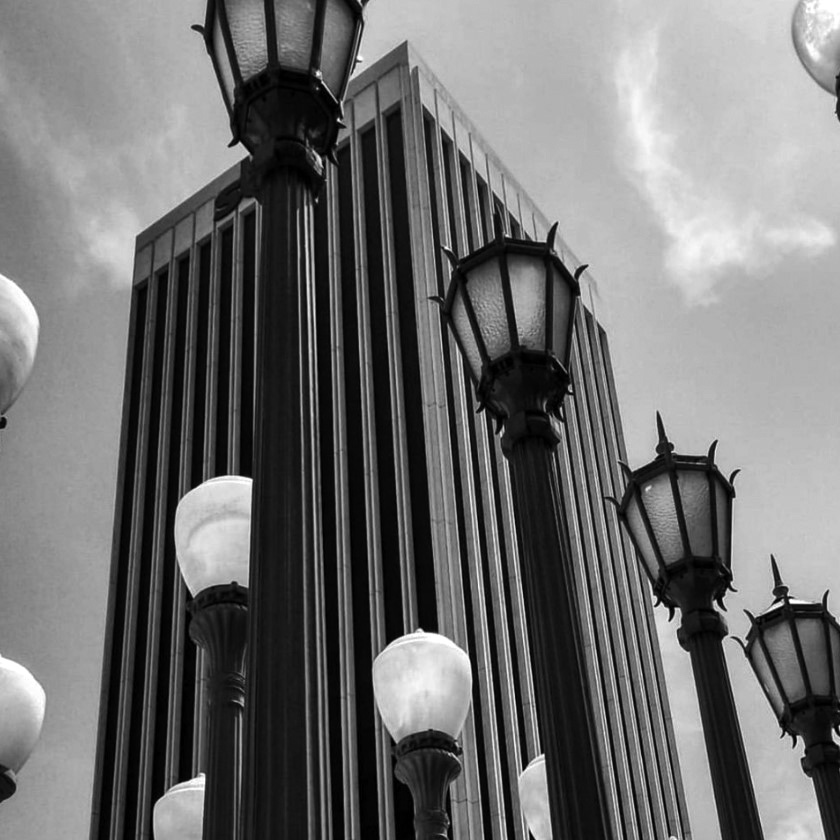 |
|
| (2019)^.^ - Close-up view looking up through the ‘Urban Light’ sculputre toward the 5900 Wilshire, 32-story SBE Building. Photo courtesy of Aurora Ruvalcaba |
Historical Notes The sculpture's glass globes are of three general shapes: round, acorn, and cone. The 309 LED bulbs are solar powered and switch on from dusk until dawn, governed by an astronomical timer.* |
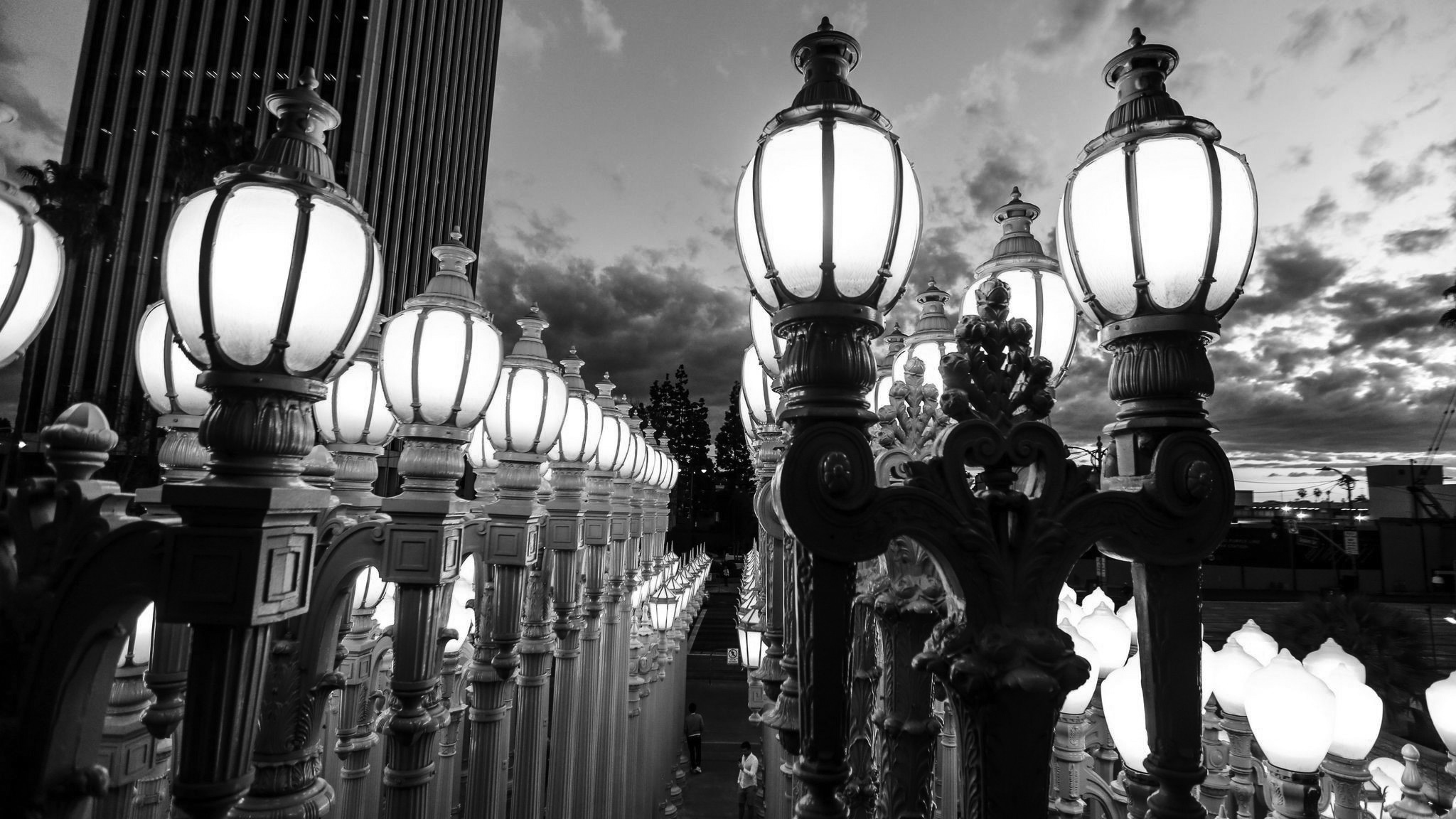 |
|
| (2018)^^ - The Broadway Roses is the artist's favorite work, standing 26 feet tall and the tallest of the "Urban Light." Maria Alejandra Cardona / Los Angeles Times |
Historical Notes The Broadway Rose, the largest and most ornate of the models, is represented by six lamps. The style was found in downtown Los Angeles; a few can still be seen on Sixth Avenue between Olive and Flower Streets. |
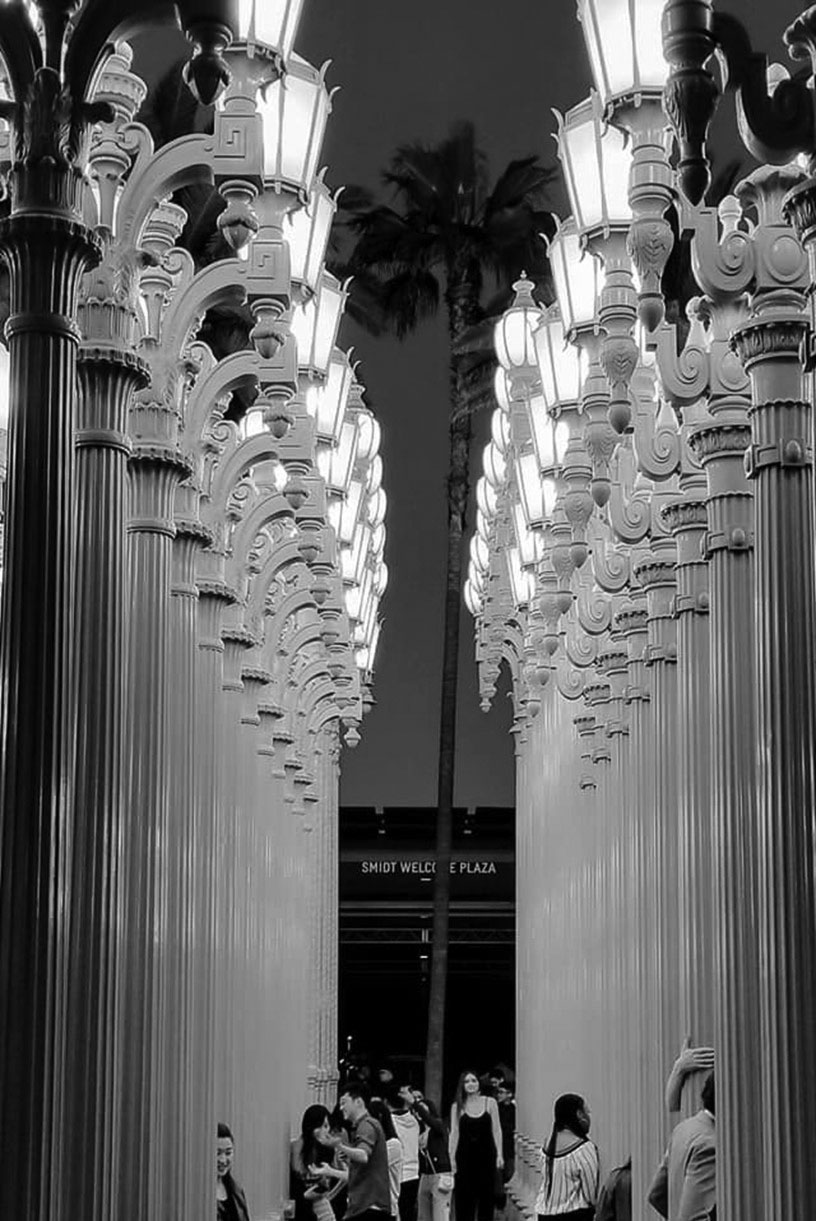 |
|
| (2021)* - Urban Light – A joy to walk through. Photo courtesy of Paul Wright |
Historical Notes Los Angeles Times critic Christopher Hawthorne described Urban Light as "a kind of pop temple, deftly straddling the lines between art and architecture and between seriousness and irony. It's also a joy to walk through, but there's no getting around the fact that it turns what might have been an actual public square along Wilshire—a space defined from day to day by the people using it—into an outdoor room for one sizable and very insistent piece of art." |
* * * * * |
Please Support Our CauseWater and Power Associates, Inc. is a non-profit, public service organization dedicated to preserving historical records and photos. Your generosity allows us to continue to disseminate knowledge of the rich and diverse multicultural history of the greater Los Angeles area; to serve as a resource of historical information; and to assist in the preservation of the city's historic records.
|
More Historical Early Views
Newest Additions
Early LA Buildings and City Views
History of Water and Electricity in Los Angeles
* * * * * |
References and Credits
* DWP - LA Public Library Image Archive
^ LA Public Library Image Archive
^^Bureau of Street Lighting Image Archive
#*Library of Congress: 4th and Lorena Street Bridge Light
#^San Fernando Valley History Digital Library - CSUN Oviatt
#+Facebook.com: Classic Hollywood/Los Angeles/SFV
***Huntington Digital Library Archive
*^^Nuestra Señora la Reina de los Ángeles - losangelespast.com
^^*Noirish Los Angeles - forum.skyscraperpage.com; Windsor-Wilshire
^^^California State Library Image Archive
^**Vintage Los Angeles: Trocadero Nightclub ; Hollywood and Vine
*^*Photo Ramblings - Garth Buckles
^*^Mail Online - Daily Mail Reporter
^#^LA Times: Amestory Building
*#*Flicker: smgerdes - 4th Street Bridge Lights
*#^LAPL-El Pueblo de Los Angeles Historical Monument Photo Archive
^#*Facebook.com - Los Angeles Theatres: Warner Bros. Downtown
**#San Fernando Valley Relics - Facebook.com: Van Nuys Blvd., Ca. 1940
^^#Flickr.com: Michael Ryerson
*^#Facebook.com - Bizarre Los Angeles
^*#California State Library Image Archive
*##Facebook.com: Garden of Allah Novels – Martin Turnbull
^##Boyle Heights History Blog: Introduction of Electric Light to Boyle Heights
+##MartinTurnbull.com: Fairfax and Wilshire
#*^Facebook.com - San Pedro's Original Website, San Pedro.com
#^*Facebook.com: West San Fernando Valley Then And Now
^* Wikipedia: Los Angeles Country Art Museum; Hollywood Playhouse (Avalon Hollywood); MacArthur Park
< Back
Menu
- Home
- Mission
- Museum
- Major Efforts
- Recent Newsletters
- Historical Op Ed Pieces
- Board Officers and Directors
- Mulholland/McCarthy Service Awards
- Positions on Owens Valley and the City of Los Angeles Issues
- Legislative Positions on
Water Issues
- Legislative Positions on
Energy Issues
- Membership
- Contact Us
- Search Index